



LUXURY & LIFESTYLE MAGAZINE 13th YEAR SPRING 2O24

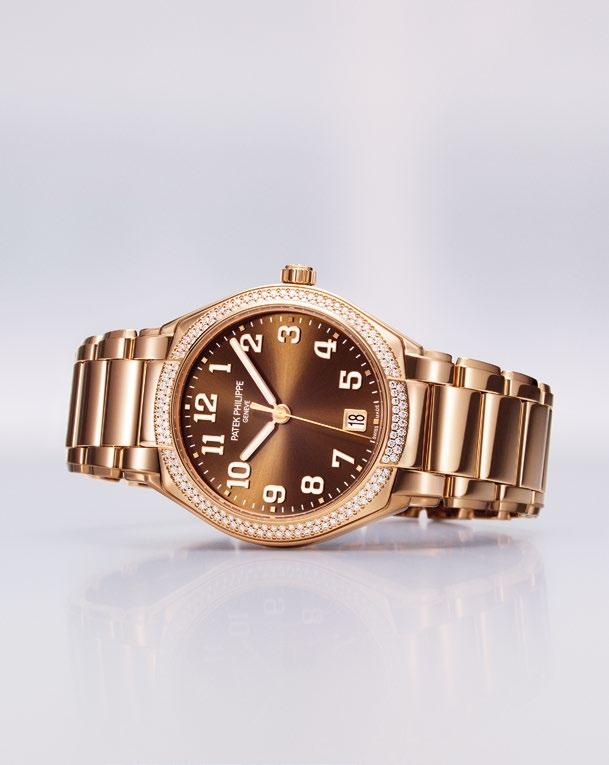
Giornate lunghe, fiori in festa e voglia di scoprire e lasciarsi conquistare dalle mille curiosità di una Riviera che nella bella stagione offre il suo volto più fresco e profumato. Partiamo dove il sole sboccia già a febbraio: il teatro Ariston di Sanremo. Con un’edizione da record appena terminata, il Festival della canzone italiana porta con sé musica, voglia di leggerezza e anche un interessante viaggio nella storia del teatro più famoso d’Italia. Lo abbiamo scoperto insieme a Luca Ammirati e Walter Vacchino, autori di “ARISTON. La scatola magica di Sanremo”. Una scatola dove si fabbricano canzoni e successi tra parole, dialetti e personaggi davvero insoliti. Tra questi, uno dei più celebrati presentatori di sempre, Mike Bongiorno, di cui si celebra in questo 2024 il centenario. Con la sua celebre “Allegria!”, anche Mike sembra omaggiare una terra ricca di posti speciali. Alcuni di questi, da Villa Grock a Imperia al Forte dell’Annunziata di Ventimiglia, toccando Bordighera con i suoi luoghi esotici e le affascinanti piante, sono perfetti per dichiararsi amore eterno. Ma non andiamo solo a zonzo per Sanremo, tra le sue pagine storiche dedicate allo spettacolo, una lavanda speciale dedicata al Festival più famoso d’Italia e il progetto del futuro lungomare. Ci spostiamo sulle spericolate discese per mountain bike a Limone Piemonte, e sconfiniamo nella vicina Francia in cerca di artisti e delle loro affascinanti opere. Renoir e Jean Cocteau sono i protagonisti di due focus che dedichiamo a Cagnes-sur-Mer, dove si trova la casa del primo, e a Mentone, dove visitare un museo dedicato al secondo. Biografia, paesaggio e arte si intrecciano in storie suggestive in Riviera. Sapevate che l’Osservatorio Meteorologico e Sismico di Imperia ospitò ben tre Premi Nobel? Questa e altre magie sono pronte a sbocciare nelle pagine del nuovo numero del nostro magazine: iniziamo il viaggio!
ditoriale
Long sunny days, festive flowers and the desire to explore and be captivated by the countless wonders of the Riviera, which reveals its most invigorating and aromatic fragrance during the warmer months. Our journey begins where the sun shines bright even in February: the Ariston Theatre in Sanremo. Fresh off a recordbreaking edition, the Italian Song Festival brings not just music but also a desire for fun and an intriguing journey through the history of Italy’s most famous theatre. We explored it alongside Luca Ammirati and Walter Vacchino, the authors of “ARISTON The Magical Box of Sanremo,” a treasure trove where songs and hits are crafted from words, dialects and truly unique characters. Among them is Mike Bongiorno, one of the most beloved presenters of all time, whose centenary is being celebrated in 2024. With his trademark greeting, Allegria! (“Cheers!,” “Joy!”), Mike also appears to pay homage to a land brimming with unique places. Some of these, like Villa Grock in Imperia, Forte dell’Annunziata in Ventimiglia and Bordighera, with its exotic locations and fascinating plants, are perfect for declaring everlasting love.
But our exploration doesn’t stop at Sanremo’s historical pages dedicated to entertainment, a special lavender dedicated to Italy’s most famous festival and the plans for a future promenade.
We also embark on daring mountain bike adventures in Limone Piemonte and venture into neighbouring France to discover artists and their fascinating works. Renoir and Jean Cocteau are the protagonists of two feature articles dedicated to Cagnessur-Mer, where Renoir’s home is located, and Mentone, where we visit a museum dedicated to Cocteau. Riveting stories about the Riviera blend biography, landscape and art. Did you know that the Meteorological and Seismic Observatory of Imperia hosted no less than three Nobel Prize Winners? These enchanting narratives and more await you in the pages of the latest issue of our magazine: let’s begin the journey!
De longues journées, des fleurs en fête, l'envie de découvrir et de se laisser conquérir par les milliers de curiosités d'une Riviera qui offre, dès les beaux jours, son visage le plus frais et le plus parfumé. Nous commençons là où le soleil rayonne déjà en février : le théâtre Ariston de Sanremo. Avec une édition record qui vient de s'achever, le Festival de la chanson italienne porte en lui la musique, la bonne humeur et un voyage intéressant à travers l'histoire du théâtre le plus célèbre d'Italie. Nous l'avons découvert avec Luca Ammirati et Walter Vacchino, les auteurs de Ariston. La scatola magica di Sanremo (ARISTON La boîte magique de Sanremo). Une boîte où les chansons et les succès se font au travers de mots, de dialectes et de personnages des plus insolites. Parmi eux, un des plus célèbres présentateurs de tous les temps, Mike Bongiorno, dont le centenaire est célébré dans cette édition 2024. Avec sa fameuse « Allegria! », l’allégresse, Mike semble aussi rendre hommage à une terre pleine de lieux particuliers. Certains d'entre eux, de la Villa Grock à Imperia au Forte dell'Annunziata à Vintimille, en passant par Bordighera avec ses lieux exotiques et ses plantes fascinantes, sont parfaits pour déclarer l'amour éternel. Mais nous n'allons pas seulement nous balader à Sanremo, au milieu des pages historiques consacrées aux spectacles, d'une lavande spéciale dédiée au festival le plus célèbre d'Italie et du dessin de la future promenade du bord de mer. Nous nous lançons dans des descentes téméraires en VTT à Limone Piemonte et traversons la France voisine à la recherche d'artistes et de leurs œuvres fascinantes. Renoir et Jean Cocteau sont les protagonistes de deux volets que nous consacrons à Cagnes-sur-Mer, où se trouve la maison du premier, et à Menton, où nous visitons un musée consacré au second.
Biographie, paysage et art s'entremêlent dans des histoires suggestives sur la Riviera. Saviez-vous que l'Observatoire météorologique et sismique d'Imperia a accueilli pas moins de trois prix Nobel ?
Cette magie et bien d'autres encore sont prêtes à prendre vie dans les pages du nouveau numéro de notre magazine : commençons le voyage !

2 SANREMO IT
Alessandra Chiappori

GIORNATE LUNGHE, FIORI IN FESTA E VOGLIA DI SCOPRIRE
Primavera al Royal Hotel Sanremo
UN'ESPERIENZA RICCA DI FASCINO, PROFUMI E COLORI
La scatola magica dell'Ariston
NEL LIBRO DI WALTER VACCHINO E LUCA AMMIRATI
Gli autori questi conosciuti
LE CANZONI DEL FESTIVAL DI SANREMO 2024
Il dialetto al Festival di Sanremo
UNA SFIDA LINGUISTICA SEMPRE ATTUALE
L'amore
AL TEMPO DEL FESTIVAL DI SANREMO
Massimo Morini
IL RECORDMAN AL FESTIVAL DI SANREMO
NYCANTA 2024
QUANDO LA MUSICA ITALIANA ILLUMINA NEW YORK
Mike e il Festival
UN DUETTO CHE HA FATTO STORIA
Un mare color lavanda
DIECI ANNI DI "LAVANDA DELLA RIVIERA DEI FIORI"
Villa Ormond in Fiore
TORNA A SANREMO IL 27 E 28 APRILE
Riviera Food Festival 2024
L'EVENTO IMPERDIBILE PER GLI AMANTI DEL GUSTO E DELLE EMOZIONI
Tutti in sella
LIMONE A DUE RUOTE
Il nuovo lungomare di Sanremo
UNA PASSEGGIATA NEL FUTURO
A casa di Renoir
CAGNES-SUR-MER LA MONTMARTRE DELLA COSTA AZZURRA
Il Museo Jean Cocteau a Mentone
“JE RESTE AVEC VOUS”
Giuseppe Biancheri
L’INVENZIONE DELLA FERROVIA DELLE MERAVIGLIE
Dai tre Nobel al clima che cambia
SCOPRENDO L’OSSERVATORIO DI IMPERIA
Luoghi suggestivi della Riviera
PER I MATRIMONI CIVILI
Il Palafiori DI SANREMO
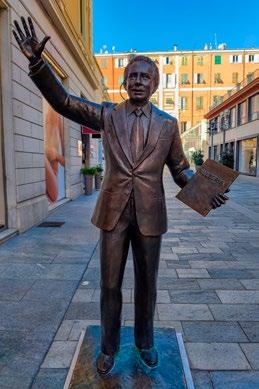
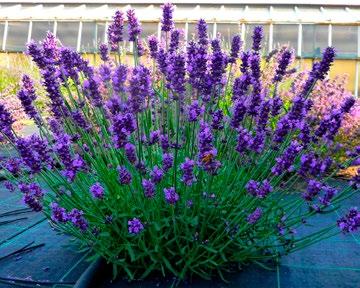
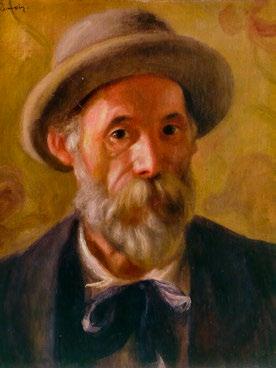

2 8 10 14 20 24 28 34 38 42 48 52 56 62 66 70 76 80 84 88 92 Editoriale
Contents
Palloncino, scultura misteriosa VHERNIER
4 SANREMO IT


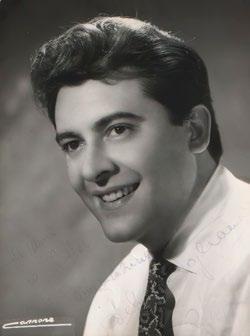



Testata registrata presso il Tribunale di Sanremo
Iscrizione nel Registro Giornali e Periodici n°8 del 08-08-2012
Periodicità: trimestrale
Luogo di pubblicazione: Bordighera, Via F.lli Biancheri, 1
Editore: Innovation Media sas Via F.lli Biancheri, 1 - Bordighera - Italy info@innovationmedia.it info@sanremo.it
Direttore Editoriale, Commerciale e Multimedia & IT:
Luca Giovannetti
+39 334 18 32 828
luca.giovannetti@sanremo.it
Direttore responsabile: Alessandra Chiappori
Redattori:
Anna Maria Castellana
Simona Cappelli
Alessandra Chiappori
Emanuela Dho
Luca Giovannetti
Flaminio Spinetti
Progetto grafico: Kreameta di Paolo Pinto kreameta.com - info@kreameta.com
Traduzioni:
GLocal Media | IH Tem Lingue (EN/FR)
Foto:
Dove non specificato ©Depositphotos.com, ©Wikipedia, ©Redazione
Foto di copertina:
Villa Ormond Sanremo
©Luca Giovannetti
Stampa:
Tipolitoeuropa s.n.c.
Via degli Artigiani, 17
12100 Cuneo CN
Sanremo S it ®
© n° 0001268952
N° iscrizione ROC: 22738
WWW.SANREMO.IT

5 SANREMO IT


 SANREMO - ALASSIO - PORTOFINO - SANTA MARGHERITA LIGURE
SANREMO - ALASSIO - PORTOFINO - SANTA MARGHERITA LIGURE


PALLONCINO SCULTURA MISTERIOSA
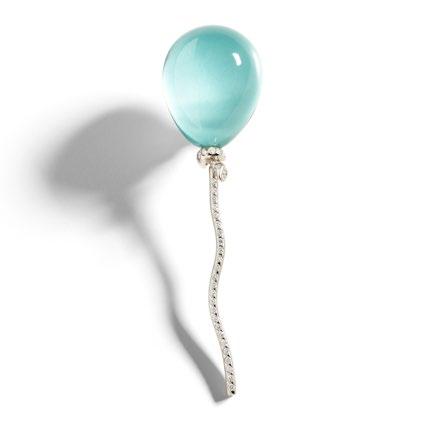
Vhernier interpreta la gioielleria come nessun altro e i suoi gioielli non sono mai immediati: c’è sempre qualcosa da scoprire o per cui rimanere stupiti. È quello che accade con le Trasparenze, una delle tecniche più emblematiche della casa attraverso la quale Vhernier crea uno straordinario effetto cromatico grazie all’abile sovrapposizione di perfetti volumi di cristallo di rocca, madreperla e pietre dai colori brillanti.
Visto dall’alto, il colore della pietra principale traspare in infinite sfumature
che regalano effetti visivi inattesi, mentre la vista di profilo rivela la trasparenza del cristallo.
Le Trasparenze sono le protagoniste di molte collezioni, tra cui la storica collezione Palloncino, che porta un tocco di estro e leggerezza al mondo Vhernier.
Le pietre sovrapposte che si fondono in un unico elemento con l’oro sono un prodigio di artigianalità. Il Palloncino è disponibile in vari colori: lapis, madreperla bianca, corniola, turchese o giada.
Per moltiplicare il fattore chic, perché non indossarne due in colori diversi?
Il mono-orecchino, lanciato nel 1995, è uno dei pezzi più iconici e gioiosi di Vhernier. Negli ultimi anni la collezione è stata ampliata con anelli, pendenti e bracciali.
Con i loro colori vivaci, i volumi scultorei e le forme ergonomiche, sono gioielli da indossare tutti i giorni.
Un gioiello multi-occasionale - parola chiave dello stile contemporaneo - e dalla portabilità facile.
Come sempre, come per gli altri gioielli della stessa collezione, sono belli da soli ma indossati in coppia creano un meraviglioso effetto colore.
8 SANREMO IT
MONO ORECCHINO PALLONCINO IN ORO BIANCO, DIAMANTI, TURCHESE E CRISTALLO DI ROCCA.
of rock crystal, mother-of-pearl and brightly coloured gemstones. When viewed from above, the colour of the main stone
two different colours?

The single earring, introduced in 1995, stands as one of Vhernier’s most iconic and exuberant pieces. In recent years, the collection has grown to encompass rings, pendants and bracelets. Featuring vibrant hues, sculptural volumes and ergonomic shapes, these pieces are meant to be worn
Multi-occasion – a keyword in contemporary style – epitomizes Vhernier’s approach to easy-to-wear jewellery. Like other pieces in the same collection, each item shines individually, yet when paired together, they
Corso Imperatrice, 3 - Sanremo Via Matteotti, 39 - Sanremo
dans des nuances infinies qui offrent des effets visuels inattendus, tandis qu'une vue de profil révèle la transparence du cristal. Les Trasparenze tiennent la vedette dans de nombreuses collections, dont l'historique collection Palloncino, qui apporte une touche de fantaisie et de légèreté à l'univers
Les pierres superposées qui se fondent en un seul élément avec l'or sont un prodige de
Le Palloncino est disponible en différentes couleurs : lapis, nacre blanche, cornaline,
Pour multiplier le facteur chic, pourquoi ne pas en porter deux de couleurs différentes ? La boucle d'oreille unique, lancée en 1995, est une des pièces les plus emblématiques et les plus joyeuses de Vhernier. Au fil des ans, la collection s'est enrichie de bagues, de pendentifs et de bracelets. Couleurs vives, volumes sculpturaux et formes ergonomiques : des bijoux à porter tous les jours.
Un bijou multi-occasion - mot clé du style contemporain - et facile à porter. Comme toujours, comme pour les autres bijoux de la même collection, ils sont beaux seuls, mais portés en paire, ils créent un merveilleux effet de couleur.

PALLONCINO
ANELLO PALLONCINO IN ORO BIANCO, DIAMANTI, MADREPERLA BIANCA E CRISTALLO DI ROCCA
www.abate1920.it
PENDENTE PALLONCINO IN ORO BIANCO, DIAMANTI, GIADA E CRISTALLO DI ROCCA.
9 SANREMO IT
Primavera aL Royal Hotel Sanremo
un'Esperienza ricca di fascino, profumi e colori


10 SANREMO IT
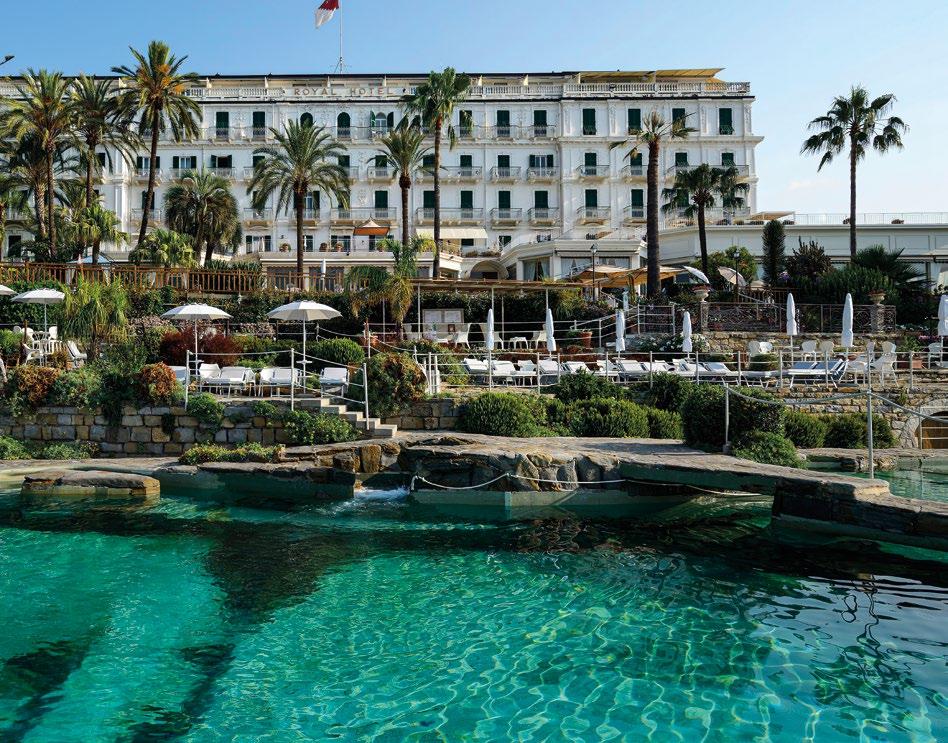
Il prestigioso Royal Hotel Sanremo, icona di lusso e raffinatezza fin dal 1872, riapre le porte dopo accurati lavori di ristrutturazione che hanno coinvolto diverse aree della struttura, tra le quali la terrazza solarium della scenografica piscina d’acqua di mare riscaldata a 27°C, disegnata da Gio Ponti, e che ora, completamente rinnovata, è pronta ad accogliere gli ospiti che potranno anche godere di una vista mozzafiato sul Mar Ligure.
Con l'arrivo della primavera la Riviera dei Fiori si ammanta di un tripudio di colori, come il lussureggiante parco subtropicale di 16.000 metri quadri che avvolge il Royal Hotel Sanremo con i suoi profumi e la sua bellezza. Una primavera che impreziosirà la manifestazione "Villa Ormond in Fiore" di fine aprile, un’occasione in più per visitare Sanremo e il parco dell’elegante villa in stile francese di fine ‘800, che offre ai visitatori una fitta rete di viali e prati con piante esotiche secolari collocate accanto ad ulivi e agrumi.
Grazie alla posizione strategica del Royal Hotel Sanremo, gli appassionati di motori saranno i benvenuti al Royal Hotel Sanremo per il Gran Premio di Formula 1 di Monaco e tutti i suoi eventi collaterali pieni di adrenalina e glamour. Senza dimenticare la possibilità di un intermezzo per un corroborante momento di sport all'aria aperta con le infinite possibilità a Sanremo come il campo golf in erba Circolo Golf degli Ulivi a 18 buche, il Campo Ippico, lo Yach Club, la pista ciclo-pedonale del Parco Costiero Riviera dei Fiori, tutte attività con le quali il Royal Hotel Sanremo collabora. I prossimi mesi saranno un periodo vibrante, energico e ricco di attività, che vedrà il Royal Hotel Sanremo al centro dell'attenzione per ospiti in cerca di esperienze uniche, combinate con l'ospitalità di alto livello che da sempre caratterizza la struttura. L'Hotel invita tutti a scoprire le novità e a partecipare agli eventi, promettendo un soggiorno indimenticabile nella splendida cornice della Riviera dei Fiori.
11 SANREMO IT
SPRING AT THE ROYAL HOTEL SANREMO
AN EXPERIENCE BRIMMING WITH CHARM, FRAGRANCES AND COLOURS
The prestigious Royal Hotel Sanremo, a symbol of luxury and refinement since 1872, has reopened its doors after meticulous renovations to various areas of the hotel, notably the sun terrace, which features a picturesque 27°C heated seawater swimming-pool designed by Gio Ponti.
Now fully revitalised, the hotel eagerly awaits guests who can also enjoy breathtaking views over the Ligurian Sea. With the arrival of Spring, the Riviera dei Fiori bursts into a vibrant display of colours, like the lush 16,000-squaremetre subtropical park that surrounds the Royal Hotel Sanremo, filling the air with delightful scents and beauty. This season, guests can enhance their stay with the "Villa Ormond in Fiore" event, happening at the end of April, offering an additional opportunity to visit Sanremo and the park surrounding the elegant late 19th-century French-style villa.
Visitors can wander through a dense network of avenues and lawns adorned with centuries-old exotic plants interspersed
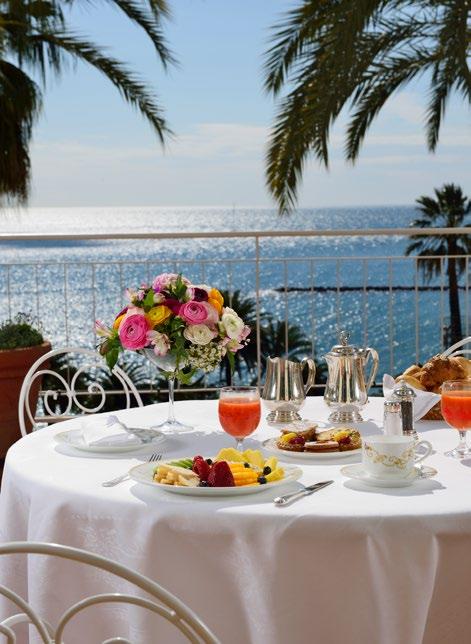
with olive and citrus trees.
Thanks to its strategic location, the Royal Hotel Sanremo welcomes motor enthusiasts during the Formula 1 Monaco Grand Prix, providing easy access to its glamorous side events full of adrenaline.
In addition, guests have the chance to enjoy invigorating outdoor sporting activities amidst the several possibilities available in Sanremo, such as the 18-hole “Circolo Golf degli Ulivi” golf course, the Società Ippica Sanremo, the Yacht Club, and the Riviera dei Fiori Coastal Park cycle-pedestrian track.
The Royal Hotel Sanremo collaborates closely with these facilities to ensure guests have an unforgettable stay.
The coming months promise to be vibrant, energetic, and full of activities, with the Royal Hotel Sanremo at the centre of it all for guests seeking unique experiences combined with the top-class hospitality that has long defined it. The Hotel invites everyone to explore the new offerings and participate in the events, ensuring an unforgettable stay in the magnificent backdrop of the Riviera dei Fiori.


12 SANREMO IT

LUNE EXPÉRIENCE PLEINE DE CHARME, DE PARFUMS ET DE COULEURS
e prestigieux Royal Hotel Sanremo, icône du luxe et du raffinement, et cela depuis 1872, rouvre ses portes après de minutieux travaux de rénovation qui ont concerné différents espaces de la structure, dont la terrasse solarium de la spectaculaire piscine d'eau de mer chauffée a 27°C, conçue par Gio Ponti, et qui, aujourd'hui, entièrement rénovée, est prête à accueillir les hôtes qui pourront également profiter d'une vue à couper le souffle sur la mer Ligure.
Avec l'arrivée du printemps, la Riviera italienne se pare d'un festival de couleurs, à l'image du luxuriant parc subtropical de 16 000 mètres carrés qui entoure de ses parfums et de sa beauté le Royal Hotel Sanremo. Un printemps qui enrichira l'événement « Villa Ormond in Fiore » à la fin du mois d'avril, une occasion supplémentaire de visiter Sanremo et le parc de l'élégante villa de style français de la fin du XIXe siècle, qui offre aux visiteurs un réseau dense d'allées et de pelouses avec des plantes exotiques centenaires qui côtoient des oliviers et des agrumes.
Grâce à la situation stratégique du Royal Hotel Sanremo, les passionnés des moteurs seront les bienvenus au Royal Hotel Sanremo pour le Grand Prix de Formule 1 de Monaco et tous ses événements annexes empreints d'adrénaline et de glamour. Sans oublier la possibilité d'un divertissement pour un moment revigorant de sport en plein air avec les plusieurs possibilités de Sanremo, telles que le terrain de golf de 18 trous du Circolo Golf degli Ulivi, la Società Ippica Sanremo, le Yacht Club, la piste cyclable et piétonne du Parc côtier Riviera dei Fiori, toutes institutions avec lesquelles le Royal Hotel Sanremo collabore pour garantir aux clients un séjour inoubliable. Les mois à venir seront une période vibrante, énergique et pleine d'activités, qui verra le Royal Hotel Sanremo au centre de l'attention des hôtes à la recherche d'expériences uniques, combinées à l'hospitalité haut de gamme qui a toujours caractérisé cet établissement. L'hôtel invite tout le monde à découvrir les nouveautés et à participer aux événements, promettant un séjour inoubliable dans le cadre splendide de la Riviera dei Fiori.
LE PRINTEMPS AU ROYAL HOTEL SANREMO
www.royalhotelsanremo.com 13 SANREMO IT
La scatola magica dell’Ariston
nel libro di Walter Vacchino e Luca Ammirati

VACCHINO E LUCA AMMIRATI 14 SANREMO IT
Alessandra CHIAPPORI Foto: ©Ariston Sanremo
WALTER
Una storia di spettacolo, musica e passione racchiusa dentro una scatola magica. La scatola è il Teatro Ariston di Sanremo, la storia è quella raccontata tra le pagine del libro scritto da Walter Vacchino, storico proprietario della sala, e Luca Ammirati, scrittore e responsabile della sala stampa del teatro che ha reso celebre Sanremo nel mondo. Se oggi, complice lo straordinario successo della 74° edizione del Festival della canzone italiana, persone da tutta Italia smaniano per farsi fotografare davanti all’iconica scritta Ariston, forse un motivo c’è: “Ariston. La scatola magica di Sanremo” (Salani, 2024) cerca di scoprirlo ripercorrendo la straordinaria storia familiare, culturale e sociale che si snoda dietro a questo posto. Un teatro di tutti, ma anche e soprattutto il progetto di Aristide Vacchino per la sua città. È dai racconti personali dei figli, Walter e Carla, che Luca Ammirati ha
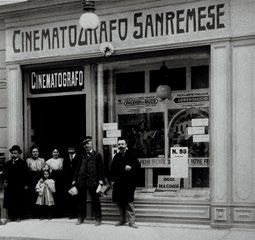

LUCIANO

intrecciato spunti e storie indagando le peculiarità di un teatro polifunzionale con una serie lunghissima di primati. L’Ariston è stato il cinema-teatro della città e ha ospitato la boxe mondiale in diretta tv, il Festival di Sanremo e il suo incredibile ventaglio di vip e artisti mondiali, ma anche la parallela rassegna del Premio Tenco, il balletto, le convention e tanto altro. “Sulla magia di questo posto ho ricavato diverse risposte intervistando tutti i direttori artistici del Festival con cui sono riuscito a chiacchierare – spiega Ammirati – è un fenomeno talmente grande che ho ricevuto sempre risposte diverse”. Una ricetta fortunata, forse, che ha senso solo a Sanremo e non altrove: “Grazie al Festival la gente sogna: replicare la stessa magia altrove non è scontato e mi sono convinto che il Festival sia ormai un rituale tutto italiano che contribuisce a creare tendenze, contraddizioni e polemiche per
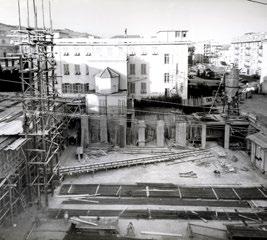
IL
UN

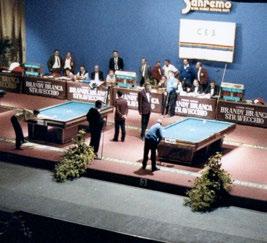
IL
almeno una settimana l’anno”. Ma questa festa per gli italiani ha una radice precisa: la famiglia Vacchino, che dell’Ariston ha vissuto la progettazione e la nascita nel 1963. “La scatola magica è il posto dove mettiamo i ricordi, le emozioni e le energie di una vita – commenta infatti Walter Vacchino – poi ci si ferma e da questa scatola si vedono uscire tantissime cose. Mio padre aveva pensato, sognato e realizzato un posto per la città: lavorandoci giorno per giorno non ci siamo resi conto di cosa fosse diventato, ma per tutte le esperienze che ha proposto alla città l’Ariston oggi è davvero un luogo di importanza sociale e culturale. Questo libro è stato per noi soprattutto un racconto tra fratelli, una magia enorme, ma è anche un percorso al quale si sono uniti in tantissimi, una serie di rapporti di amicizia nati sul palcoscenico e capaci di generare tanto altro”.
L’ORCHESTRA

IL

 CANTIERE, 1955.
CARLO DAPPORTO E LA SUA COMPAGNIA METTONO IN SCENA GIOVE IN DOPPIOPETTO, DICEMBRE 1963.
1° CAMPIONATO EUROPEO DI BILIARDO, OTTOBRE 1986.
PAVAROTTI CHIACCHIERA CON WALTER VACCHINO DURANTE LE PROVE DEL SUO CONCERTO, FEBBRAIO 1988
LA PLATEA NEI GIORNI SURREALI DEL FESTIVAL 2021.
SINFONICA DI SANREMO DIRETTA DAL MAESTRO CARLO FARINA, 31 MAGGIO 1963.
PUGILE NINO BENVENUTI POCHE ORE PRIMA DI COMBATTERE CONTRO DON FULLMER, DICEMBRE 1968.
VENTIDUENNE GIANNI MORANDI CON CARLA VACCHINO E ALCUNE AMICHE, MARZO 1966.
CANTIERE, 1955.
CARLO DAPPORTO E LA SUA COMPAGNIA METTONO IN SCENA GIOVE IN DOPPIOPETTO, DICEMBRE 1963.
1° CAMPIONATO EUROPEO DI BILIARDO, OTTOBRE 1986.
PAVAROTTI CHIACCHIERA CON WALTER VACCHINO DURANTE LE PROVE DEL SUO CONCERTO, FEBBRAIO 1988
LA PLATEA NEI GIORNI SURREALI DEL FESTIVAL 2021.
SINFONICA DI SANREMO DIRETTA DAL MAESTRO CARLO FARINA, 31 MAGGIO 1963.
PUGILE NINO BENVENUTI POCHE ORE PRIMA DI COMBATTERE CONTRO DON FULLMER, DICEMBRE 1968.
VENTIDUENNE GIANNI MORANDI CON CARLA VACCHINO E ALCUNE AMICHE, MARZO 1966.
15 SANREMO IT
LA FAMIGLIA VACCHINO DAVANTI AL CINEMATOGRAFO SANREMESE, AGLI INIZI DEL SECOLO
THE MAGIC BOX OF THE ARISTON IN THE BOOK
BY WALTER VACCHINO AND LUCA AMMIRATI
It’s a story of concerts, music and passion, all contained within a magic box - the Ariston Theatre in Sanremo. This captivating narrative unfolds within the pages of a book co-authored by Walter Vacchino, the historic owner of the venue, and Luca Ammirati, writer and head of the press room of the theatre that has made Sanremo famous all over the world. There must be a reason why people from all over Italy are jostling to have their photo taken in front of the iconic Ariston sign, especially
with the extraordinary success of the 74th edition of the Italian Song Festival. “Ariston. La Scatola Magica di Sanremo” (Salani, 2024) attempts to find out why by delving into the remarkable family, and the cultural and social history associated with this place. The Ariston Theatre is a theatre for everyone, but also, above all, it is Aristide Vacchino’s vision for his city. Through personal accounts from Aristide’s children, Walter and Carla, Luca Ammirati has compiled anecdotes and stories, investigating the unique features of


this multifunctional theatre with a long series of records. The Ariston serves as the city’s cinema-theatre, hosting a diverse range of events. These include world boxing championships broadcasted live on TV, the prestigious Sanremo Festival with its glittering line-up of celebrities and global performers, as well as the venue for the Premio Tenco festival, ballet performances, conventions and much more. “I received various insights into the magic of this place by interviewing all the artistic directors of the festival whom I had the opportunity to speak with,” Ammirati explains. “It’s such a significant phenomenon that each person had a different perspective.” Perhaps it’s a winning formula that resonates uniquely in Sanremo and nowhere else. “The festival makes people dream: replicating the same magic elsewhere is not taken for granted, and I am convinced that the festival has now become an all-Italian ritual that contributes to creating trends, contradictions and controversies for at least one week each year.”
However, this festival for Italians has a specific origin: the Vacchino family, who oversaw the conception and birth of the Ariston in 1963. “The magic box is where we store the memories, emotions and energies of a lifetime,” remarks Walter Vacchino. “And when you pause and reflect, you see so many experiences emerging from this box. My father envisioned, dreamed and built a place for the city. As we worked on it day after day, we didn’t fully grasp its significance. Yet through the myriad of experiences it has offered the city, the Ariston has evolved into a hub of social and cultural importance. For us, this book represents not only a story of siblings, brimming with magic and enchantment, but also symbolises a journey that many have embarked upon, a series of friendships born on stage and capable of generating so much more.”
 WALTER CHIARI IN UN MOMENTO CHE PRECEDE LA COMMEDIA MUSICALE BUONANOTTE BETTINA, MARZO 1964.
WALTER CHIARI IN UN MOMENTO CHE PRECEDE LA COMMEDIA MUSICALE BUONANOTTE BETTINA, MARZO 1964.
16 SANREMO IT
DUKE ELLINGTON, FESTIVAL DEL JAZZ, MARZO 1964.

LA BOÎTE MAGIQUE DE L’ARISTON DANS LE LIVRE DE WALTER VACCHINO ET LUCA AMMIRATI
Une histoire de spectacle, de musique et de passion enfermée dans une boîte magique. La boîte, c’est le théâtre Ariston de Sanremo, l'histoire, c’est celle qui est racontée au fil des pages du livre écrit par Walter Vacchino, propriétaire historique de la salle, et Luca Ammirati, écrivain et responsable de la salle de presse du théâtre qui a fait connaître Sanremo dans le monde entier. Si aujourd'hui, grâce à l'extraordinaire succès de la 74e édition du Festival de la chanson italienne, des personnes de toute l'Italie se pressent pour se faire photographier devant les lettres iconiques de l’enseigne Ariston, il y a peut-être une raison à cela : Ariston. La scatola magica di Sanremo (Ariston. La boîte magique de Sanremo) (Salani, 2024) essaie de nous la faire découvrir en retraçant l'extraordinaire histoire familiale, culturelle et sociale qui se rattache à ce lieu.
Un théâtre qui appartient à tous, mais aussi et surtout le projet d'Aristide Vacchino pour sa ville. C'est à partir des récits personnels de ses enfants, Walter et Carla, que Luca Ammirati a tissé des idées et des histoires, en enquêtant sur les particularités d'un théâtre multifonctionnel, riche d'une longue série de records. L'Ariston a été le cinéma-théâtre de la ville et a accueilli la
boxe mondiale en direct à la télévision, le Festival de Sanremo et son incroyable éventail de personnalités et d'artistes internationaux, mais aussi le concours parallèle du Premio Tenco, des ballets, des conférences et bien plus encore. « Sur la magie de ce lieu, j'ai obtenu plusieurs réponses en interviewant tous les directeurs artistiques du Festival avec lesquels j'ai pu bavarder », explique Ammirati, « c'est un phénomène tellement important que j'ai toujours obtenu des réponses différentes ». Une recette heureuse, peut-être, qui n'a de sens qu'à Sanremo et pas ailleurs : « Grâce au Festival, les gens rêvent : reproduire cette même magie ailleurs, ce n'est pas évident, et j'ai acquis la conviction que le Festival est désormais un rituel tout italien qui contribue à créer des tendances, des contradictions et des controverses pendant au moins une semaine par an ». Mais cette fête a une origine précise pour les Italiens : la famille Vacchino, qui a vécu le moment de la conception et de la naissance de l'Ariston en 1963. « La boîte magique est l'endroit où nous mettons nos souvenirs, nos émotions et les énergies de toute une vie », commente Walter Vacchino, « puis on s'arrête et on voit tant de choses sortir de cette boîte. Mon père avait pensé, rêvé et réalisé un lieu pour la
ville : en y travaillant jour après jour, nous ne nous sommes pas rendu compte de ce qu'il était devenu, mais pour toutes les expériences qu'il a proposées à la ville, l'Ariston est aujourd'hui un véritable lieu important sur le plan social et culturel. Pour nous, ce livre était avant tout un récit entre frères, une magie énorme, mais c'est aussi un bout de chemin que beaucoup de gens ont fait avec nous, une série d'amitiés nées sur scène et capables de générer tellement plus ».


www.aristonsanremo.com
CARLA E CHIARA VACCHINO CON AMADEUS.
17 SANREMO IT
WALTER VACCHINO CON IL VERO TRIONFATORE DELLE ULTIME EDIZIONI DEL FESTIVAL, AMADEUS.

18 SANREMO IT
©ALEX FIUMARA

vince la 74ª edizione del Festival di Sanremo con il brano "La noia"
2024
ANGELINA MANGO
19 SANREMO IT
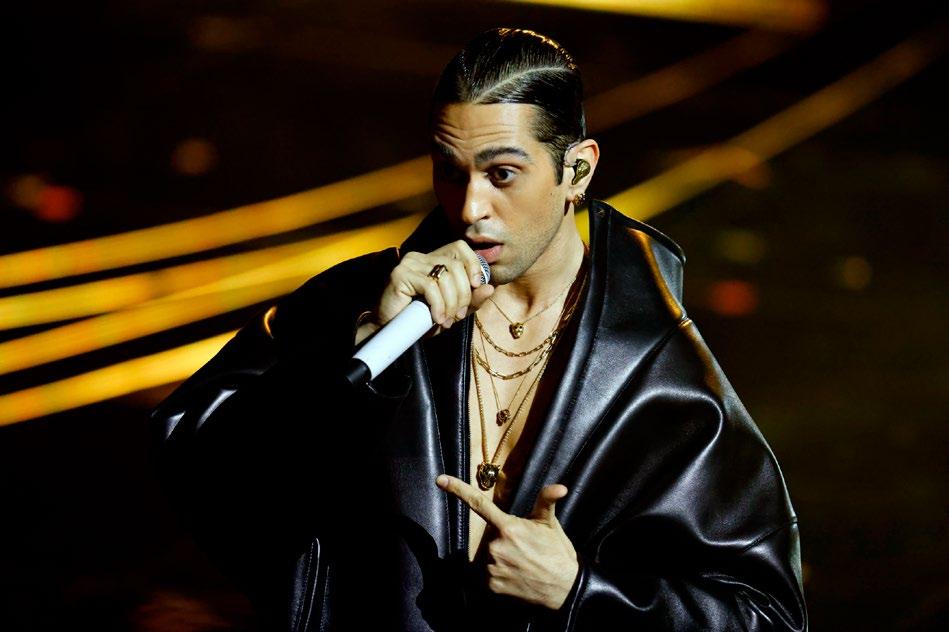
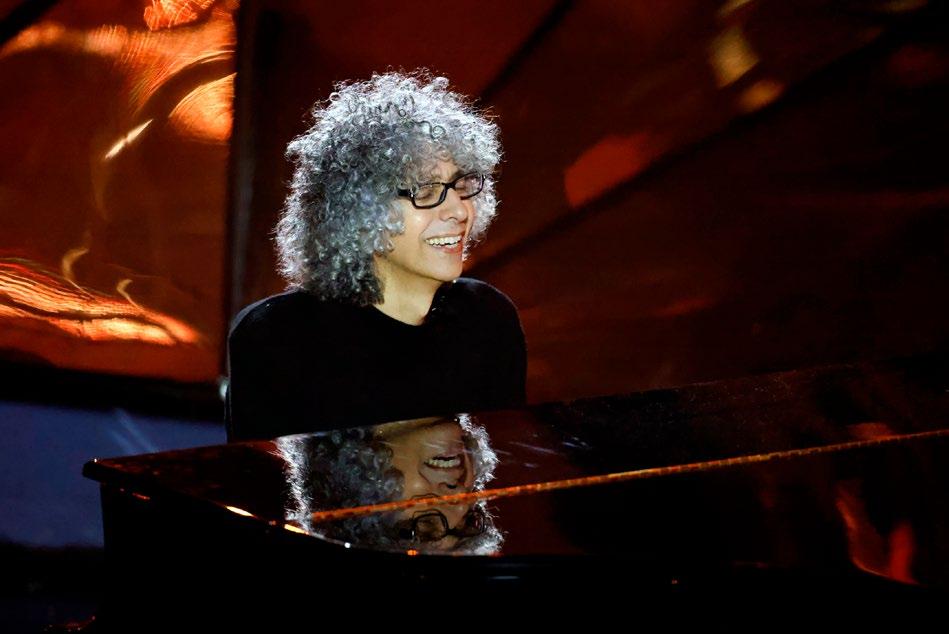 MAHMOOD
MAHMOOD
20 SANREMO IT
GIOVANNI ALLEVI
Gli autori questi conosciuti
le canzoni del Festival di Sanremo 2024
Simona CAPPELLI - Foto: ©Alex FIUMARA
Dietro a una grande canzone c'è sempre un grande autore. Chi sono questi genitori silenziosi di musiche e parole che fanno sognare? Una delle peculiarità dell’edizione 2024 del Festival di Sanremo è il consistente numero di menti creative che hanno dato il loro contributo alla realizzazione dei brani in gara. Tra gli autori non ci sono solo parolieri e compositori, ma anche altre figure del mondo musicale che lavorano come DJ, producer, ingegneri del suono e gli artisti stessi co- autori di brani loro e altrui.
Il primo da citare è il vincitore 2023, presente al Festival 2024 in ben 4 dei trenta brani in gara. “Due Vite” infatti porta la firma di Tropico, all’anagrafe Davide Petrella paroliere, compositore e cantautore partenopeo che ha già scritto per i più grandi nomi del panorama musicale italiano e non era nuovo alla collaborazione con gli artisti in gara al Festival 2024. Per Emma, Ghali, Rose Villen e The Kolors ha infatti firmato grandissimi successi, uno tra tutti il tormentone indiscusso dell’estate 2023, “Italo disco”. Un altro nome è quello di Davide Simonetta alias d.whale che, dopo il successo di “Due Vite”, ha provato a conquistare il podio con Annalisa e Geolier insieme a un’altra nota firma, Paolo Antonacci (figlio di Biagio e nipote di Gianni Morandi) in gara

anche con il brano di Emma, in questo caso al fianco di Petrella. Un altro nome ricorrente è quello di Jacopo Et (Jacopo Angelo Ettorre) noto paroliere e cantante di Forlì che abbiamo incontrato nei pezzi di Alessandra Amoroso, BNRK44, Fred De Palma e Mahmood e che si è fatto notare con successi come “Tribale”, “Dove” e “Quando”. A quota tre canzoni, quelle di Fiorella Mannoia, Dargen D’Amico e i Ricchi e Poveri, c’è l’immancabile Alfredo Rapetti Mogol noto come Cheope.
Con due brani - quello vincente di Angelina Mango e quello di Renga Nek - era presente anche Dardust, all’anagrafe Dario Faini, noto pianista, compositore, produttore e musicista.
Il ritorno de Il Volo al Festival era firmato tra gli altri dal cantautore e compositore cremonese Edwin Roberts autore anche per Dargen D’Amico e i Ricchi e Poveri.
Niente palco per Madame, che però ha firmato “La noia” di Angelina Mango, aggiudicandosi il Festival 2024. Ricordiamo infine Riccardo Zanotti senza gli altri Pinguini Tattici Nucleari, autore del brano dei La Sad, e poi Diodato e Giuliano Sangiorgi, che se la sono “cantata e scritta”, unici autori dei propri brani al Festival di Sanremo 2024.

RICCARDO ZANOTTI GIULIANO SANGIORGI 21 SANREMO IT
THE AUTHORS, THOSE KNOWN THE SONGS OF THE 2024 SANREMO FESTIVAL
Behind every great song is a great author. Who are these silent architects of music and lyrics that make people dream? One of the unique features of the 2024 Sanremo Festival is the large number of creative minds who have contributed to the competing songs. These creators are not just lyricists and composers; they also include music industry professionals such as DJs, producers, sound engineers and even the artists themselves who write their own songs and collaborate on other people’s songs.
Among the standout contributors is Marco Mengoni, the winner of the 2023 festival. He was present in four out of the thirty songs competing in this year’s festival. The song “Due Vite” was co-written by Davide Petrella, also known as Tropico, a Neapolitan lyricist, composer and songwriter who has written songs for some of the biggest names in Italian music and is no stranger to collaborating with artists at the 2024 Festival. In fact, he co-wrote successful tracks for Emma, Ghali, Rose Villen and The Kolors, as well as one of the undisputed hits of the 2023 Italian summer, “Italo disco”.
Another name is that of Davide Simonetta, known as d.whale who, after the success of “Due Vite,” attempted to conquer the podium with Annalisa and Geolier, teaming up with another familiar name, Paolo Antonacci (Biago’s son and Gianni Morandi’s grandson) who
also vied for victory with Emma’s song, this time alongside Petrella. Another recurring name is that of Jacopo Et (Jacopo Angelo Ettorre), a renowned lyricist and singer from Forlì who co-wrote songs for Alessandra Amoroso, BNRK44, Fred De Palma and Mahmood and who made his mark with hits like “Tribale”, “Dove” and “Quando”. Behind three songs at the festival – those of Fiorella Mannoia, Dargen D’Amico and Ricchi e Poveri – stands the esteemed Alfredo Rapetti Mogol, known as Cheope.
Dardust, whose real name is Dario Faini, a well-known pianist, composer, producer and musician, contributed to two songs, the winning piece by Angelina Mango and another by Renga and Nek. The return of Il Volo to the festival was orchestrated in part by Edwin Roberts, a singer-songwriter and composer from Cremona, who also lent his talents to compositions for Dargen D’Amico and Ricchi e Poveri.
While Madame didn’t claim a spot on the podium, her presence was felt with Angelina Mango’s winning song, “La noia.” Lastly, we shouldn’t forget Riccardo Zanotti, without his fellow members from Pinguini Tattici Nucleari, who wrote the song by La Sad, and then Diodato and Giuliano Sangiorgi, the only artists who both performed and wrote their own songs at the 2024 Sanremo Festival.

22 SANREMO IT
GIORGIA
LES AUTEURS CES INCONNUS
LES CHANSONS DU FESTIVAL DE SANREMO 2024
Derrière une grande chanson, il y a toujours un grand auteur. Qui sont ces créateurs silencieux de la musique et des mots qui font rêver ? Une des particularités de l'édition 2024 du Festival de Sanremo est le grand nombre d'esprits créatifs qui ont apporté leur contribution à la réalisation des morceaux en compétition. Les auteurs comprennent non seulement les paroliers et les compositeurs, mais aussi d'autres figures du monde de la musique, comme les DJ, les producteurs, les ingénieurs du son et les artistes eux-mêmes, qui sont coauteurs de leurs propres morceaux et de ceux d'autres artistes.
Le premier qu'il faut citer est le lauréat de 2023, présent au Festival 2024 dans pas moins de quatre des trente titres en compétition. Due Vite porte en effet la signature de Tropico, de son vrai nom Davide Petrella, parolier, compositeur et auteur napolitain qui a déjà écrit pour les plus grands noms de la scène musicale italienne et n'était pas inconnu de la collaboration avec les artistes en lice pour le Festival 2024. Pour Emma, Ghali, Rose Villain et The


Kolors, il a en effet signé de grands succès, dont le tube incontesté de l'été 2023, Italo disco.
Un autre nom est celui de Davide Simonetta connu sous le nom de d.whale qui, après le succès de Due Vite, a essayé de conquérir le podium avec Annalisa et Geolier ainsi qu'un autre nom bien connu, Paolo Antonacci (fils de Biagio Antonacci et petit-fils de Gianni Morandi) concourant également avec la chanson d'Emma, cette fois-ci, aux côtés de Petrella. Un autre nom récurrent est celui de Jacopo Et (Jacopo Angelo Ettorre), célèbre parolier et chanteur de Forlì que nous avons rencontré dans les chansons d'Alessandra Amoroso, BNRK44, Fred De Palma et Mahmood et qui s'est fait connaître avec des succès tels que Tribale, Dove et Quando. C’est avec trois chansons, celles de Fiorella Mannoia, de Dargen D'Amico et des Ricchi e Poveri, que l’on retrouve l'incontournable Alfredo Rapetti Mogol, autrement dit Cheope. Dardust, de son vrai nom Dario Faini, pianiste, compositeur, producteur et musicien de renom, était également présent avec deux chansons, celle d'Angelina Mango, qui a remporté le concours, et celle de Renga Nek. Le retour de Il Volo au Festival a été signé, entre autres, par l'auteur-compositeur-interprète de Crémone Edwin Roberts, également auteur pour Dargen D'Amico et les Ricchi e Poveri. Pas de scène pour Madame, qui signe cependant La noia d'Angelina Mango, lauréate du Festival 2024. Enfin, rappelons Riccardo Zanotti sans les autres Pinguini Tattici Nucleari, auteur de la chanson des La Sad, puis Diodato et Giuliano Sangiorgi, qui, la leur, l'ont « écrite et chantée », seuls auteurs de leurs propres chansons au Festival de Sanremo 2024.
DIODATO
23 SANREMO IT
MADAME
una sfida linguistica sempre attuale Il dialetto al Festival di Sanremo
Simona CAPPELLI
I primi a portare il dialetto sul palco del Festival di Sanremo furono Achille Togliani e il Duo Fasano durante la prima edizione della kermesse nel 1951 con la canzone “Famme Durmì”.
Pur con pesi diversi in base alle edizioni, le canzoni di questo genere hanno quasi sempre trovato il loro spazio all’interno della manifestazione. Si può facilmente osservare, tuttavia, che il numero di canzoni in dialetto napoletano è nettamente superiore a quello di altri dialetti come il sardo e il romano, pur presenti in buon numero. Sono rimasti indelebili nella storia i casi dei Pitura Freska nel 1997 con “Papa Nero”, che aveva parte di testo in veneziano e di Davide Van De Sfroos con “Yanez” che nel 2011 cantò all’Ariston in tremezzino.
La presenza del dialetto a Sanremo è stata da sempre una questione controversa che ha fatto e fa ancora molto discutere.
Emblematico è il caso del 2024 legato al rapper partenopeo Geolier che, con grande sorpresa dell’opinione pubblica, ha presentato una canzone in dialetto napoletano dal titolo “I p’me tu p’te”, nonostante il regolamento sembrasse vietarlo.
L’attaccamento dell’artista alla sua terra è scritto anche nel suo pseudonimo, traduzione francese di “secondino”, nome
con il quale sono chiamati gli abitanti di Secondigliano, quartiere di Geolier. Nel bene e nel male, come si suol dire, è sempre bene purché se ne parli. Per il rapper napoletano la bufera festivaliera è stata un ottimo auspicio, e lo ha portato tra i protagonisti di Sanremo 2024 più ascoltati e seguiti dai fan.


24 SANREMO IT
GEOLIER ©ALEX FIUMARA

25 SANREMO IT

26 SANREMO IT
ACHILLE TOGLIANI CON DEDICA A PINO RUCHER
DIALECTS AT THE SANREMO FESTIVAL AN EVER-PRESENT LINGUISTIC CHALLENGE
Back in 1951, Achille Togliani and the Duo Fasano were the first to introduce dialect to the Sanremo Festival with their song “Famme Durmì.”
While the presence of dialect songs at the Sanremo Festival has fluctuated over the years, they have remained a consistent feature. However, it’s notable that songs in the Neapolitan dialect have been more prevalent compared to others, such as Sardinian and Roman dialects, although these have also been well represented at times. Memorable moments such as Pitura
Freska’s 1997 song “Papa Nero”, which incorporated Venetian lyrics, and Davide Van De Sfroos’ 2011 rendition of “Yanez” in Tremezzino have left an enduring mark on the history of the festival.
The presence of dialects at Sanremo has always been a controversial issue that has sparked and continues to spark much debate. A striking example is the 2024 controversy surrounding Neapolitan rapper Geolier, who, to the great surprise of public opinion, presented the song “I p’me tu p’te” in Neapolitan despite apparent regulations
against it. Geolier’s deep connection to his Neapolitan roots is evident not only in his song choice but also in his stage name. “Geolier” is a French translation of “secondino,” a term that colloquially refers to inhabitants of his neighbourhood, Secondigliano.
As they say, any publicity is good publicity. For the Neapolitan rapper, the media frenzy surrounding his performance at the festival was a good omen, catapulting him to become one of the most listened-to and followed artists by fans at Sanremo 2024.

LE DIALECTE AU FESTIVAL DE SANREMO UN DÉFI LINGUISTIQUE TOUJOURS ACTUEL
Les premiers à avoir porté le dialecte sur la scène du Festival de Sanremo ont été Achille Togliani et le Duo Fasano lors de la première édition de la kermesse, en 1951, avec la chanson Famme Durmì. Bien qu'avec des poids différents selon les éditions, les chansons de ce genre ont presque toujours trouvé leur place dans cet événement. Il est cependant facile de constater que le nombre de chansons en dialecte napolitain est nettement supérieur à celui d'autres dialectes tels que le sarde et le romain, bien qu'ils soient présents en grand nombre. Les cas de Pitura
Freska en 1997 avec Papa Nero, dont une partie du texte était en vénitien, et de Davide Van De Sfroos avec Yanez, qu'il a chanté à l'Ariston dans le dialecte tremezzino en 2011, sont restés indélébiles dans l'histoire. La présence du dialecte à Sanremo a toujours été une question controversée qui a fait et fait encore beaucoup discuter. Le cas emblématique est celui du rappeur napolitain Geolier qui, en 2024, a présenté, à la grande surprise de l'opinion publique, une chanson en dialecte napolitain intitulée I p'me tu p'te, alors que le règlement semblait l'interdire.
L'attachement de l'artiste à sa terre natale est également inscrit dans le choix du mot français « geôlier » comme pseudonyme, traduction du mot italien « secondino » (gardien de prison), nom sous lequel sont appelés les habitants de Secondigliano (Naples), le quartier de Geolier. En bien ou en mal, comme on dit, l'important, c'est qu'on en parle. Pour le rappeur napolitain, la tempête du Festival a été de bon augure et lui a permis de figurer parmi les vedettes de Sanremo 2024 les plus écoutées et les plus suivies par les fans.
27 SANREMO IT
L’Amore al tempo del Festival di Sanremo
L’Amore è nell’aria, nello spot della Liguria per l’edizione 2024 del Festival di Sanremo e anche nelle canzoni che hanno partecipato negli anni alla kermesse. Grazie al sito www.leparoledisanremo.it possiamo scoprire quante canzoni in questi 74 anni contengono la parola amore: ben 1052, circa la metà del totale. Le prime che vengono in mente sono i tormentoni passati di generazione in generazione, come “Ciao Amore, ciao” di Luigi Tenco o “Vattene Amore” di Mietta e Minghi. Questa parola così dolce ed evocativa è sicuramente la più inflazionata, ampiamente utilizzata dagli autori dei testi sanremesi che hanno sempre prediletto un tema declinato in tante forme diverse. Possiamo dire che non c’è stata nessuna edizione completamente priva d’amore, ma sicuramente ce ne sono state alcune in cui l’amore ha davvero trionfato. È il caso di “Chi non lavora non fa l’amore” cantata da Adriano Celentano, vincitrice del 1971, “Un grande amore e niente più” canzone vincitrice nel 1973 cantata da Peppino di Capri, oppure di “Messaggio d’amore” dei Matia Bazar vincitrice nel 2002, per continuare con “Chiamami ancora amore” cantata da Roberto Vecchioni, vincitrice nel 2011, per concludere con “Grande

Amore” brano portato al successo dal Volo, canzone vincitrice nel 2015.
Se negli anni Cinquanta, agli esordi del Festival, l’amore faceva rima con il più classico romanticismo “Ma se l’amore nostro s’è perduto, perché vuoi tormentare il nostro cuor?”, già tra gli anni ‘60 e ‘70 si assiste a una trasformazione che riflette i cambiamenti sociali e culturali del tempo. Gli autori iniziano a esplorare temi più complessi e fino a quel momento considerati tabù: l'amore libero, oppure la ribellione e l'auto espressione. La parola "amore" prende connotazioni meno
convenzionali diventando un mezzo per raccontare le nuove dinamiche sociali, vedasi “Chi non lavora non fa l'amore! Questo mi ha detto ieri mia moglie!”. Negli anni ‘80 si torna all’amore sognante e romantico: in questo periodo si concentrano alcune delle più belle canzoni d’amore di tutti i tempi che contengono nei loro intramontabili ritornelli immancabilmente questa parola: “Ci sarà, una storia d’amore ed un mondo migliore” / Perdere l’amore quando si fa sera”. Nel nuovo millennio, le canzoni del Festival hanno continuato a riflettere le mutevoli prospettive sull'amore. L'uso della parola ha assunto contorni più sfumati, abbracciando relazioni ed emozioni umane complesse. Amore che alle porte del Duemila racconta storie di inclusività e di rottura allo stesso tempo, che va oltre i confini tradizionali e diventa sempre più rivoluzionario, talvolta tormentato e incompreso. Una fra tutte la chiacchieratissima “Luca era Gay” di Povia del 2009, per arrivare poi alle ultime edizioni dove nuovi generi musicali, nuovi stili e nuovi linguaggi trovano spazio. L’amore sembra resistere e, nel suo inesorabile cambiamento, continua a unire, ispirare e consolare in tutte le sue forme e a qualsiasi ritmo.
 Simona CAPPELLI - Foto: ©Alex FIUMARA
Simona CAPPELLI - Foto: ©Alex FIUMARA
IL VOLO 28 SANREMO IT

ANNALISA 29 SANREMO IT
LOVE AT THE SANREMO FESTIVAL
Love is in the air, not only in Liguria’s promotional campaign for the 2024 Sanremo Festival but also in the songs that have graced the festival’s stage over the years. Thanks to the www. leparoledisanremo.it website, we can discover that over the course of 74 years, an astonishing 1052 songs have contained the word “Amore” (Love) in their lyrics, about half of the total songs featured. Among the memorable tunes that come to mind are the iconic phrases that have been cherished across generations, such as Luigi Tenco’s “Ciao Amore, Ciao” or Mietta and Minghi’s “Vattene Amore.”
spotlight in 2011, and Il Volo’s “Grande Amore” (Great Love) soared to success in 2015.
If in the 1950s, at the outset of the Festival, love was often associated with classic romanticism, as seen in lyrics like “Ma se l’amore nostro s’è perduto, perché vuoi tormentare il nostro cuor?” (But if Our Love is Lost, Why Do You want to Torment my Heart), the 1960s and 1970s marked a shift that reflected the social and cultural changes of the era. During

The word “love” undoubtedly holds a special place within the realm of Sanremo lyrics. It stands out as the most frequently used term, favoured by the festival’s songwriters, who have consistently embraced its theme in many forms and expressions. While there may not have been an edition entirely devoid of love at Sanremo, there have certainly been years where love prominently triumphed. Examples include Adriano Celentano’s “Chi non lavora non fa l’amore” (He Who Does Not Work, Does Not Make Love), winner of the 1971 festival, Peppino di Capri’s “Un grande amore e niente più” (A Great Love and Nothing More), which triumphed in 1973 and Matia Bazar’s “Messaggio d’amore” (Message of Love), which won hearts in 2002. Continuing this trend, Roberto Vecchioni’s “Chiamami ancora amore” (Call Me Love Again) secured the
this time, songwriters began to explore more complex themes that had previously been considered taboo, such as free love, rebellion and self-expression. The word “love” took on less conventional connotations and became a vehicle for narrating new social dynamics, as exemplified in songs such as “Chi non lavora non fa l'amore! (He who does not work, does not make love) and Questo mi ha detto ieri mia moglie! (This is what my wife told me yesterday!)
In the 1980s, there was a resurgence of dreamy, romantic love. This period gave rise to some of the most beautiful love songs of all time, which unfailingly featured the word “love” in their timeless refrains. Examples include “Ci sarà, una storia d’amore ed un mondo migliore” (There Will Be a Love Story and a Better World) and “Perdere l’amore quando si fa sera” (Losing Love When Evening Falls).
In the new millennium, the songs of the festival have continued to reflect changing perspectives on love. The use of the word has taken on more nuanced meanings, embracing the complexities of human relationships and emotions. Love in the early 2000s narrates tales of inclusivity and disruption at the same time, transcending traditional boundaries and becoming increasingly revolutionary, at times tormented and misunderstood. One notable example is Povia’s controversial “Luca era Gay” (Luca was Gay) in 2009; subsequent editions have showcased new musical genres, styles, and languages.
Despite the changes, love persists and, in its ever-evolving nature, continues to unite, inspire and comfort in all its forms and tempos.
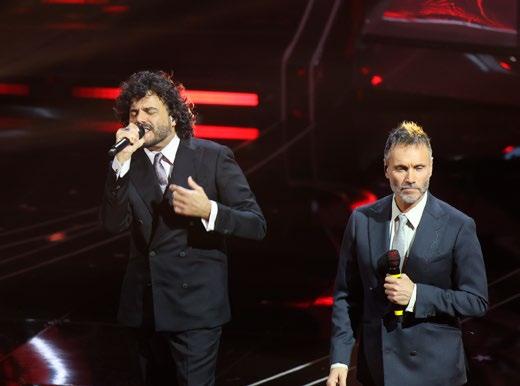 ROSE VILLAIN
ROSE VILLAIN
30 SANREMO IT
RENGA E NEK
L’AMOUR AU TEMPS DU FESTIVAL DE SANREMO
L’Amour est dans l’air, dans le spot de la Ligurie pour l’édition 2024 du Festival de Sanremo et également dans les chansons qui ont participé au fil des ans à cette kermesse.
Grâce au site www.leparoledisanremo. it, nous pouvons découvrir combien de chansons, durant ces 74 années, contiennent le mot amour : pas moins de 1 052, environ la moitié du total. Les premières qui viennent à l'esprit sont les tubes transmis de génération en génération, tels que Ciao Amore, ciao de Luigi Tenco ou Vattene Amore de Mietta et Minghi. Ce mot si doux et si évocateur est certainement le plus prisé et largement utilisé par les auteurs des textes de Sanremo, qui ont toujours privilégié ce thème décliné sous de multiples formes. On peut dire qu'il n'y a pas eu d'édition totalement dépourvue d'amour, mais il y en a certainement eu où l'amour a vraiment triomphé.
C’est le cas de Chi non lavora non fa l’amore chantée par Adriano Celentano, lauréat en 1971, Un grande amore e niente più chanson qui a gagné en 1973, chantée par Peppino di Capri, ou Messaggio d’amore des Matia Bazar lauréate en 2002, pour continuer avec Chiamami ancora amore chantée par Roberto Vecchioni, qui a gagné en 2011, pour conclure avec Grande Amore chanson portée au succès par Il Volo, chanson victorieuse en 2015.
Si dans les années 1950, au début du Festival, l'amour rimait avec le romantisme le plus classique Ma se l’amore nostro s’è perduto, perché vuoi tormentare il nostro cuor?(Mais si notre amour est perdu, pourquoi veux-tu tourmenter notre cœur ?),
déjà à cheval entre les années 1960 et 1970, on assiste à une transformation qui reflète les changements sociaux et culturels de l'époque.
Les auteurs commencent à explorer des thèmes plus complexes, jusqu'alors considérés comme tabous : l'amour libre, ou la rébellion et l'épanouissement personnel. Le mot « amour » prend des connotations moins conventionnelles, devenant un moyen de raconter de nouvelles dynamiques sociales, comme
dans Chi non lavora non fa l'amore!
Questo mi ha detto ieri mia moglie! (Qui ne travaille pas ne fait pas l'amour ! C'est ce que ma femme m'a dit hier !).
Dans les années 1980, on assiste à un retour à l'amour rêveur et romantique : c'est à cette époque que l'on trouve certaines des plus belles chansons d'amour de tous les temps, qui contiennent invariablement ce mot dans leurs refrains intemporels : Ci sarà, una storia d’amore ed un mondo migliore / Perdere l’amore quando si fa


sera (Il y aura, une histoire d'amour et un monde meilleur / Perdre l'amour lorsque le soir arrive).
Dans ce nouveau millénaire, les chansons du Festival ont continué à refléter l'évolution des perspectives sur l'amour. L'utilisation du mot a pris des contours plus nuancés, incluant des relations et des émotions humaines complexes. L'amour qui, au seuil de l'an 2000, raconte à la fois des histoires d'inclusion et de rupture, qui dépasse les frontières traditionnelles et devient de plus en plus révolutionnaire, parfois tourmenté et incompris. Une de ces histoires est celle de Luca era Gay de Povia en 2009, qui a fait beaucoup parler d'elle, puis les dernières éditions où de nouveaux genres musicaux, de nouveaux styles et de nouveaux langages ont trouvé leur place.
L'amour semble résister et, dans son inexorable changement, continue d'unir, d'inspirer et de consoler sous toutes ses formes et à tous les rythmes.
CLARA
31 SANREMO IT
TANANAI



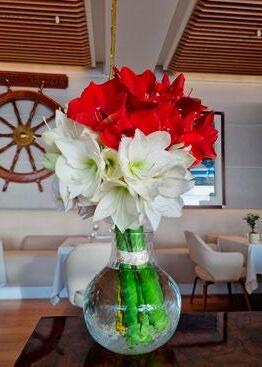

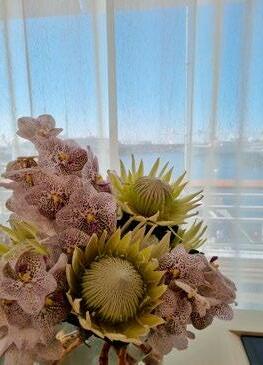

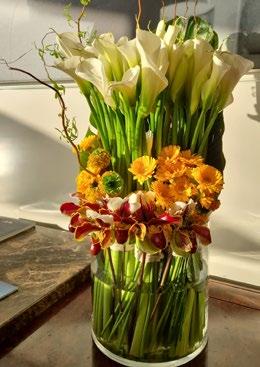

P.ZZA COSTITUENTE, 2 18039 VENTIMIGLIA (IM) +39 0184 23 90 14 +39 347 42 51 997 FIOLATTE@HOTMAIL.COM FIORDILATTEFLOWERDESIGN

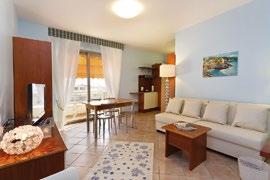



La comodità di un appartamento
Il servizio di un hotel
Il Residence dei Due Porti è situato nel centro di Sanremo, di fronte alla spiaggia ed alla nuova pista ciclabile, a soli 100 metri dalla piazza Colombo, il cuore della città. Dal solarium posizionato sopra ad una delle due palazzine del residence si può godere di una spendida vista. Monolocali, Bilocali e Trilocali completamente accessoriati. Nel prezzo è compreso il servizio giornaliero di pulizia. Parcheggio custodito a pagamento e doppia connessione Wi-Fi con fibra e ADSL veloce, gratuita in tutta la struttura. Ai nostri clienti diamo in uso gratuito alcune bici per poter godere delle bellezze del nuovo Parco Costiero della Riviera dei Fiori, una delle perle della Liguria. Il Residence dei Due Porti è inoltre convenzionato con gli stabilimenti balneari con spiaggia di sabbia fine posti di fronte che offrono scontistica su sdraio, lettini e ombrelloni.
The comfort of an apartment
The service of a hotel
The Residence dei Due Porti is located in the center of Sanremo facing the beach and the new bike path, just 100 meters from Piazza Colombo, the heart of the city.
From the solarium placed over one of the two buildings of the residence you can enjoy a wonderful view.
One, two or three rooms apartment fully equipped. The price includes daily cleaning. Attended pay car park and free double Wi-Fi connection with fiber and fast ADSL.
For our customers free rental bikes to enjoy the beauties of the new coastal park of the flowers Riviera, one of the pearls of Liguria.
The Residence dei Due Porti has an agreement with the sandy beaches just in front, that offer discounts on deck chairs and sun umbrellas.
Corso Trento e Trieste, 23 - SANREMO - ITALIA | Tel. +39 0184 506506 - Cell. +39 335 57 95 800 www.sanremo-aparthotel.com | info@dueporti.it
2O23
il recordman al Festival di Sanremo Massimo Morini

34 SANREMO IT
Simona CAPPELLI

Massimo Morini è una figura poliedrica nel panorama della musica e dello spettacolo italiano. Cantante, musicista e regista ligure, è noto soprattutto per essere il carismatico leader del gruppo musicale Buio Pesto.
Con una carriera lunga quasi tre decenni, Morini e il suo gruppo hanno conquistato un vasto pubblico, vendendo oltre 240.000 copie dei loro album e intrattenendo più di 1.400.000 spettatori in oltre mille concerti. La sua carriera musicale non si limita alla leadership dei Buio Pesto: Morini ha anche lasciato il segno come solista, realizzando ben 240 dischi da oltre 2.500.000 copie in tutto il mondo.
Con 23 presenze in classifica e 8 dischi d’oro, il suo contributo al panorama musicale italiano è indiscutibile. Così come il titolo di veterano al Festival di Sanremo: Morini ha partecipato per 34 volte consecutive, dal 1991 al 2024 con il doppio ruolo di Direttore d’Orchestra e/o Direttore Tecnico, stabilendo così un record. Le sue
8 vittorie, di cui 4 consecutive e una come Direttore d’Orchestra nel 2013 per Antonio Maggio, lo confermano tra le figure più importanti della storia di Sanremo. Se non bastassero i 26 podi e la gestione di ben 248 canzoni di 158 artisti diversi, Morini ha dalla sua anche la partecipazione a 12 edizioni di Sanremo Giovani. Non solo talento musicale, Morini ha dimostrato le sue abilità anche nel mondo del cinema e della televisione. Come regista e attore ha realizzato cinque film, di cui uno trasmesso da Sky e tre da Rai Due, e una serie TV trasmessa da Sky. Il suo ultimo film, “The President’s Staff”, co-prodotto da Rai Cinema, ha ricevuto persino i complimenti del Presidente degli Stati Uniti, Barack Obama. Se ancora la versatilità di Morini fosse in discussione, ricordiamo anche la sua partecipazione come tecnico del suono in alcuni dei più grandi concerti italiani con nomi come Vasco Rossi, Ligabue e Bruce Springsteen, eventi che hanno consolidando ulteriormente la sua reputazione nell’industria musicale.
35 SANREMO IT
MASSIMO MORINI
THE RECORDMAN OF THE SANREMO FESTIVAL
Massimo Morini is a multifaceted personality in the Italian music and entertainment scene. Hailing from Liguria, Morini is a singer, musician, and director, best known for his role as the charismatic frontman of the music band Buio Pesto. With a career spanning almost three decades, Morini and his band have amassed a large following, selling over 240,000 CDs and captivating audiences of over 1,400,000 people through more than a thousand concerts. His musical career is not limited to his work with Buio Pesto. He has established himself as a solo artist, producing more than 240 records and achieving sales of over 2,500,000 copies worldwide. With an impressive 23 chart appearances and eight gold albums, Massimo Morini’s impact on the Italian music scene is undeniable. A veteran of the Sanremo Festival, he has participated in the event an astonishing 34 times consecutively, from 1991 to 2024. He has served in various roles, including Orchestra Conductor and Technical Director, setting a record in the process. His remarkable achievements include eight
victories, with four consecutive wins, and one as Conductor for Antonio Maggio in 2013, solidifying his status as one of the most significant figures in the history of Sanremo. If the 26 podium finishes and the management of 248 songs by 158 different artists weren’t enough, Morini has also been involved in 12 editions of Sanremo Giovani. Morini is not just a talented musician; he has also showcased his skills in film and television. He has directed and acted in five films, one of which was aired on Sky, three on Rai Due, and a TV series broadcast on Sky. His most recent film, “The President’s Staff,” co-produced by Rai Cinema, even received acclaim from the President of the United States, Barack Obama.
If there were any doubts about Morini’s versatility, his work as a sound engineer for some of Italy’s biggest concerts should dispel them. He has collaborated with artists such as Vasco Rossi, Ligabue and Bruce Springsteen, which helped to further solidify his reputation in the music industry.

36 SANREMO IT

MASSIMO MORINI L’HOMME DES RECORDS AU FESTIVAL DE SANREMO
Massimo Morini est un personnage aux multiples facettes de la scène musicale et du monde du spectacle en Italie. Ce chanteur, musicien et réalisateur ligure, est surtout connu pour être le leader charismatique du groupe Buio Pesto. En près de trois décennies de carrière, Morini et son groupe ont conquis un large public, vendant plus de 240 000 exemplaires de leurs albums et divertissant plus de 1 400 000 spectateurs lors de plus de mille concerts. Sa carrière musicale ne se limite pas à celle de leader des Buio Pesto : Morini s'est également illustré en tant qu'artiste solo, en publiant pas moins de 240 disques, vendus à plus de 2 500 000 exemplaires dans le monde entier.
Avec 23 titres dans les hit-parades et 8 disques d'or, sa contribution à la scène musicale italienne est incontestable. Tout comme le titre de vétéran du Festival de Sanremo : Morini y a participé 34 fois de suite, de 1991 à 2024, avec le double rôle de chef d'orchestre et/ou de directeur technique, établissant ainsi un record. Ses 8 victoires, dont 4 consécutives et une en tant que chef d'orchestre en
2013 pour Antonio Maggio, le confirment parmi les personnalités les plus importantes de l'histoire de Sanremo. Si les 26 podiums et la gestion de pas moins de 248 chansons de 158 artistes différents ne suffisaient pas, Morini a également à son actif la participation à 12 éditions de Sanremo Giovani.
Morini n'est pas seulement un talent musical, il a également démontré ses capacités dans le monde du cinéma et de la télévision. En tant que metteur en scène et acteur, il a réalisé cinq films, dont un a été diffusé par Sky et trois par Rai Due, ainsi qu'une série télévisée transmise sur Sky.
Son dernier film, The President's Staff, coproduit par Rai Cinema, a même été félicité par le Président des États-Unis, Barack Obama. Si on pouvait encore douter de la polyvalence de Morini, rappelons également sa participation en tant que technicien du son à certains des plus grands concerts italiens avec des noms tels que Vasco Rossi, Ligabue et Bruce Springsteen, des événements qui ont contribué à consolider sa réputation dans l'industrie de la musique.

www.massimomorini.it 37 SANREMO IT
NYCANTA 2024
Quando la Musica Italiana illumina New York

 Redazione
Redazione
38 SANREMO IT
La XVI Edizione di NYCANTA s'avvicina, portando con sé l'essenza della musica italiana fino al cuore pulsante di New York. Questo festival, che si è guadagnato una posizione di prestigio nel panorama musicale globale, promette quest'anno un'edizione ancora più entusiasmante e all'insegna dell'innovazione, senza mai perdere di vista la tradizione che lo caratterizza.
L'Associazione Culturale Italiana di New York (ACINY), ideatrice e promotrice di questo Contest, ha scelto la società GLocal Media srl, presente a Milano e Sanremo, per curare le selezioni, tanto italiane quanto internazionali, di questa edizione.
Con l’arrivo di GLocal Media, al contest è stata da subito data una nuova direzione grazie ad una serie di nuove iniziative, come la presentazione del concorso durante il Festival di Sanremo 2024 e la realizzazione di un nuovo sito web, molto innovativo, che mette in risalto la storia del concorso e si prepara a ricevere le iscrizioni e presentare gli artisti selezionati. Inoltre, Glocal Media ha scelto Il M° Massimo Morini come Direttore Artistico per il percorso di tutte le selezioni, sia italiane che estere, la cui carriera è costellata da ben 34 partecipazioni, di cui 8 vittorie al Festival di Sanremo. La sua guida sarà una garanzia per gli iscritti e farà si che sul palco di NYCANTA salgano artisti di talento, pronti a emozionare il sempre più vasto pubblico.
Da oltre quindici anni, NYCANTA è testimone del legame che unisce gli italiani nel mondo dimostrato dai suoi tantissimi ospiti provenienti non solo dal mondo della musica, ma anche dalla televisione, dal cinema e dal teatro, che riflettono la ricchezza e la diversità dell'italianità. New York è senza dubbio una città che offre una importante vetrina internazionale per tutti i partecipanti,
ed è anche una scelta dedicata ai tanti italo-americani che hanno fatto la storia degli Stati Uniti. La grande finale si terrà il 13 ottobre all’Oceana Theater di New York, in concomitanza con le celebrazioni per il Columbus Day. L'Evento godrà di una vasta copertura mediatica, con la trasmissione su RAI2, Rai Italia e disponibilità su Rai Play, oltre alla diretta radiofonica su ICN New York e Radio Sanremo, garantendo così un'eco internazionale. Il percorso verso la finale newyorkese parte da Sanremo, con la Finale Italiana prevista per la prima settimana di settembre dove verranno scelti i 5 vincitori in Italia e i 5 vincitori italiani nel mondo. Tutti gli artisti scelti avranno l’opportunità di cantare sul palco nella serata evento del NYCANTA a New York per contendersi la vittoria finale ed entrare nell’Albo d’Oro dei vincitori.
GLocal Media ha previsto un tour su tutto il territorio italiano per ascoltare gli iscritti. Per gli iscritti all'estero, invece, il processo di selezione avverrà in video conferenza, con presentazione dei selezionati alla finale di Sanremo per poi aspettarli a New York.
Le voci di super ospiti italiani e di un noto presentatore aumentano l'attesa per un evento che promette di essere memorabile, non solo come vetrina per il talento musicale italiano, ma anche come ponte culturale tra Italia e Stati Uniti.
Per informazioni e iscrizioni:
• www.nycanta.com
• info@nycanta.com
• Whatsapp - Tel. +39 02 8089 8681
• www.facebook.com/nycantaofficial
• www.instagram.com/nycanta_official
• www.youtube.com/@NYCanta
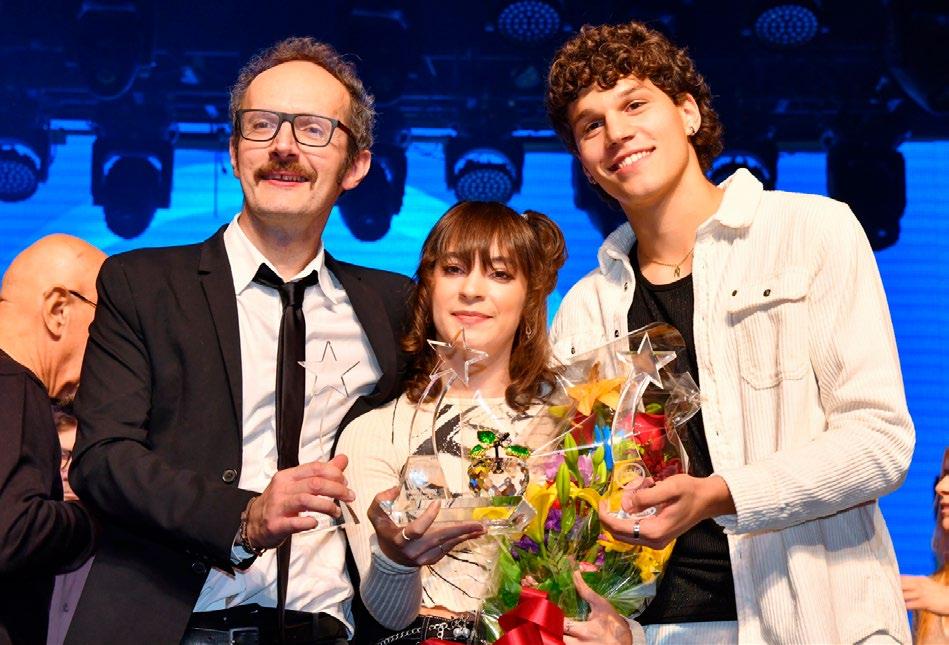
39 SANREMO IT
DAVIDE ZILLI, KIMONO (VINCITRICE NYCANTA 2023) E NICOLA FILIPPUCCI
NYCANTA 2024 WHEN ITALIAN MUSIC ILLUMINATES NEW YORK

The 16th NYCANTA festival is approaching, bringing the essence of Italian music to New York City. This event has earned a prestigious position on the global music scene, promising an even more exciting and innovative experience this year while staying true to its rich tradition.
The Associazione Culturale Italiana di New York (ACINY), creator and promotor of this song contest, has chosen GLocal Media srl, based in Milan and Sanremo, to handle both the Italian and international selections for this edition.
With the arrival of GLocal Media, the contest immediately took on a new direction, introducing a series of fresh initiatives, such as presenting the contest at the 2024 Sanremo Festival and launching an innovative new website. This website not only showcases the contest’s history, but also facilitates submissions and introduces the selected artists. In addition, Glocal Media has appointed Maestro Massimo Morini as the Artistic Director for all the selections, both Italian and international. With an illustrious career boasting 34 participations, including eight victories at the Sanremo Festival, the Maestro’s guidance ensures the selection of talented artists who will grace the stage at NYCANTA, ready to captivate the ever-growing audience.
For more than fifteen years, NYCANTA has highlighted the strong bond that unites Italians around the world. This is demonstrated by its many guests, who come from not only the world of music but also television, cinema, and theatre, reflecting the richness and diversity of Italian culture. New York undoubtedly provides an important international showcase for all participants and is also a choice dedicated to the many Italian-Americans who have made the history of the United States.
The grand final will take place on 13 October 2024 at the Oceana Theater in New York, coinciding with the Columbus Day celebrations. The event will receive extensive media coverage, including broadcasts on RAI2 and Rai Italia and availability on RAI Play. In addition, live radio broadcasts will be aired on ICN New York and Radio Sanremo, ensuring widespread international resonance.
The journey to the final in New York commences in Sanremo, with the Italian final scheduled for the first week of September, where the five winners from around the world will be selected. All the selected artists will then have the opportunity to perform on stage at NYCANTA in New York, vying for the ultimate victory and a place in the winners’ honour roll.
GLocal Media has organised a tour across Italy to listen to local entrants. For foreign entrants, the selection process will be conducted via videoconference. Those selected will be announced at the Sanremo final and invited to participate in the New York event. The voices of Italian guests and a well-known presenter heighten anticipation for an event that promises to be truly memorable. Not only does it serve as a platform for showcasing Italian musical talent, but it also acts as a cultural bridge between Italy and the United States.
For information and submissions:
• www.nycanta.com
• info@nycanta.com
• Whatsapp - Tel. +39 02 8089 8681
• www.facebook.com/nycantaofficial
• www.instagram.com/nycanta_officia
• www.youtube.com/@NYCanta

FOTO CONCLUSIVA DI NYCANTA 2023 40 SANREMO IT

NYCANTA 2024
QUAND LA MUSIQUE ITALIENNE ILLUMINE NEW YORK
La XVIe édition de NYCANTA s'approche, amenant l'essence de la musique italienne au cœur de New York. Ce festival, qui a su se tailler une place prestigieuse sur la scène musicale mondiale, promet, cette année, une édition encore plus passionnante sous le signe de l'innovation, sans jamais perdre de vue la tradition qui le caractérise. L'Association culturelle italienne de New York (ACINY), conceptrice et promotrice de ce concours, a choisi la société GLocal Media srl, présente à Milan et à Sanremo, pour organiser les sélections, tant italiennes qu'internationales, de cette édition.
Avec l'arrivée de GLocal Media, le concours a tout de suite pris une nouvelle orientation grâce à une série de nouvelles initiatives, comme la présentation du concours lors du Festival Sanremo 2024 et la réalisation d'un nouveau site web très innovant, qui met en valeur l'histoire du concours et se prépare à recevoir les candidatures et à présenter les artistes sélectionnés. De plus, Glocal Media a choisi le Maestro Massimo Morini comme Directeur artistique pour le parcours de toutes les sélections, à la fois italiennes et étrangères, dont la carrière est jalonnée de pas moins de 34 participations, dont 8 victoires au Festival de Sanremo. Son rôle de guide sera une garantie pour les adhérents et assurera que des artistes talentueux monteront sur la scène de NYCANTA, prêts à ravir le public de plus en plus nombreux. Depuis plus de quinze ans, NYCANTA est le témoin du lien qui unit les Italiens du monde entier, comme en témoignent les nombreux invités provenant non seulement du monde de la musique, mais aussi de la télévision, du cinéma et du théâtre, et qui reflètent la richesse et la diversité de l'italianité. New York est sans aucun doute la ville qui offre une importante vitrine internationale à tous les participants, et c'est aussi une façon de manifester leur proximité avec les nombreux Italo-Américains qui
ont marqué l'histoire des États-Unis. La grande finale se tiendra le 13 octobre à l’Oceana Theater de New York, en même temps que les célébrations pour le Columbus Day. L'événement bénéficiera d'une large couverture médiatique, avec la diffusion sur RAI2, Rai Italia et la disponibilité sur Rai Play, ainsi que la diffusion radio en direct sur ICN New York et Radio Sanremo, garantissant ainsi un retentissement international.
Le chemin vers la finale de New York débute à Sanremo, avec la Finale italienne prévue pour la première semaine de septembre, au cours de laquelle les cinq gagnants en Italie et les cinq gagnants italiens dans le monde entier seront choisis. Tous les artistes sélectionnés auront l'occasion de chanter sur scène lors de la soirée événement NYCANTA à New York, de concourir pour la victoire finale et d'entrer dans le Tableau d'honneur des gagnants.
GLocal Media a prévu une tournée dans toute l'Italie pour écouter les candidats. Pour ceux qui sont inscrits à l'étranger, en revanche, le processus de sélection se déroulera par vidéoconférence, avec présentation des candidats sélectionnés lors de la finale de Sanremo qui seront ensuite attendus à New York. Les bruits qui courent sur la présence de super invités italiens et d'un présentateur de renom renforcent l'attente d'un Événement qui promet d'être mémorable, non seulement en tant que vitrine du talent musical italien, mais aussi en tant que pont culturel entre l'Italie et les États-Unis. Pour toute information et pour les inscriptions :
• www.nycanta.com - info@nycanta.com
• Whatsapp - Tél. +39 02 8089 8681
• www.facebook.com/nycantaofficial
• www.instagram.com/nycanta_official
• www.youtube.com/@NYCanta

www.nycanta.com
41 SANREMO IT
CLAUDIO CECCHETTO RICEVE IL PREMIO MIKE BONGIORNO

BONGIORNO A SANREMO - VIA
42 SANREMO IT
Flaminio SPINETTI
LA STATUA DI MIKE
ESCOFFIER
UN DUETTO CHE HA FATTO LA STORIA MIKE E IL FESTIVAL

Se escludiamo i nati nel nuovo Millennio, per tutti gli altri c’è sicuramente un nome legato in maniera indissolubile a Sanremo e al Festival della canzone italiana: Mike Bongiorno, che oggi sarebbe centenario. Classe 1924, il newyorkese naturalizzato italiano è uno dei volti storici della kermesse, con ben 11 edizioni condotte all’attivo sulle 74 totali - un record che lo vede secondo soltanto allo storico collega e “rivale” Pippo Baudo, che guida questa speciale classifica con 13 direzioni. Pari merito con Baudo, e con Amadeus, è invece il primato di aver condotto cinque edizioni del Festival consecutive, dal 1963 al 1967.
Proprio il 1963 è stato l’anno d'esordio di Bongiorno all’Ariston, voluto in quel ruolo dal cantante Gianni Ravera, che del Festival organizzò ben 16 edizioni a partire dal 1962. Quella scommessa su Bongiorno si rivelò una delle più azzeccate nella storia della tv italiana, portando nella formula Sanremo maggiori spettacolarizzazione e spirito competitivo tra le canzoni in gara. Non mancarono anche momenti televisivi “iconici”, come quando nel 1966 la co-presentatrice Carla Puccini simulò uno svenimento
sul palco che Bongiorno decise di ignorare per proseguire con un aplomb molto più britannico che statunitense. Non mancano, come in tutta la carriera televisiva del presentatore, alcune mitologiche gaffe, come la sua infelice traduzione letterale della band inglese Yardbirds, introdotta come “i gallinacci”. Purtroppo, Mike si trovò anche a gestire nell’edizione del 1967 il suicidio di Luigi Tenco, forse dovuto alla delusione del cantautore per il mancato apprezzamento da parte di pubblico e giuria del brano che aveva portato in gara.
Bongiorno condusse ancora le edizioni del 1973, 1975, 1977 e 1979. Dopo una pausa di quasi vent’anni per il suo passaggio a Fininvest, la Rai lo “richiamò” per condurre la sua ultima edizione del Festival nel 1997. Da quell’anno Bongiorno non ha più calcato il palco dell’Ariston, ma ha un posto speciale nel cuore degli appassionati del Festival e di Sanremo.
Non solo metaforicamente, come dimostra la statua in Via Matteotti, donata dalla Fondazione Mike Bongiorno alla città di Sanremo nel 2013.
43 SANREMO IT
Flaminio SPINETTI
MIKE AND THE FESTIVAL A HISTORIC DUET
If we exclude those born in the new millennium, for everyone else, there’s one name intricately linked with Sanremo and the Italian Song Festival: Mike Bongiorno, who would have turned 100 this year.
Born in 1924, this New York-born naturalised Italian is a historic face of the festival, having hosted 11 editions out of a total of 74 – a feat that places him second only to his long-time colleague and “rival” Pippo Baudo, who holds the top spot with 13 editions. On par with Baudo and Amadeus, Bongiorno holds the record for hosting five consecutive editions of the festival, from 1963 to 1967.
In 1963, Bongiorno made his debut at the Ariston, thanks to the singer Gianni Ravera, who organised 16 editions of the festival starting in 1962. This gamble on Bongiorno proved to be one of the most successful in the history of Italian TV, injecting more spectacle and competitive spirit into the Sanremo formula. There was also no shortage of “iconic” television moments, such as when in 1966 co-presenter Carla Puccini pretended to faint on stage. Displaying a calm demeanour that was much more British
than American, Bongiorno chose to carry on with the show. He made many legendary gaffes while hosting the festival, as he did throughout his TV career, such as his unfortunate literal translation of the English band Yardbirds, introduced as “i gallinacci” (the hens).
Tragically, Mike also had to navigate the suicide of Luigi Tenco during the 1967 edition. The singer-songwriter’s decision was perhaps fuelled by his disappointment at the lack of appreciation from both the public and jury of the song he had brought to the competition.
Bongiorno also hosted the 1973, 1975, 1977 and 1979 editions. Following a nearly twenty-year hiatus due to his move to Fininvest, RAI called him back to host his final edition of the festival in 1997. Since then, Bongiorno has not graced the Ariston stage, but he holds a special place in the hearts of Festival and Sanremo fans.
This sentiment is not just metaphorical as demonstrated by the statue in Via Matteotti donated by the Mike Bongiorno Foundation to Sanremo in 2013.
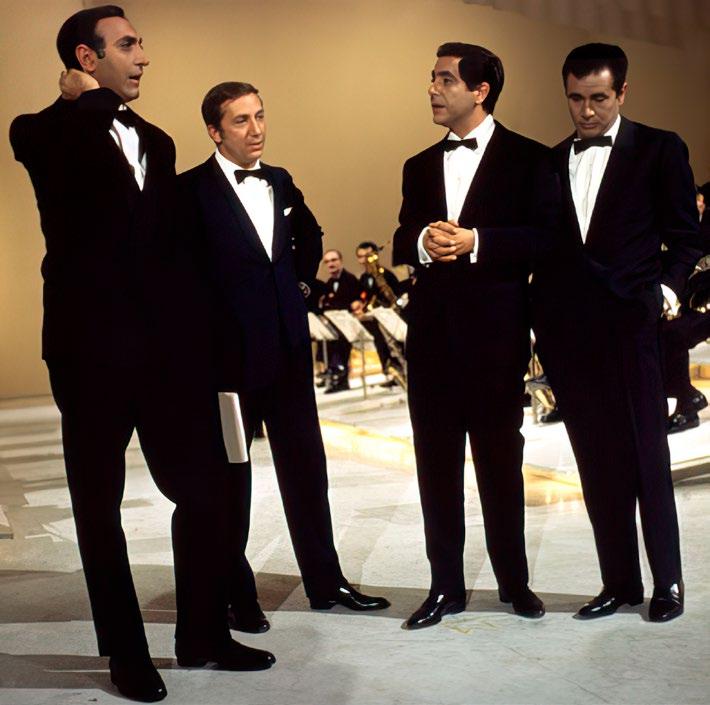
44 SANREMO IT
BAUDO, BONGIORNO, CORRADO E TORTORA
Si l'on exclut les personnes nées dans le nouveau millénaire, pour toutes les autres, il y a certainement un nom inextricablement lié à Sanremo et au Festival de la chanson italienne : Mike Bongiorno, qui aurait 100 ans aujourd'hui. Né en 1924, ce new-yorkais naturalisé italien est un des visages historiques de la kermesse, avec pas moins de 11 éditions présentées sur un total de 74 - un record qui le place en deuxième position derrière son collègue et « rival » historique, Pippo Baudo, qui mène ce classement spécial avec 13 éditions. En revanche, il est à égalité avec Baudo et avec Amadeus pour avoir dirigé cinq éditions consécutives du Festival, de 1963 à 1967. C'est précisément en 1963 que Bongiorno fait ses débuts à l'Ariston, voulu dans ce rôle par le chanteur Gianni Ravera, qui avait organisé pas moins de 16 éditions du Festival à partir de 1962. Ce pari sur Bongiorno s'est avéré être un des plus réussis de l'histoire de la télévision italienne, car il a apporté plus de spectacularité et un esprit de compétition entre les chansons en lice dans la formule Sanremo.
Des moments de télévision « emblématiques » n'ont pas manqué non plus, comme lorsqu'en 1966, la coprésentatrice Carla Puccini
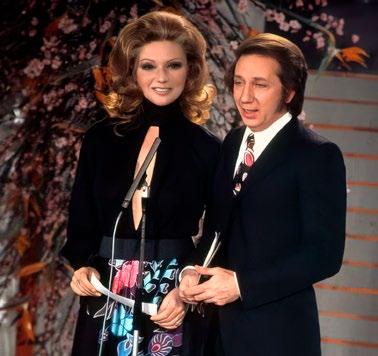
a fait semblant de tomber dans les pommes sur scène, chose que Bongiorno a décidé d'ignorer pour continuer avec un aplomb bien plus britannique qu'américain. Les gaffes mythiques ne manquent pas, comme tout au long de la carrière télévisuelle du présentateur, telle sa malencontreuse traduction littérale du groupe anglais Yardbirds, présenté comme les « Poules ». Malheureusement, Mike a aussi dû faire face au suicide de Luigi Tenco lors de l'édition 1967, peut-être en raison de la déception de l'auteur-compositeur-interprète face au manque d'appréciation du public et du jury à l'égard de la chanson qu'il avait présentée au concours.
Bongiorno a de nouveau animé les éditions de 1973, 1975, 1977 et 1979. Après une interruption de près de vingt ans due à son départ pour les chaînes Fininvest, la RAI l'a « rappelé » pour diriger sa dernière édition du Festival en 1997. Cette année-là, Bongiorno a foulé la scène de l'Ariston pour la dernière fois, mais il occupe une place particulière dans le cœur des fans du Festival et de Sanremo. Et ce non seulement métaphoriquement, comme en témoigne la statue de Via Matteotti, offerte par la Fondation Mike Bongiorno à la ville de Sanremo en 2013.

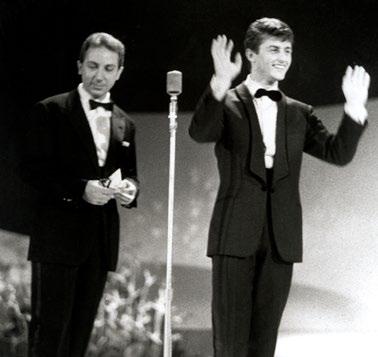


LE FESTIVAL
MIKE ET
UN DUO QUI EST RESTÉ DANS L’HISTOIRE
www.fondazionemike.it
SANREMO 1972 - SYLVA KOSCINA E MIKE BONGIORNO
SANREMO 1963 - MIKE BONGIORNO E TONY RENIS
SANREMO 1964 - MIKE BONGIORNO E GIGLIOLA CINQUETTI
45 SANREMO IT
SILVIO BERLUSCONI E MIKE BONGIORNO
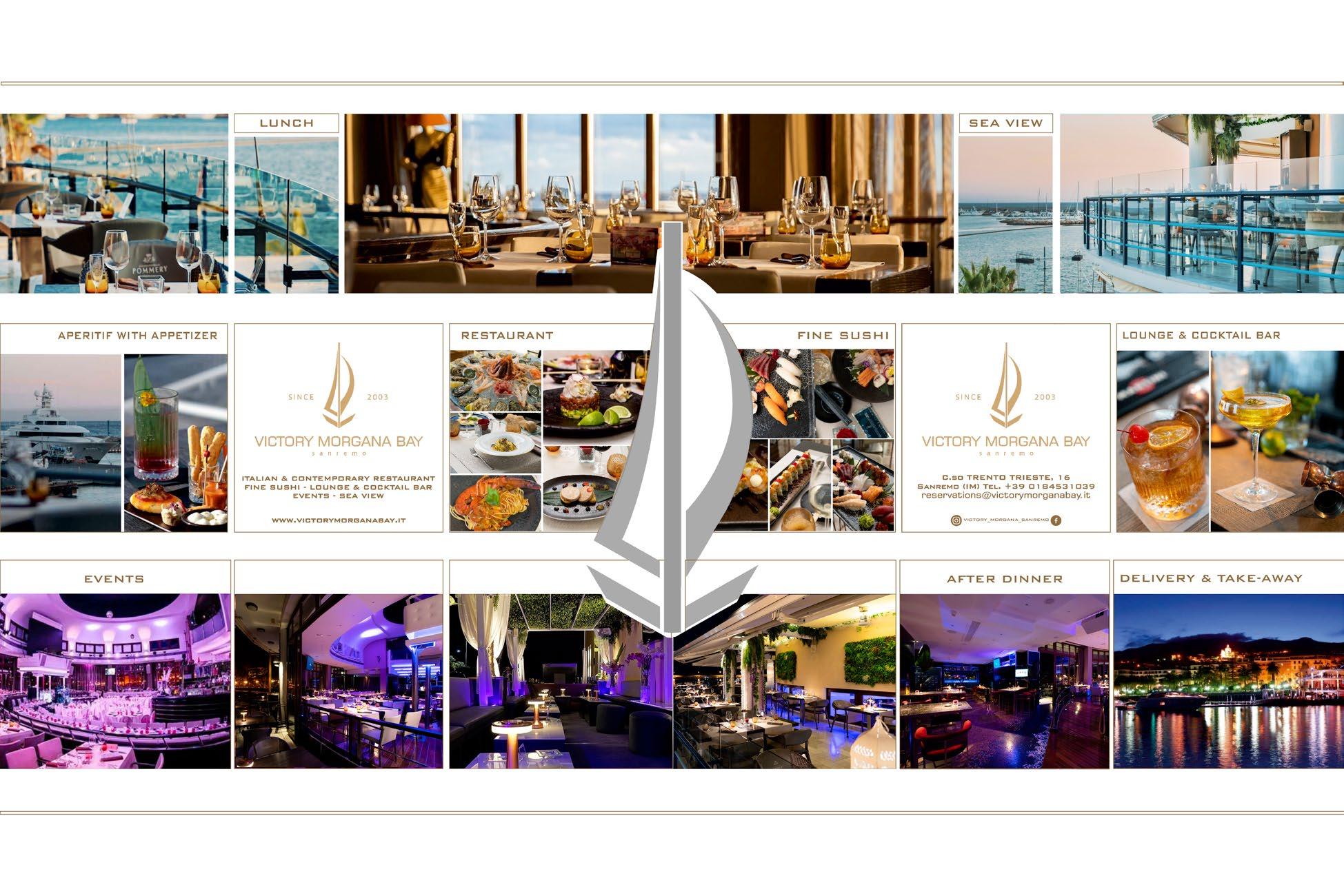

Un mare color lavanda
Dieci anni di “Lavanda della Riviera dei Fiori”

 Emanuela DHO Foto: © Lavanda Riviera dei Fiori
LAVANDA MAREBLU
Emanuela DHO Foto: © Lavanda Riviera dei Fiori
LAVANDA MAREBLU
48 SANREMO IT
LAVANDA BOSCOMARE

Ha il profumo dell’estate, l’intensità di chi cresce in salita, sulla terra ritagliata a braccia dal profilo della montagna, il blu violetto del mare al crepuscolo, con il ricordo di ciò che è stato e la promessa del giorno che sarà.
La lavanda in Liguria – o meglio, in quel triangolo teso tra estremo ponente, Val Tanaro e Piemonte meridionale – è molto più che un fiore: è storia e tradizione, cultura e passione, un’eccellenza che negli ultimi anni, grazie al progetto “Lavanda della Riviera dei Fiori”, sta conquistando spazio nel panorama nazionale e internazionale.
Obiettivo primario del progetto, nato da un’iniziativa di Cesare Bollani in sinergia col vivaista Andrea Curto e l’ibridatore Franco Stalla, è di rilanciare la coltivazione locale della lavanda come strumento di recupero del territorio e di valorizzazione di un autentico patrimonio quasi perduto.
Si è sviluppata, così, una vera e propria “cultura” della lavanda, che tocca numerosi settori, dalla
ricerca scientifica alla promozione turistica, dall’enogastronomia alla commercializzazione dei numerosi prodotti derivati dalla sua lavorazione. Fin dai tempi antichi, infatti, l’olio essenziale di lavanda – sia angustifolia (officinale), sia intermedia (ibrida) - e l’idrolato (acqua floreale) di lavanda sono stati ampiamente utilizzati nella fitoterapia e nella cura e igiene della persona e della casa grazie alle loro molteplici proprietà benefiche. Per i diversi utilizzi, il progetto “Lavanda della Riviera dei Fiori” ha selezionato, nei dieci anni di attività, alcune varietà dalle eccezionali caratteristiche, come la lavanda angustifolia “IMPERIA” (chemiotipo al linalolo senza canfora e quindi ottima per l’alimentazione) e gli ibridi “Boscomare”, “Mareblu” e “Petrae”, a cui si uniranno da quest’anno (anche se saranno in commercio dall’anno prossimo) due nuove tipologie di lavanda: la lavanda intermedia “Viola”, dedicata alla principessa Adelasia e quindi ideale
per la promozione dei territori di Rezzo, Cairo Montenotte e Alassio, e la lavanda angustifolia “Festival”, in onore della città di Sanremo.
Quest’ultima verrà presentata in esclusiva ad aprile, all’interno della manifestazione “Villa Ormond in fiore”.
La “Festival” è una angustifolia da vaso e da bouquet, destinata fin da ora a diventare ambasciatrice nel mondo della Lavanda della Riviera dei Fiori.
L’intenzione di coinvolgere anche spettatori e artisti.

49 SANREMO IT
LAVANDA ANGUSTIFOLIA FESTIVAL

50 SANREMO IT
LAVANDA IMPERIA
A SEA OF LAVENDER
TEN YEARS OF THE “LAVANDA DELLA RIVIERA DEI FIORI”
It carries the scent of summer, the intensity of those who cultivate it on the slopes, on land carved out by the mountain ranges. Its hue mirrors the violet-blue of the sea at dusk, holding memories of the past and promises of tomorrow. Lavender in Liguria – or rather, in that triangle spanning from the western edges to the Tanaro Valley and southern Piedmont – is much more than a flower. It embodies history, tradition, culture, and passion, a symbol of excellence. In recent years, the “Lavanda della Riviera dei Fiori” (Lavender of the Riviera of Flowers) project, conceived by Cesare Bollani in collaboration with nurseryman Andrea Curto and the hybridiser Franco Stalla, aims to revitalise local lavender cultivation. This initiative
seeks to reclaim the land and celebrate an authentic, almost-forgotten heritage. As a result, a genuine lavender “culture” has flourished, encompassing a wide range of industries, from scientific research to tourism promotion, from wine and food to the marketing of numerous products derived from its processing. Since ancient times, in fact, lavender essential oil – both angustifolia (officinalis) and intermedia (hybrid) – as well as lavender hydrosol (floral water), have been widely used in phytotherapy, personal care and household hygiene, due to their many therapeutic and beneficial properties. Over the past decade, the “Lavanda della Riviera dei Fiori” project has carefully chosen various lavender varieties for different purposes.
These include Lavandula angustifolia “IMPERIA” (linalool chemotype without camphor, making it ideal for culinary uses) and hybrids like “Boscomare,” “Mareblu” and “Petrae.” Joining them this year, though set to hit the market next year, are two new types: “Viola,” an intermediate lavender dedicated to Princess Adelasia, ideal for promoting the territories of Rezzo, Cairo Montenotte and Alassio, and “Festival,” an angustifolia lavender honouring the city of Sanremo.
The latter will be unveiled in April as part of the “Villa Ormond in Bloom” event. The “Festival” is an Angustifolia variety suitable for pots and bouquets, poised to become the global ambassador of the “Lavanda della Riviera dei Fiori”.

UNE MER COULEUR LAVANDE DIX ANS DE « LAVANDA DELLA RIVIERA DEI FIORI »
Elle a le parfum de l'été, l'intensité de ce qui pousse dans les montées, sur la terre découpée par le profil de la montagne, le bleu violet de la mer au crépuscule, avec le souvenir de ce qui a été et la promesse du jour qui sera. La lavande en Ligurie - ou plutôt dans ce triangle qui s'étend entre l'extrême ouest, la vallée du Tanaro et le sud du Piémont - est bien plus qu'une fleur : c'est une histoire et une tradition, une culture et une passion, une excellence qui, ces dernières années, grâce au projet « Lavanda della Riviera dei Fiori », a gagné du terrain sur la scène nationale et internationale. L'objectif premier du projet, né d'une initiative de Cesare Bollani en synergie avec le pépiniériste Andrea Curto et l'hybrideur Franco Stalla, est de relancer la culture locale de la lavande comme moyen de récupération du territoire et de
mise en valeur d'un patrimoine authentique, quasiment perdu.
Une véritable « culture » de la lavande s'est ainsi développée, touchant de nombreux secteurs, de la recherche scientifique à la promotion touristique, de l'œno-gastronomie à la commercialisation des nombreux produits issus de sa transformation. En effet, dès l'Antiquité, l'huile essentielle de lavande - tant angustifolia (officinale) qu'intermedia (hybride) - et l'hydrolat de lavande (eau florale) ont été largement utilisés en phytothérapie et dans les soins et l'hygiène du corps et de la maison, en raison de leurs nombreuses propriétés bénéfiques. Pour ses différentes utilisations, le projet « Lavanda della Riviera dei Fiori » a sélectionné, au cours de ses dix années d'activité, certaines variétés présentant des caractéristiques exceptionnelles, comme la lavande
angustifolia « IMPERIA » (chémotype linalolique sans camphre et donc excellent pour l'alimentation) et les hybrides « Boscomare », « Mareblu » et « Petrae », auxquels s'ajouteront deux nouveaux types dès cette année (même s'ils seront sur le marché à partir de l'année prochaine), la lavande intermedia « Viola », dédiée à la princesse Adelasia et donc idéale pour promouvoir les territoires de Rezzo, Cairo Montenotte et Alassio, et la lavande angustifolia « Festival », en l'honneur de la ville de Sanremo. Cette dernière sera présentée en exclusivité au mois d'avril, dans le cadre de l'événement « Villa Ormond in Fiore ». La « Festival » est une angustifolia de pot et de bouquet, destinée à devenir, dès à présent, l'ambassadrice dans le monde de la « Lavanda della Riviera dei Fiori ».

www.lavandarivieradeifiori.it
51 SANREMO IT
LAVANDA ANGUSTIFOLIA AUGUSTA


torna a Sanremo il 27 e 28 aprile Villa ORMOND in Fiore
Anna Maria CASTELLANA
52 SANREMO IT
Foto: ©Villa Ormond Events
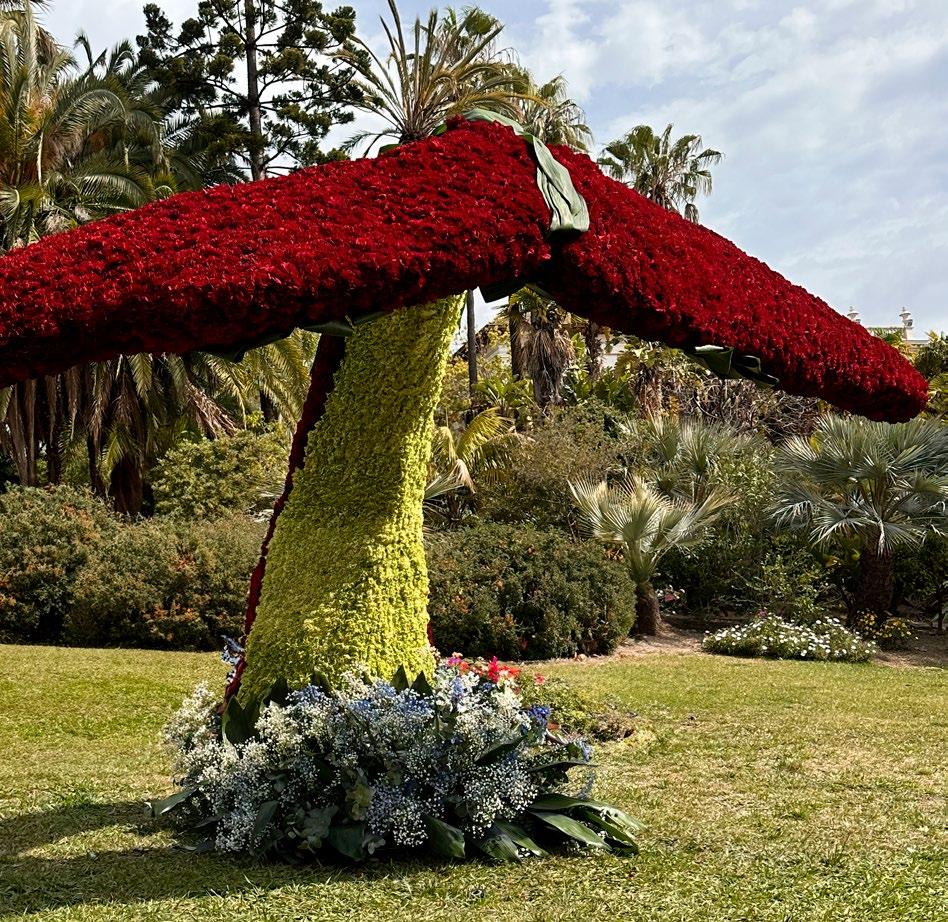
Il 27 e 28 aprile 2024 tornerà il consueto e gradito appuntamento con "Villa Ormond in Fiore" che dal 2017 celebra i colori e i profumi dei fiori, un'eccellenza della Riviera dei Fiori, storicamente legata alla floricoltura. La manifestazione è organizzata dalla Fondazione Villa Ormond con il contributo del Comune di Sanremo, di Regione Liguria, di Confindustria Imperia, di ANCEF, dell’Accademia di Belle Arti di Sanremo, del Mercato dei Fiori di Sanremo e di Unoenergy, tutti partner che credono nel progetto che sta progressivamente crescendo di anno in anno. “Villa Ormond
in Fiore” porterà un fine settimana ricco di eventi, in cui il fiore e la sostenibilità ambientale saranno i protagonisti assoluti con esposizioni floreali, mostre temporanee a tema, laboratori didattici per grandi e piccini, installazioni realizzate dal Consorzio dei Comuni del bacino sanremese, che raggruppa autentici artisti del settore. E ancora, ci saranno show cooking con ricette a base di piante eduli, teatro con degustazioni, musica da camera e live. L’occasione sarà perfetta per aprire al pubblico le porte di Villa Ormond con il suo vasto parco: l'ingresso sarà gratuito. Un'attenzione particolare, inoltre, sarà
dedicata in questa edizione 2024 alla sensibilizzazione sull’interazione responsabile dell’uomo con l'ambiente, un tema di grande attualità, determinante per il futuro. Da martedì 24 aprile, infine, sono previsti intrattenimenti e momenti di formazione e orientamento per i ragazzi delle scuole, allo scopo di accompagnarli verso scelte consapevoli sul proprio percorso di studi e professionale.
“Villa Ormond in Fiore” sarà insomma un piacevole week-end di primavera per adulti, ma anche per famiglie e per i più piccoli, all'insegna della natura e delle pratiche sostenibili.
53 SANREMO IT
"VILLA ORMOND IN FIORE" RETURNS TO SANREMO ON 27 AND 28 APRIL 2024
On April 27th and 28th, 2024, the beloved annual event "Villa Ormond in Fiore" (Villa Ormond in Bloom) will once again grace us with its presence, which has been celebrating the vibrant colours and captivating fragrances of flowers since its inception in 2017.
The event stands as a highlight of the Riviera dei Fiori (Riviera of Flowers), an area historically renowned for its floriculture.
Organised by the Villa Ormond Foundation in collaboration with the Municipality of Sanremo, the Liguria Region, Confindustria Imperia, ANCEF, the Sanremo Academy of Fine Arts, the Sanremo Flower Market and Unoenergy, this event continues to grow each year with the support of its dedicated partners.
During the Villa Ormond in Fiore weekend, visitors can immerse themselves in a celebration of flowers and environmental sustainability, with floral displays, themed temporary exhibitions, educational workshops for all ages, and installations created by the Consortium of the

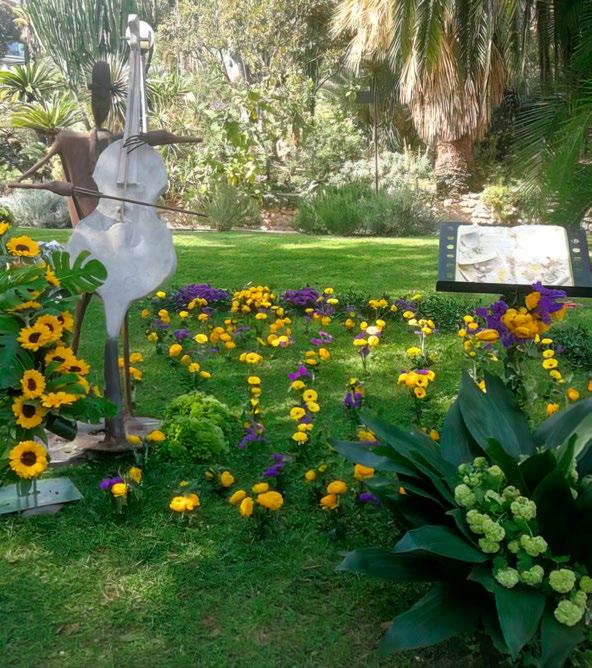
Municipalities of the Sanremo Basin, which brings together skilled artists in the sector. There will also be show cooking experiences showcasing recipes made with edible plants, theatrical performances combined with tastings, as well as chamber and live music performances. This event provides the perfect opportunity to explore Villa Ormond and its vast park, with free admission for all. In this 2024 edition, special emphasis will be placed on increasing awareness about humanity’s responsible interaction with the environment, a highly important issue that is crucial for our future. Moreover, starting on Tuesday, April 24th, there will be a series of engaging activities, training sessions and orientation programs for schoolchildren, with the aim of helping them make informed decisions about their education and future career paths. In short, “Villa Ormond in Fiore” promises to be a fun weekend for adults, families, and children, centred around nature and sustainable practices.
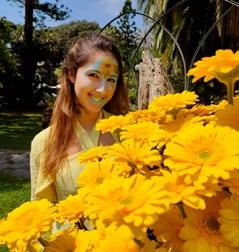
54 SANREMO IT
«
VILLA ORMOND IN FIORE »
REVIENT
À SANREMO LE 27 ET 28 AVRIL
Les 27 et 28 avril 2024, retour du rendez-vous habituel et apprécié avec la « Villa Ormond in Fiore » qui, depuis 2017, célèbre les couleurs et les parfums des fleurs, une excellence de la Riviera dei Fiori, historiquement liée à la floriculture. L'événement est organisé par la Fondation Villa Ormond avec la contribution de la Municipalité de Sanremo, de la Région Ligurie, de Confindustria Imperia, de l'ANCEF, de l'Académie des BeauxArts de Sanremo, du Marché aux fleurs de Sanremo et d'Unoenergy, tous des partenaires qui croient en ce projet qui grandit progressivement d'année en année. « Villa Ormond in Fiore » proposera un week-end riche en
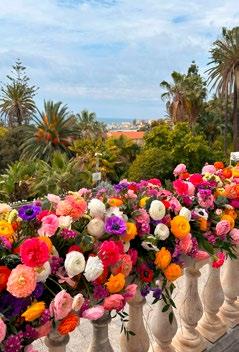

événements, où les fleurs et la durabilité environnementale seront les protagonistes absolus, avec des expositions florales, des expositions temporaires thématiques, des ateliers pédagogiques pour les grands et les petits, et des installations réalisées par le Consortium des municipalités du bassin de SanRemo, qui réunit de véritables artistes de ce secteur. Il y aura également des shows cooking avec des recettes à base de plantes comestibles, du théâtre avec des dégustations, de la musique de chambre et de la musique live. L'occasion sera parfaite pour ouvrir au public les portes de la Villa Ormond et de son vaste parc, et l'entrée sera gratuite. De plus, une attention particulière sera


consacrée, dans cette édition 2024, à la sensibilisation à l'interaction responsable de l'homme avec l'environnement, un thème très actuel et déterminant pour l'avenir.
Enfin, à partir du mardi 24 avril, des animations et des moments de formation et d'orientation seront proposés aux jeunes des écoles, dans le but de les accompagner vers des choix conscients dans leur parcours d'études et professionnel.
« Villa Ormond in Fiore » sera, en somme, un agréable week-end de printemps non seulement pour les adultes, mais aussi pour les familles et les enfants, sous le signe de la nature et des pratiques durables.



www.villaormondevents.com
55 SANREMO IT

56 SANREMO IT
Food Festival 2024
l'evento imperdibile per gli amanti del gusto e delle emozioni
LUCA GIOVANNETTI
Preparatevi a vivere un'esperienza culinaria indimenticabile il 21, 22 e 23 giugno 2024, quando “Riviera Food Festival” tornerà a brillare sotto i riflettori nella suggestiva Villa Ormond a Sanremo, dopo un'attesa durata dieci anni. Questa nuova edizione promette di essere un ritorno in grande stile grazie alla nuova gestione di GLocal Media, in collaborazione con Innovation Media, pronta a rilanciare il Festival che celebra le eccellenze gastronomiche della Riviera Ligure e quelle di tutta Italia. La scelta di Villa Ormond come palcoscenico di questo evento non è casuale. Ogni angolo della Villa, dallo storico Villino Winter, ora casa del Museo del Fiore Floriseum, ai lussureggianti giardini, diventa parte di un viaggio attraverso i sapori e i saperi della cucina italiana, passando per i mercatini dei
produttori locali, visitando il padiglione Pedrali per i territori ospiti, fino al cuore di questa stupenda Villa in un itinerario ricco di sapori ed emozioni. Ma il “Riviera Food Festival” è molto più di un semplice assaggio di prelibatezze. È un invito a vivere la cultura del cibo in tutte le sue forme, dagli Show Cooking nella Sala Conferenze, dove si potranno conoscere segreti e specialità locali, alle sale tematiche al primo piano, che esalteranno il meglio della produzione ligure. Da non dimenticare lo spazio esterno della Villa, trasformato per l'occasione in un'area di svago per grandi con musica live e momenti di ristogusto e di giochi per bambini con uno spazio di intrattenimento esclusivo, dove gli adulti potranno affidare i propri piccoli ad una equipe che li intratterrà mentre loro si dedicheranno, in tranquillità, ai gusti del palato.
Perché fermarsi al food? Sanremo in estate è sinonimo di serate magiche all'aperto che uniscono il suono della musica live al sapore unico delle specialità culinarie preparate al momento o di qualche degustazione particolare. Il Riviera Food Festival 2024 si preannuncia quindi come un evento imperdibile, un'occasione unica per immergersi nelle tradizioni gastronomiche italiane, in un'atmosfera di festa e condivisione.
Non perdete quindi l'appuntamento dal 21 al 23 giugno a Villa Ormond.
Vi aspettiamo per brindare insieme al nuovo Riviera Food Festival nel weekend più lungo dell’anno.
Per essere sempre aggiornati e conoscere il programma completo e i nostri partner, visitate il sito www.rivierafoodfestival.com, oppure scrivete a Info@rivierafoodfestival.com
Riviera
57 SANREMO IT
RIVIERA FOOD FESTIVAL 2024
AN UNMISSABLE CELEBRATION OF TASTE AND EXCITEMENT
Get ready for an unforgettable culinary adventure on 21, 22 and 23 June 2024 as the “Riviera Food Festival” makes its highly anticipated return to the beautiful Villa Ormond in Sanremo after a ten-year break. This exciting new edition is set to reignite the festival in grand style thanks to the new management of GLocal Media, in partnership with Innovation Media. Prepare to savour the finest food and wines from the Ligurian Riviera and beyond.
The choice of Villa Ormond as the venue for this event is not random. Every corner of the Villa, from the historic Villino Winter, now home to the “Floriseum” Flower Museum, to the lush gardens, serves as a backdrop for a culinary journey through the rich tapestry of Italian cuisine. Visitors can wander through the markets highlighting local producers, explore the Pedrali pavilion featuring guest territories, and delve into the heart of this magnificent Villa in an itinerary full of flavours and emotions.


The “Riviera Food Festival” offers much more than just a chance to taste exquisite delicacies. It is an invitation to experience the cultural richness of food in all its facets. From Show Cooking sessions in the Conference Hall, revealing local secrets and specialities, to themed halls on the first floor showcasing the finest products of Ligurian cuisine, there’s something to delight every palate and interest. Let’s not forget the outdoor area of the villa, transformed for the occasion into an area where adults can enjoy live music and “ristogusto” moments and children can play games and have fun.

Parents can relax and indulge in culinary delights while a dedicated team ensures little ones are entertained and well looked after. Why limit the experience to just food? Sanremo comes alive in summer with magical open-air evenings, where the melodies of live music blend harmoniously with the delightful flavours of freshly prepared food specialities and unique tastings.
The Riviera Food Festival 2024 is shaping up to be an unmissable event. It offers a unique opportunity to delve into the Italian culinary tradition amidst an atmosphere of celebration and sharing. Save the date and join us from 21 to 23 June 2024 at Villa Ormond for an unforgettable experience.
We look forward to seeing you at the new Riviera Food Festival, where we’ll raise a glass together on the longest weekend of the year.
Stay updates and discover the full program, along with our partners, by visiting the official website, www.rivierafoodfestival.com, or write to us directly at info@rivierafoodfestival.com
58 SANREMO IT
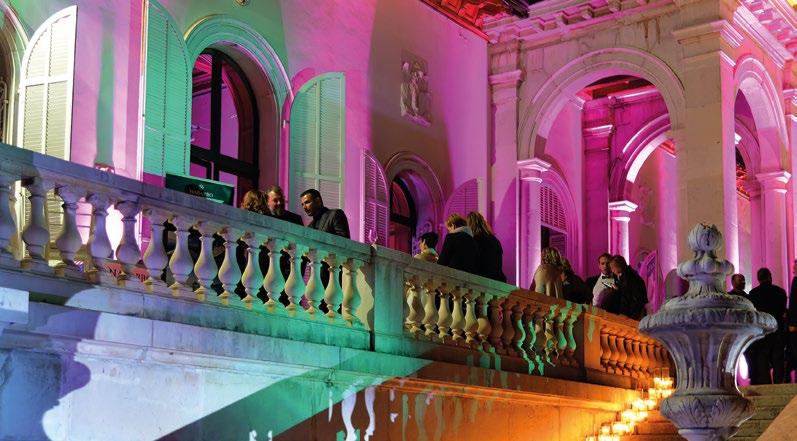
RIVIERA FOOD FESTIVAL 2024
L'ÉVÉNEMENT INCONTOURNABLE POUR LES AMATEURS DU GOÛT ET DES ÉMOTIONS
Préparez-vous à vivre une expérience culinaire inoubliable les 21, 22 et 23 juin 2024, lorsque le « Riviera Food Festival » reviendra sous les projecteurs de la suggestive Villa Ormond de Sanremo, après une attente longue de dix ans.
Cette nouvelle édition promet d'être un retour en grande pompe grâce à la nouvelle gestion de GLocal Media qui, en collaboration avec Innovation Media, est prête à relancer le Festival qui célèbre les excellences gastronomiques de la Riviera ligure et de toute l'Italie.
Le choix de Villa Ormond comme décor pour cet événement n’est pas un hasard. Chaque recoin de la Villa, de l'historique Villino Winter, qui accueille aujourd'hui le Museo del Fiore Floriseum, aux jardins luxuriants, devient partie intégrante d'un voyage à travers les saveurs et les savoirs de la cuisine italienne, en passant par les petits marchés des producteurs locaux, la visite du pavillon Pedrali pour les territoires d'accueil, jusqu'au cœur de cette superbe Villa, dans un itinéraire riche en saveurs et en émotions.
Mais le « Riviera Food Festival » est bien plus qu'une simple dégustation de délices. C'est une invitation à vivre la culture gastronomique sous toutes ses formes, du Show Cooking dans la salle de conférence, où l'on peut découvrir les secrets et les spécialités locales, aux salles thématiques du premier étage, qui mettront
en valeur le meilleur de la production de la Ligurie. Sans oublier, bien sûr, l'espace extérieur de la Villa, transformé pour l'occasion en une zone de détente pour les grands avec de la musique live et des moments de ristogusto et de jeux pour les petits avec une zone d'animation exclusive, où les adultes pourront confier leurs enfants à une équipe qui saura les divertir pendant qu'ils s'adonneront tranquillement à leur plaisir gustatif.
Et pourquoi s'arrêter à la gastronomie ? Sanremo, en été, est synonyme de soirées magiques en plein air, mêlant le son de la musique live à la saveur unique de spécialités culinaires tout juste préparées ou d'une dégustation spéciale.
Le Riviera Food Festival 2024 s'annonce donc comme un événement incontournable, une occasion unique de s'immerger dans les traditions gastronomiques italiennes, dans une atmosphère de fête et de partage.
Alors, ne manquez pas le rendez-vous du 21 au 23 juin à Villa Ormond.
Nous vous attendons pour lever ensemble nos verres au nouveau Riviera Food Festival pendant le week-end le plus long de l'année.
Pour rester toujours informés et découvrir le programme complet et nos partenaires, visitez le site officiel
www.rivierafoodfestival.com, ou écrivez à Info@rivierafoodfestival.com


www.rivierafoodfestival.com
59 SANREMO IT


Corso Cavallotti, 113 - 18038 Sanremo (IM) villaormondevents.com - info@villaormondevents.com Per informazioni e prezzi rivolgersi a: +39 339 7375890 / +39 0184 541848/204
Corso Cavallotti, 113 - 18038 Sanremo (IM) villaormondevents.com - info@villaormondevents.com Per informazioni e prezzi rivolgersi a: +39 339 7375890 / +39 0184 541848/204
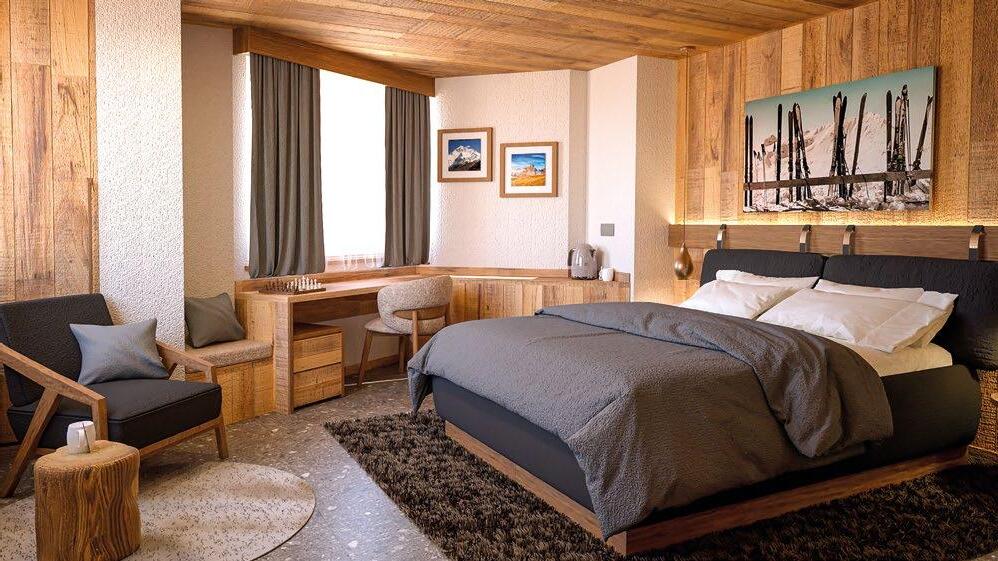




Limone More Mountain (LIMM) è una gemma incastonata nel cuore di Limone Piemonte a Quota 1400, luogo d'elezione per gli amanti dello sci e della natura alpina, a un soffio dalla Costa Azzurra.
Il paesaggio unico di questo luogo abbraccia la tranquillità e il comfort di un resort pensato per essere vissuto come un'oasi di relax e piacere.
Limone More Moutain inizierà ufficialmente le sue attività a settembre 2024. www.limm.it
QUOTA 1400 SETTEMBRE 2024

FOTO: ARCHIVIO ATL DEL CUNEESE 62 SANREMO IT
Dalla Via del Sale ai sentieri che collegano le fortificazioni del Colle di Tenda, sono tantissime le occasioni per esplorare le vette che circondano Limone unendo la passione per la bicicletta e panorami mozzafiato.

Limone a due ruote TUTTI IN SELLA
Flaminio SPINETTI
Con l’arrivo della bella stagione e la neve che resiste soltanto sulle vette più alte, Limone Piemonte è già pronta per “cambiare pelle”, da paradiso degli sport invernali a comprensorio per le avventure a due ruote.
Nel Limone Bike Resort sono infatti a disposizione di amanti e veterani della bici oltre 400 chilometri di strade militari sterrate a cavallo tra Italia e Francia, con oltre duemila metri di dislivello. Oltre ai percorsi di Enduro e Flow Trail per i più spericolati, la più vasta area ciclabile nel cuore delle Alpi Marittime può vantare anche alcune delle vie ciclabili in quota più suggestive in Europa.
Gli appassionati devono assolutamente cimentarsi lungo l’Alta Via del Sale, una ex strada militare nata negli anni Trenta per unire le Alpi al Mar Ligure che si snoda tra i 1800 e i 2100 metri di quota attraverso un panorama mozzafiato.
Oggi i 30 chilometri di strada sterrata che collegano Limone e Monesi di Triora possono essere affrontati a piedi, con fuoristrada durante il periodo estivo e, ovviamente, da mountain bike ed e-bike. Sempre in sella si possono raggiungere il Colle di Tenda a 1870 metri di altezza o
uno dei forti o postazioni militari che tra Otto e Novecento presidiavano il confine italo francese.
Per esempio, partendo dallo chalet Le Marmotte, si può seguire la strada sterrata che con un giro ad anello di circa 3 chilometri porta alla scoperta dei ricoveri di Voltalonga e di Plonat, fino ad arrivare alle suggestive rovine del complesso noto come Forte Centrale.
Con tragitti un poco più lunghi e impegnativi si può visitare anche il Forte Tabourda (a 1982 metri di altezza) e, proseguendo per altri 5 chilometri circa, il Forte Pepino - a ben 2263 metri.
Altri itinerari conducono al Forte Pernante, al Giaura e al Margherita, mentre le acque cristalline dei Laghi di Peirafica aspettano i meno interessati alla storia militare.
Il Limone Bike Resort è attrezzato con postazioni di noleggio, tour guidati organizzati, segnaletica e mappe interattive consultabili online, bike shuttle e alberghi e punti di ristoro convenzionati. Per arrivare più vicini alla partenza delle sterrate, durante il periodo estivo restano aperti anche i due impianti di risalita della seggiovia Cabanaira e della telecabina Severino Bottero.
63 SANREMO IT
From Via del Sale to the paths connecting the fortifications of Colle di Tenda, Limone offers ample opportunities to explore its peaks while indulging in a love for cycling and taking in breathtaking views.

GET IN THE SADDLE LIMONE ON TWO WHEELS
As the warmer weather arrives and the snow only lingers on the highest peaks, Limone Piemonte transforms from a winter sports paradise into a resort for twowheeled adventures.
At Limone Bike Resort, beginners and experienced cyclists can explore over 400 kilometres of dirt military roads stretching between Italy and France, with an elevation gain of more than two thousand meters. In addition to the enduro and flow trails dedicated to the more adventurous, the largest cycling area in the heart of the Maritime Alps also offers some of Europe’s most scenic high-altitude routes. Enthusiasts should definitely try the Alta Via del Sale, a former military road dating back to the 1930s, originally built to connect the Alps with the Ligurian Sea. This mesmerising route winds its way between 1800 and 2100 metres above sea level, offering breathtaking views of the surrounding landscapes. Today, the 30-kilometre dirt road connecting Limone and Monesi di Triora is accessible on foot, by off-road vehicles during the summer, and, of course, by mountain bikes and e-bikes. Still in the saddle, cyclists can ascend to Colle di Tenda at 1870 metres above sea level or explore one of the forts or military posts that once guarded the Italian-French border during the 19th and 20th centuries.

For instance, starting from the Le Marmotte chalet, cyclists can follow a dirt road on a 3-kilometre loop to discover the Voltalonga and Plonat shelters, eventually reaching the captivating ruins of the complex known as the Central Fort. For those seeking slightly longer and more challenging routes, Fort Tabourda (at 1982 metres) and Fort Pepino (at an impressive 2263 metres) can be reached by continuing for approximately another 5 kilometres. Other paths lead to Fort Pernante, Giaura and Margherita,
while those less interested in military history can enjoy the crystal-clear waters of the Peirafica lakes.
The Limone Bike Resort is equipped with rental facilities, organised guided tours, signposts and online interactive maps, bike shuttles and affiliated hotels and refreshment points. Additionally, during the summer months, cyclists can make use of the Cabanaira chairlift and the Severino Bottero gondola to access the trailheads more easily.
FOTO: ©R.CROCI|ARCHIVIO ATL DEL CUNEESE
64 SANREMO IT
FOTO: ©R.CROCI|ARCHIVIO ATL DEL CUNEESE
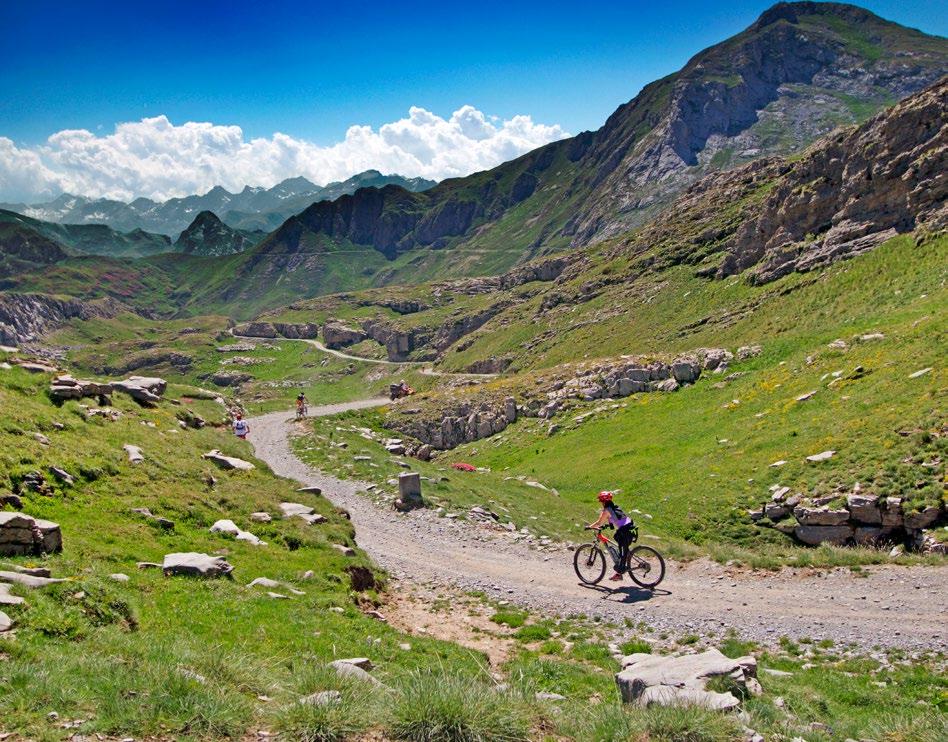
De la Route du Sel aux sentiers qui relient les fortifications du Col de Tende, nombreuses sont les occasions pour explorer les sommets entourant Limone tout en joignant la passion pour le vélo et les panoramas à couper le souffle.
FOTO: ©ARCHIVIO ATL DEL CUNEESE
Avec l'arrivée du beau temps et la neige qui ne reste que sur les plus hauts sommets, Limone Piemonte est déjà prête à « changer de peau », passant du paradis des sports d'hiver à la station pour les d'aventure sur deux roues.
Dans le Limone Bike Resort, plus de 400 kilomètres de routes militaires en terre battue, à cheval entre l'Italie et la France, avec plus de deux mille mètres de dénivelé, sont à la disposition des amateurs et des vétérans du vélo. Outre les parcours Enduro et Flow Trail pour les plus téméraires, le plus grand domaine cyclable au cœur des Alpes maritimes peut également se targuer de posséder quelques-unes des voies cyclables d'altitude les plus suggestives d'Europe. Les passionnés doivent absolument s'essayer à la Haute Route du Sel, une ancienne route militaire créée dans les années 1930 pour relier les
TOUS EN SELLE LIMONE SUR DEUX ROUES
Alpes à la mer Ligure, qui serpente entre 1800 et 2100 mètres d'altitude à travers un panorama à couper le souffle. Aujourd'hui, les 30 kilomètres de chemin de terre qui relient Limone et Monesi di Triora peuvent être parcourus à pied, par des véhicules tout-terrain pendant l'été et, bien sûr, par des VTT et des vélos électriques.
Toujours en selle, on peut atteindre le Col de Tende à 1870 mètres d'altitude ou l'un des forts ou postes militaires qui gardaient la frontière italo-française entre le XIXe et le XXe siècle.
Par exemple, en partant du chalet Le Marmotte, on peut suivre le chemin de terre qui, dans un itinéraire en boucle d'environ 3 kilomètres, mène à la découverte des abris de Voltalonga et de Plonat, jusqu'aux ruines suggestives de l'ensemble connu sous le nom de Forte Centrale. Des
itinéraires un peu plus longs et plus ardus permettent également de visiter le Fort Tabourda (à 1982 mètres d'altitude) et, en continuant sur environ 5 kilomètres, le Fort Pepino - à une altitude impressionnante de 2263 mètres. D'autres itinéraires mènent au Fort Pernante, au Giaura et au Margherita, tandis que les eaux cristallines des lacs de Peirafica attendent ceux qui sont moins intéressés par l'histoire militaire.
Le Limone Bike Resort est doté de stations de location, de visites guidées organisées, d'un balisage et de cartes interactives consultables en ligne, de navettes pour vélos ainsi que d'hôtels et de points de ravitaillement affiliés.
Pour se rapprocher du départ des sentiers de randonnée, les deux remontées mécaniques de Cabanaira et la télécabine Severino Bottero sont également ouvertes pendant l'été.
65 SANREMO IT
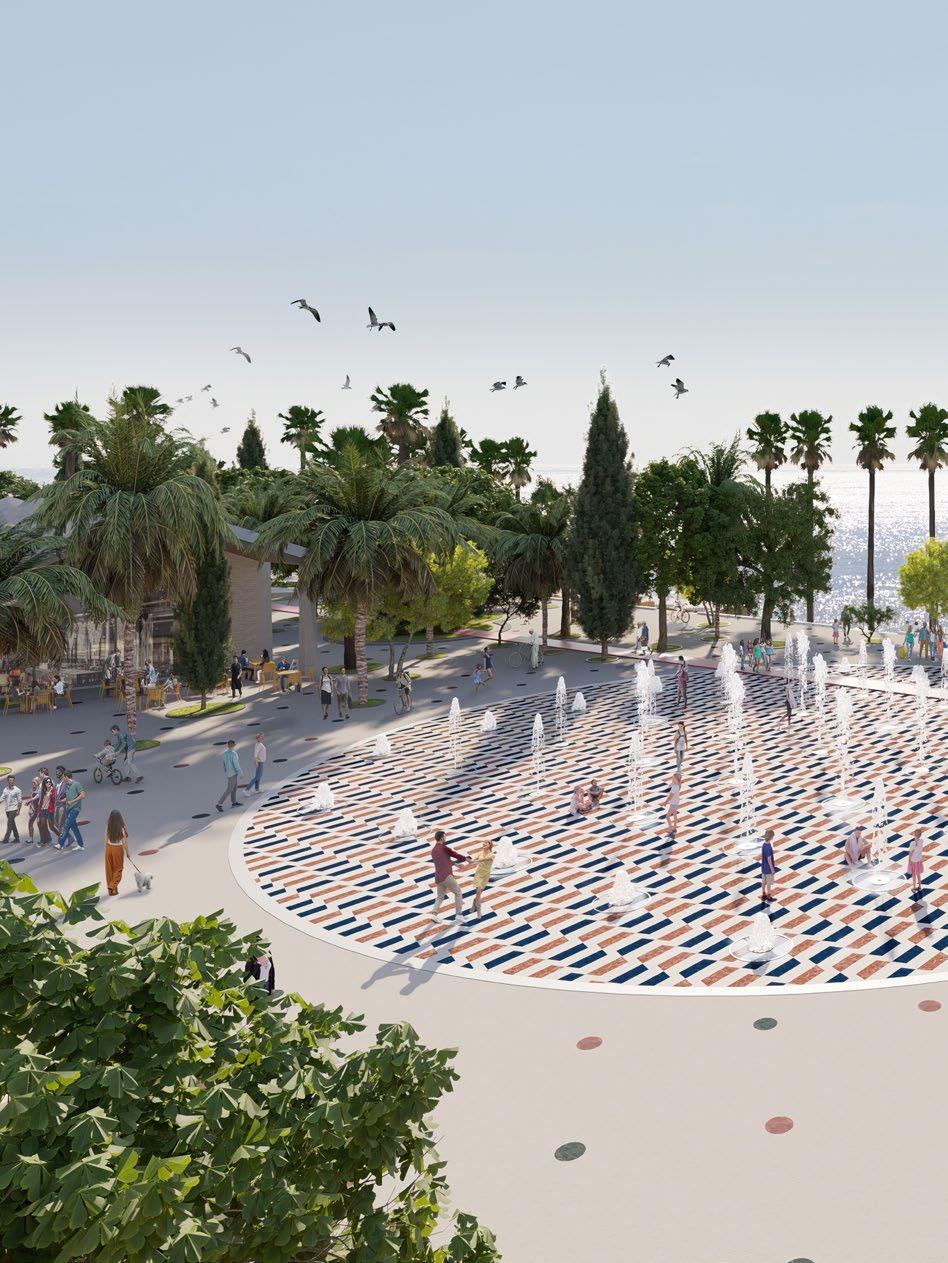
Il nuovo lungomare di Sanremo
Flaminio SPINETTI
66 SANREMO IT
Foto © CALVI CESCHIA VIGANÒ ARCHITETTI ASSOCIATI

una passeggiata nel futuro
Prendete una cartolina di Sanremo durante la Belle Époque. È facile che ritragga signore in abiti di crinolina e ombrellino prendisole che si godono la vista del mare e il clima mite della Liguria. Inglesi, russi, tedeschi: gran parte del “bel mondo” dell’Europa di fine Ottocento trascorse almeno un periodo di villeggiatura a Sanremo, stregata dalla sua bellezza e dal richiamo di uno dei lungomare più noti al mondo.
Oltre un secolo dopo quella che in città è spesso ricordata come “epoca d’oro” del turismo, Sanremo guarda al futuro puntando ancora una volta sul suo lungomare.
A presentare il progetto per il recupero della vecchia stazione e dell’ex tracciato ferroviario è stato l’imprenditore Walter Lagorio, già “mente” del restyling del Porto vecchio, che si è affidato allo studio di architettura Calvi-CeschiaViganò. La nuova visione non vuole soltanto restituire a Sanremo un’area ora destinata quasi esclusivamente a parcheggio, ma immagina di integrare il lungomare al resto della città, creando una sorta di passerella simbolica che dal centro porta fino al mare.
Cosa significa questo in cifre?
Significa un’area pedonale di quasi 28 chilometri quadrati, di cui 5 dedicati al verde, con oltre 800 alberi fra cui le amate palme Washingtonia che al momento si trovano nel parcheggio della ex stazione.
Per cittadini e turisti sono previsti anche uno spazio culturale, un parco sportivo attrezzato, un’area giochi per bambini e un’area commerciale.
Per quanto riguarda i posti auto attuali, non andranno persi, ma solo “interrati”. Il progetto prevede infatti la realizzazione di un parcheggio sotterraneo da 650 posti, oltre all’installazione di 200 posti bici in superficie.
Ma è la piazza a parlare meglio di un futuro di Sanremo in cui le grandi manifestazioni saranno sempre più importanti. Al suo centro si troverà infatti una fontana con getti d’acqua che partono direttamente dal pavimento. Questi potranno essere spenti all’occorrenza, recuperando un parterre di 1600 metri quadrati in grado di ospitare 3500 persone sedute o più del doppio in piedi.
67 SANREMO IT
SANREMO’S NEW PROMENADE
A WALK INTO THE FUTUR
Imagine holding a postcard of Sanremo during the Belle Époque era. You’d probably see elegant women wearing crinoline dresses and stylish sunshades, enjoying the sea view and the mild climate of Liguria. English, Russian, German – most of Europe’s “high society” in the late 19th century spent at least one holiday period in Sanremo, captivated by its beauty and the allure of one of the world’s most famous seafronts.
More than a century after what many recall as the “golden age” of tourism, Sanremo is looking towards the future by focusing on its waterfront again. Entrepreneur Walter Lagorio, known for his successful restyling of the Old Port, is spearheading the project to recover the old station and former railway track, enlisting the expertise of the Calvi-Ceschia-Viganò architecture firm.
The new vision aims not only to reclaim an area in Sanremo currently dominated by parking lots but also to seamlessly integrate the waterfront with the rest of the city. This includes creating a sort of symbolic walkway leading from the city centre to the sea.
What does this mean in numbers? It means creating a pedestrian area covering nearly 28 square kilometres, five of which will be dedicated to green spaces, with over 800 trees, including the cherished Washingtonia palms currently located in the former station car park. A cultural venue, a sports park, a children’s playground and shopping facilities are also planned for residents and visitors. As for the current parking spaces, they will not be lost but ‘buried.’ In fact, the project includes the construction of a 650-space underground car park, in addition to the installation of 200 aboveground bicycle parking spots.
But it’s the piazza that truly represents the future of Sanremo, where major events will play an increasingly vital role. In fact, it will be home to a fountain with water jets rising directly from the pavement. These jets can be turned off as needed, revealing a 1600-square-meter landscaped area capable of hosting 3,500 seated people or more than double that number standing.


68 SANREMO IT

LE NOUVEAU BORD DE MER DE SANREMO
UNE PROMENADE DANS L'AVENIR
Prenez une carte postale de Sanremo à la Belle Époque. Vous y verrez sans doute des dames en robe de crinoline, avec leurs ombrelles, profitant de la vue sur la mer et du climat doux de la Ligurie. Anglais, Russes, Allemands : presque tout le « beau monde » de l'Europe de la fin du XIXe siècle a passé au moins une période de villégiature à Sanremo, envoûté par sa beauté et attiré par un des bords de mer les plus connus au monde.
Plus d'un siècle après ce que l'on appelle souvent dans cette ville « l'âge d'or » du tourisme, Sanremo se tourne vers l'avenir en misant à nouveau sur son front de mer. Le projet de récupération de l'ancienne gare et de l'ancien tracé du chemin de fer a été présenté par l'entrepreneur Walter Lagorio, déjà « tête pensante » du réaménagement du Vieux Port, qui a confié au cabinet d'architectes Calvi-Ceschia-Viganò le soin d'étudier le projet. La nouvelle vision ne vise pas seulement à rendre à SanRemo une zone aujourd'hui utilisée presque exclusivement comme parking, mais envisage d'intégrer le bord de mer au
reste de la ville, en créant une sorte de passerelle symbolique menant du centre à la mer.
Et en chiffres, qu'est-ce que cela représente ? C'est une zone piétonne de près de 28 kilomètres carrés, dont 5 dédiés aux espaces verts, avec plus de 800 arbres dont les beaux palmiers Washingtonia qui se trouvent actuellement sur le parking de l’ancienne gare. Pour les citoyens et les touristes, un espace culturel, un parc sportif bien équipé, une aire de jeux pour enfants et une zone commerciale sont également prévus.
Quant aux places de parking actuelles, elles ne seront pas perdues, mais seulement « enterrées ». En effet, le projet prévoit la construction d'un parking souterrain de 650 places, en plus de l'installation de 200 places de stationnement pour vélos en surface.
Mais c'est la place qui évoque le mieux l'avenir de SanRemo, où les grands événements prendront de plus en plus d'importance. En effet, au centre de celle-ci se trouvera une fontaine dont les jets d'eau proviendront directement du sol. Ils pourront être fermés en cas de besoin, récupérant un parterre de 1 600 mètres carrés pouvant accueillir 3 500 personnes assises ou, plus du double, debout.

69 SANREMO IT
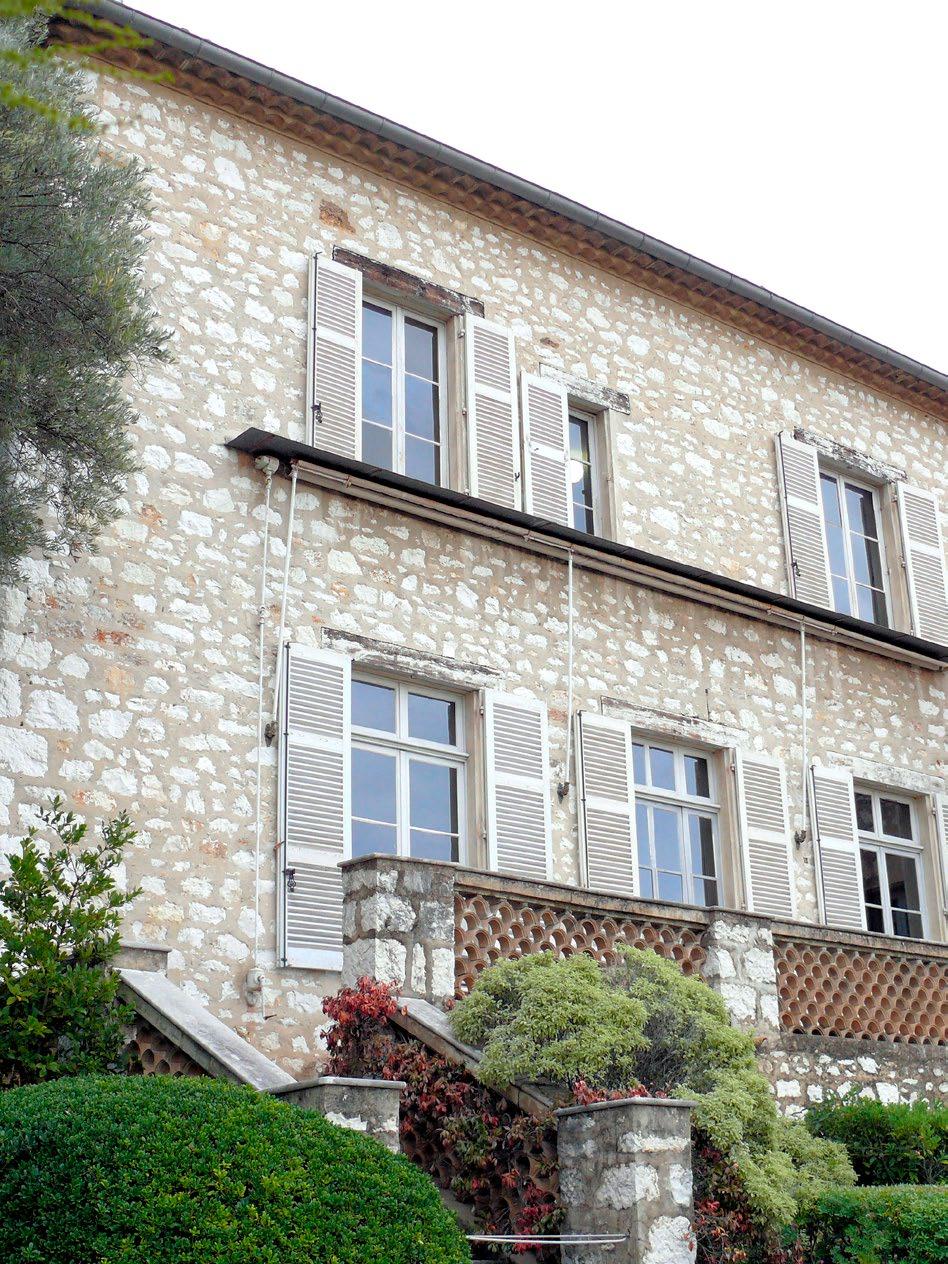
70 SANREMO IT
MUSEO RENOIR - VILLA RENOIR

A casa di Renoir
Cagnes-sur-Mer, la Montmartre della Costa Azzurra
Emanuela DHO
La sfavillante distesa di ulivi. Il profumo inebriante delle zagare. Il rassicurante abbraccio delle Alpi, alle spalle, e davanti il blu assoluto del mare. Le ruvide pietre del borgo medioevale di Haut-deCagnes. Il buen retiro di Pierre-Auguste Renoir al Domaine des Collettes, nella campagna circostante Cagnes-sur-Mer, è un luogo perduto nel tempo, come se gli anni avessero dimenticato di rincorrersi e il pittore fosse ancora lì, seduto sulla sua sedia ad aggiungere tocchi di colore sulla tela. Renoir vi si trasferì con la famiglia nel 1908, cercando sollievo ai malanni della vecchiaia incombente nel sole della Costa Azzurra e trovando nuova ispirazione nei mille riflessi della luce del sud. Non smise mai di dipingere, nonostante la paralisi degli arti inferiori lo avesse costretto sulla sedia a rotelle e l’artrite reumatoide gli avesse deformato le mani al punto da dovervi legare i pennelli. Non perse mai quella “joie de vivre” che caratterizzò tutta la sua opera, sebbene il dolore per la perdita della moglie e le preoccupazioni per i figli, feriti in guerra, avessero segnato i suoi ultimi anni. Anzi, durante la permanenza a Cagnes-sur-Mer Renoir si dedicò con entusiasmo alla pittura “en-pleinair”, facendosi spesso trasportare a spalla in mezzo all’uliveto per catturare la bellezza prorompente del paesaggio provenzale. Con le mani ormai rattrappite, si avvicinò anche alla scultura, spaziando tra busti, medaglioni, bassorilievi e statue, realizzati con l’aiuto del giovane Richard Guino, che lavorava seguendo fedelmente le indicazioni del maestro.
Oggi, alcune di queste opere, insieme ad
arredi originali, fotografie, lavori di amici e allievi, sono parte integrante del Musée Renoir, acquisito nel 1960 dal Comune e completamente restaurato nel 2013. La casa-museo comprende le stanze private dell’artista (la sala da pranzo, le camere, i bagni, la cucina), il Grand Atelier dove era solito dipingere e uno spazio al piano terra, dedicato alla scultura. Tutt’intorno, l’ampio giardino e gli ulivi secolari, traboccanti di luce, pace e silenzio, sono memoria vivente di un passato che non smette di incantare.
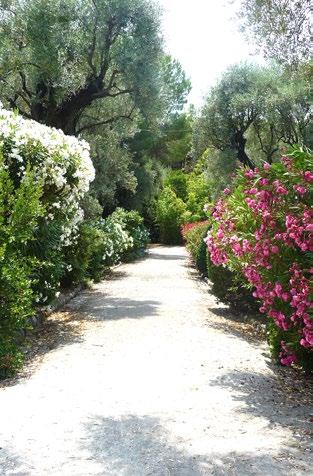
RENOIR
©CRT CÔTE D'AZUR FRANCE GIARDINI MUSEO
71 SANREMO IT

RENOIR’S HOME
CAGNES-SUR-MER, THE MONTMARTRE OF THE COTE D’AZUR
The magnificent expanse of olive trees. The sweet fragrance of orange blossoms. The reassuring embrace of the Alps framing the backdrop against the pure blue sea. The rustic stones of the medieval village of Haut-de-Cagnes.
Pierre-Auguste Renoir’s retreat, the Domaine des Collettes, is nestled in the countryside surrounding Cagnes-sur-Mer. Here, time seems to stand still, as if the years have forgotten to march on, leaving the painter himself still sitting in his chair, adding touches of colour to his canvas. In 1908, Renoir and his family sought solace


from the aches and pains of ageing by relocating to the sunny shores of the Cote d’Azur, where he found fresh inspiration in the myriad reflections of the southern light. Renoir never stopped painting, despite being confined to a wheelchair due to paralysis in his lower limbs and battling rheumatoid arthritis that deformed his hands to the point where he had to strap his brushes to them. He never lost the “joie de vivre” that characterised all his work, even though his last years were marked by the sorrow of losing his wife
and worrying about his sons during the war. During his stay in Cagnes-sur-Mer, Renoir enthusiastically dedicated himself to painting outdoors, often relying on others to carry him piggyback through the olive groves, allowing him to capture the vibrant beauty of the Provencal landscape. Despite his physical limitations, he also ventured into sculpture, creating busts, medallions, bas-reliefs and statues with the help of the young Richard Guino, who faithfully executed the master’s vision.
Some of these works, along with original furniture, photographs and works by friends and students, are now an integral part of the Renoir Museum, acquired by the Municipality in 1960 and fully restored in 2013.
The house-museum showcases the artist’s private spaces, including his dining room, bedrooms, bathrooms and kitchen, as well as the Grand Atelier where he painted and an area on the ground floor dedicated to his sculptures.
Surrounding the museum, the sprawling garden with ancient olive trees, overflowing with light, peace and silence, serves as a living reminder of a past that never ceases to enchant.
 © CRT CÔTE D'AZUR FRANCE|GEORGES VERAN
PIERRE-AUGUSTE RENOIR - LES VIGNES À CAGNES www.ville.cagnes.fr
© CRT CÔTE D'AZUR FRANCE|GEORGES VERAN
PIERRE-AUGUSTE RENOIR - LES VIGNES À CAGNES www.ville.cagnes.fr
72 SANREMO IT
PIERRE-AUGUSTE RENOIR - SELF-PORTRAIT, 1899, CLARK ART INSTITUTE
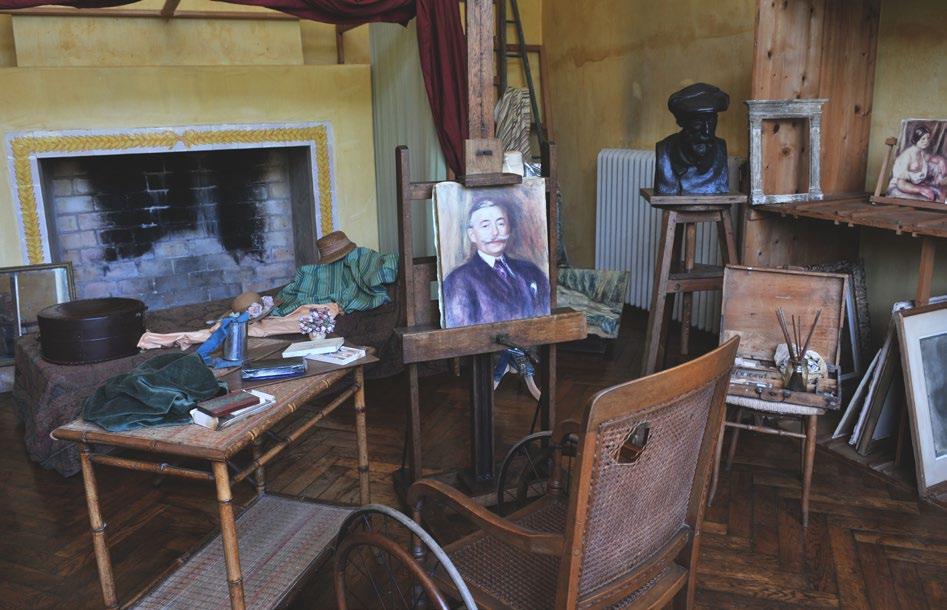
DANS LA MAISON DE RENOIR
CAGNES-SUR-MER, LE MONTMARTRE DE LA CÔTE D’AZUR
La chatoyante étendue d'oliviers. Le parfum enivrant des fleurs d'oranger. L'étreinte rassurante des Alpes, derrière, et devant le bleu absolu de la mer. Les pierres rugueuses du village médiéval du Haut-deCagnes. Le havre de paix de Pierre-Auguste Renoir au Domaine des Collettes, dans la campagne autour de Cagnes-sur-Mer, est un lieu perdu dans le temps, comme si les années avaient oublié de s'écouler et que le peintre était toujours là, assis sur sa chaise, apportant des touches de couleur sur la toile. Renoir s'y installa avec sa famille en 1908, cherchant à soulager les maux de la vieillesse proche, sous le soleil de la Côte d'Azur et trouvant une nouvelle inspiration dans la myriade de reflets de la lumière du Midi. Il ne cessa jamais de peindre, bien que la paralysie de ses membres inférieurs l'ait contraint à se déplacer en fauteuil roulant et que l'arthrite rhumatoïde ait déformé ses mains au point qu'il devait y attacher ses pinceaux. Il ne perdit jamais cette « joie de vivre » qui caractérisa l'ensemble de son œuvre, même si le chagrin causé par la perte de sa femme et l'inquiétude pour ses enfants, blessés
à la guerre, marquèrent ses dernières années. Au contraire, lors de son séjour à Cagnes-sur-Mer, Renoir se consacra avec enthousiasme à la peinture « en plein air », se faisant souvent porter à califourchon dans les oliveraies pour capter la beauté éclatante du paysage provençal. Ses mains désormais ratatinées, il aborde également la sculpture, entre bustes, médaillons, basreliefs et statues, réalisés avec l'aide du jeune Richard Guino, qui travaille en suivant fidèlement les instructions du maître. Aujourd'hui, quelques-unes de ces œuvres, ainsi que des meubles originaux, des photographies, des travaux d'amis et d'élèves, font partie intégrante du Musée Renoir, acquis en 1960 par la ville et entièrement restauré en 2013. La maisonmusée comprend les pièces privées de l'artiste (la salle à manger, les chambres, les salles de bains, la cuisine), le Grand Atelier où il peignait et un espace au rez-dechaussée, dédié à la sculpture. Tout autour, le grand jardin et les oliviers centenaires, débordant de lumière, de paix et de silence, sont la mémoire vivante d'un passé qui n'en finit pas de nous enchanter.

73 SANREMO IT
© CRT CÔTE D'AZUR FRANCE| GEORGES VERAN

Piazza Ruffini · Bordighera (IM)
su appuntamento · IT DE FR EN
+39 349 306 3154
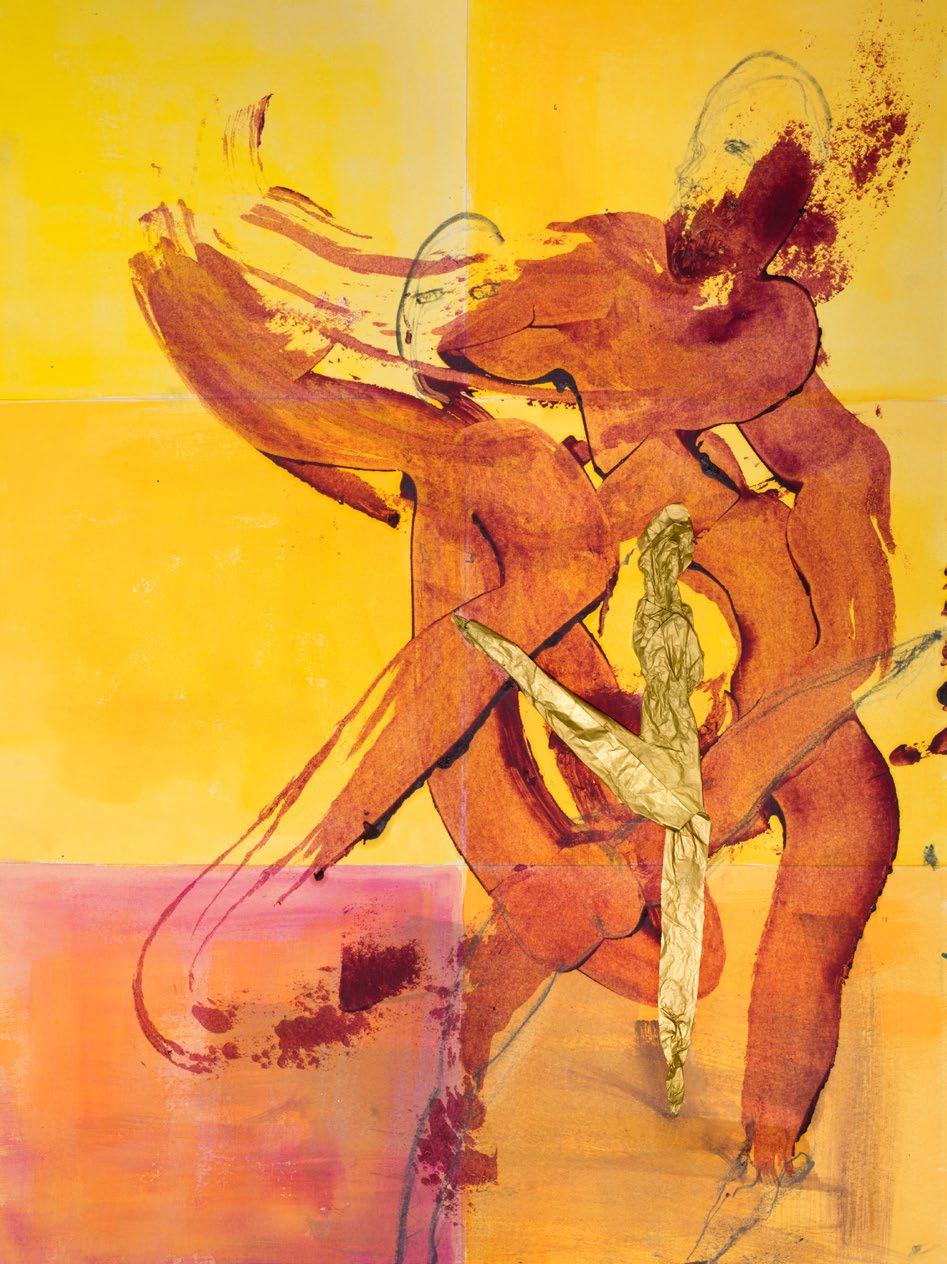
La danza della Liberazione 2021
ESPERIENZE D’ARTE Galleria

 Foto Stefano Lupi Firenze
Foto Stefano Lupi Firenze
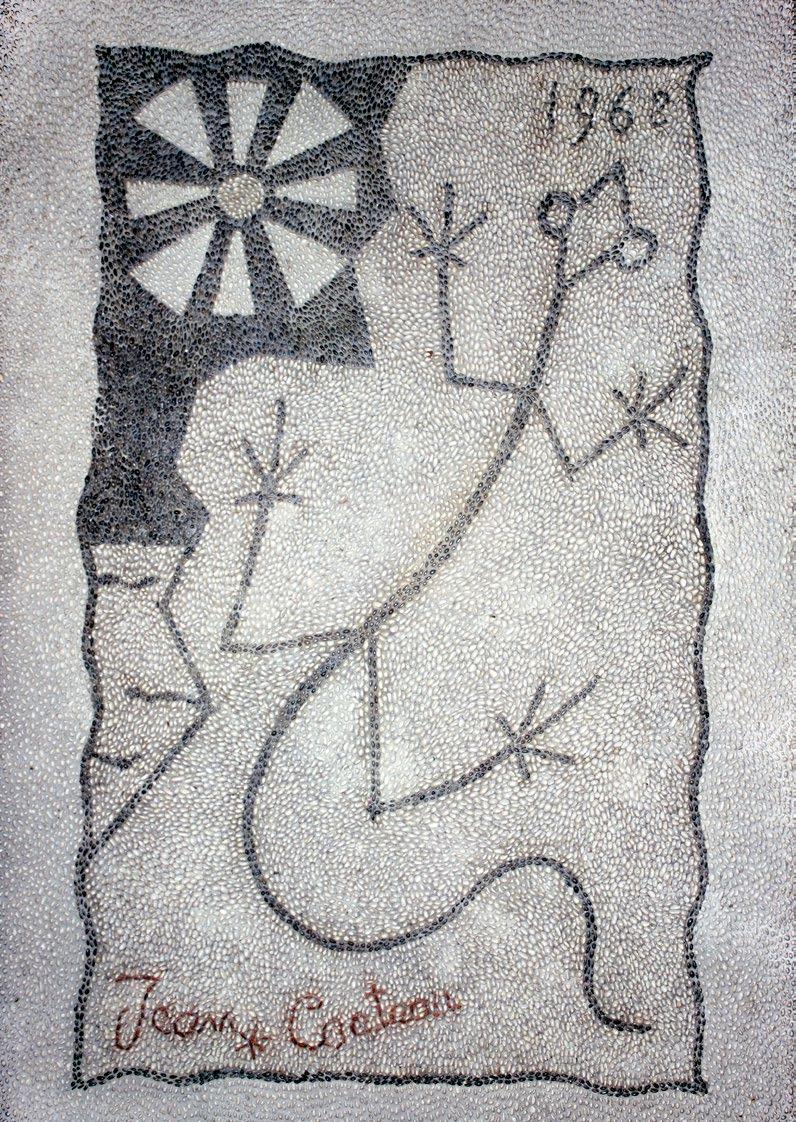
76 SANREMO IT
Emanuela DHO
Foto: ©Musée Jean Cocteau
collection Séverin Wunderman et ©Ville de Menton
“Je reste avec vous” IL MUSEO JEAN COCTEAU A MENTONE
Una fortezza sul mare, solide mura di pietra a racchiudere lo spirito di un artista capace di fuggire ogni definizione: disegnatore, pittore, ceramista, ma anche drammaturgo, sceneggiatore, attore e regista e soprattutto poeta, come egli stesso affermava: “perché ogni opera è poetica”.
Il Bastione Jean Cocteau a Mentone costituisce, più che un museo, un vero e proprio testamento artistico, che il poliedrico genio del Novecento ha voluto plasmare per dire alle generazioni future “Io resto con voi”, come recita l’epigrafe sulla sua tomba. Intrecciando la propria storia a quelle delle più importanti figure del panorama culturale francese ed europeo, da Picasso a Stravinskij, da Apollinaire a Man Ray, Jean Cocteau ha concentrato nella propria produzione le opposte tendenze e i rapidi mutamenti dell’epoca contemporanea.
Ha abbracciato con entusiasmo le spinte avanguardiste, coniugandole con gli archetipi classici, sempre ricercando nuovi e antichi linguaggi, tematiche nuove e antiche.
Fu lo stesso Cocteau, negli ultimi anni della propria vita, a curare restauro e allestimento del Bastione, portato a termine nel 1966 dall’erede Édouard Dermit secondo le istruzioni e i disegni dell’artista. Le pietre nude delle pareti, le linee essenziali e possenti del legno e del ferro, il calore domestico delle volte in mattoni accolgono la collezione originale, composta da oltre cento opere, più le numerose donazioni e acquisizioni successive, tra disegni coloratissimi, dipinti, litografie, giganteschi arazzi e ceramiche sorprendenti.
I due piani del Bastione raccontano la mente geniale dell’artista e la sua capacità di interpretare tutti gli aspetti del design, dalla decorazione degli spazi (come nella sala dei matrimoni di Mentone), alla divulgazione di messaggi (come nei numerosi manifesti), fino alla creazione di oggetti (come gli accessori di moda disegnati per Coco Chanel).
Jean Cocteau accoglie il visitatore nel suo mondo, popolato di figure che attraversano indenni i secoli, e lo accompagna in un tempo sospeso, pieno di colore e poesia, ripetendo ancora una volta: “Je reste avec vous”, che è anche il titolo della mostra attualmente in corso, visitabile fino al 17 giugno.

77 SANREMO IT

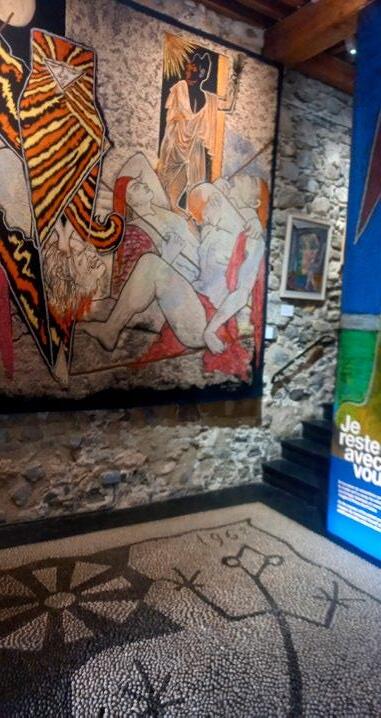
THE JEAN COCTEAU MUSEUM IN MENTONE
“JE RESTE AVEC VOUS” (I REMAIN WITH YOU)
A fortress by the sea, solid stone walls enclosing the spirit of an artist who eludes all definitions: draughtsman, painter, ceramist, but also playwright, scriptwriter, actor and director and, above all, a poet as he himself said, “because all work is poetic.” The Bastion Jean Cocteau in Mentone is more than just a museum; it stands as a profound artistic testimony created by a multifaceted genius of the 20th century. With his epitaph declaring, “I remain with you,” Cocteau communicates his enduring presence to future generations. In his works, Jean Cocteau interweaves his own story with those of the most influential figures in the French and European cultural scene, from Picasso to Stravinsky, from Apollinaire to Man Ray. He enthusiastically navigates the contrasting trends and rapid changes of modernity, embracing avant-garde impulses and combining them with classical archetypes. Continuously seeking out both new and ancient languages and themes, Cocteau leaves behind a legacy that resonates with timeless relevance.
In the final years of his life, Cocteau personally supervised the restoration and furnishing of the Bastion, which was completed
in 1966 by his heir, Édouard Dermit, following the artist’s precise instructions and sketches. The bare stone walls, complemented by the stark yet elegant lines of wood and iron, along with the cosy warmth of the brick vaults, serve as the backdrop for the original collection. This collection comprises over a hundred works, alongside numerous donations and subsequent acquisitions, encompassing colourful drawings, paintings, lithographs, enormous tapestries and intriguing ceramic pieces. The two floors of the Bastion tell the story of the artist’s brilliant mind and his ability to reinterpret all aspects of design, from the decoration of spaces (as in the Menton wedding hall) to the dissemination of messages (as in the numerous posters), and the creation of objects (like the fashion accessories designed for Coco Chanel).
Jean Cocteau welcomes visitors into his world, populated by figures untouched by the passage of centuries, and accompanies them into a suspended time full of colour and poetry, echoing the phrase “Je reste avec vous” (I remain with you), a sentiment that also serves as the title of the ongoing exhibition which runs until 17 June 2024.
78 SANREMO IT
Une forteresse au bord de la mer, de solides murs de pierre qui renferment l'esprit d'un artiste capable d'échapper à toutes les définitions : dessinateur, peintre, céramiste, mais aussi dramaturge, scénariste, acteur et metteur en scène, et surtout poète, comme il l'affirmait lui-même : « car chaque œuvre est poétique ». Le Bastion Jean Cocteau à Menton est plus qu'un musée, c'est un véritable testament artistique que le génie multiforme du XXe siècle a voulu façonner pour dire aux générations futures « Je reste avec vous », comme l'indique l'épigraphe sur sa tombe. Entremêlant sa propre histoire à celle des plus grandes figures de la scène culturelle française et européenne, de Picasso à Stravinsky, d'Apollinaire à Man Ray, Jean Cocteau a concentré dans sa production les tendances contraires et les mutations rapides de l'époque contemporaine. Il a accueilli avec enthousiasme les forces avantgardistes, les combinant avec les archétypes classiques, toujours à la recherche de nouveaux et anciens langages, de thèmes nouveaux et anciens. C'est Cocteau lui-même qui, dans les dernières années de sa vie, a suivi la restauration et l'aménagement du Bastion, achevés


en 1966 par son héritier Édouard Dermit selon les instructions et les dessins de l'artiste. Les pierres nues des murs, les lignes essentielles et puissantes du bois et du fer, la chaleur domestique des voûtes de briques accueillent la collection d'origine, composée de plus d'une centaine d'œuvres, auxquelles s'ajoutent de nombreux dons et acquisitions ultérieures, dont des dessins colorés, des peintures, des lithographies, des tapisseries gigantesques et des céramiques surprenantes. Les deux étages du Bastion racontent l'esprit génial de cet artiste et sa capacité à interpréter tous les aspects du design, de la décoration des espaces (comme dans la salle des mariages de Menton) à la diffusion de messages (comme dans les nombreuses affiches), en passant par la création d'objets (comme les accessoires de mode dessinés pour Coco Chanel).
Jean Cocteau accueille le visiteur dans son univers, peuplé de figures qui traversent indemnes les siècles, et l'accompagne dans un temps suspendu, empreint de couleurs et de poésie, en répétant une fois encore : « Je reste avec vous », qui est aussi le titre de l'exposition actuellement en cours, à voir jusqu'au 17 juin.



LE MUSÉE JEAN COCTEAU À MENTON « JE RESTE AVEC VOUS »
www.museecocteaumenton.fr
79 SANREMO IT
1952 - GIUSEPPE BALBO E JEAN COCTEAU @ARCHIVIO BALBO MUSEO IL BASTIONE - MENTONE
GIUSEPPE BIANCHERI e l’invenzione della Ferrovia delle Meraviglie
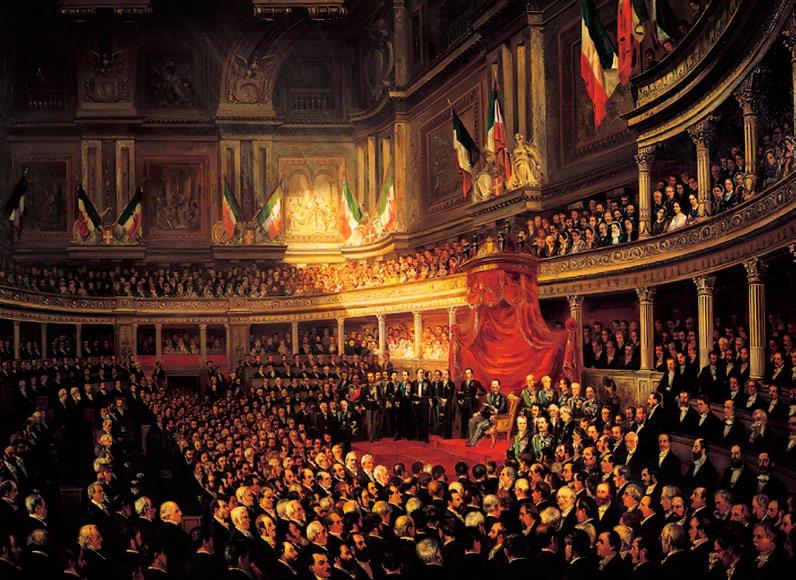
TORINO 1860 - INAUGURAZIONE PARLAMENTO 80 SANREMO IT
Alessandra CHIAPPORI
Sono meno di 50 km in linea d’aria, si arrampicano dal mare fino alle Alpi in un dislivello di mille metri sospeso tra affascinanti gole, tunnel e viadotti frutto di alta ingegneria.
Il tutto, in un territorio che fa dei confini la sua ricchezza.
La linea ferroviaria Cuneo-Ventimiglia, la “ferrovia delle meraviglie”, è al centro degli interessi dell’associazione Giuseppe Biancheri che ha il suo scopo nel nome: “Valorizzazione Ferrovia della Val Roya”. L’associazione nasce nel 2009 grazie a un’idea dello storico Erino Viola e da allora, forte di simpatizzanti, amici, ma anche appassionati di ferrovie, si batte per la promozione della storica linea che si snoda tra Liguria, Piemonte e Francia.
Con mostre, percorse misti in treno e bicicletta, pubblicistica dedicata e soprattutto con azioni di interlocuzione rivolte alle istituzioni locali e nazionali, l’associazione Biancheri è da sempre coinvolta in un’intensa attività di sensibilizzazione sul potenziale di una linea ferroviaria che racconta la storia e si propone come attrazione turistica in chiave sostenibile.

deputato nel Parlamento subalpino nel 1853. Fu proprio lui a proporre l’idea di costruire una ferrovia che unisse il territorio di Ventimiglia e di Cuneo: il progetto iniziale doveva snodarsi lungo la Valle Argentina, ma Biancheri pensò alla Val Roya, prevedendo un passaggio a Breglio, Breil-sur-Roya.
I lavori per la costruzione del percorso inizieranno nel 1882 e si protrarranno fino all’inaugurazione ufficiale del 30 ottobre 1928. La ferrovia delle meraviglie nasce dunque a ridosso del Risorgimento per arrivare nel cuore del Novecento, secolo che vedrà nuovamente cambiare i confini territoriali su cui il treno “di Biancheri” seguirà la propria strada.
Certo è che, alla sua nascita, la CuneoVentimiglia aveva una funzione strategica, sia politicamente che economicamente: collegare il Piemonte e l’allora sabauda Nizza poteva favorire gli scambi, di certo più rapidi rispetto al passaggio per le tortuose vie del sale.
Se l’associazione prende il nome da Giuseppe Biancheri non è un caso: classe 1821, dopo gli studi a Torino Biancheri divenne
Sono trascorsi decenni e la funzione di questo tratto ferroviario è certamente cambiata, ma non la sua potenzialità di collegamento spettacolare e rispettoso dell’ambiente tra paesaggi mozzafiato, nel cuore di una terra tutta da scoprire.

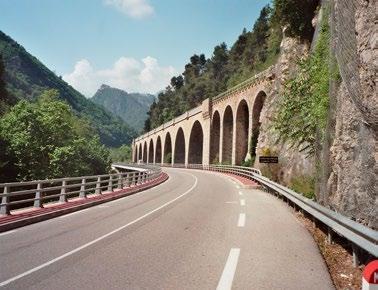
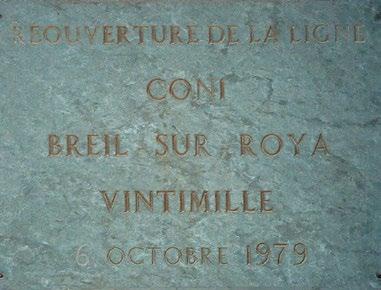
81 SANREMO IT
GIUSEPPE BIANCHERI AND THE INVENTION OF THE “FERROVIA DELLE MERAVIGLIE”
(RAILWAY OF WONDERS)
Less than 50 km as the crow flies, the “Railway of Wonders” ascends from the sea to the Alps in a thousand-metre drop suspended between captivating gorges, tunnels and viaducts that are the result of advanced engineering. All this takes place in a territory where borders enrich its landscape. The Cuneo-Ventimiglia railway line, also known as the “Ferrovia
of constructing a railway that would link Ventimiglia and Cuneo. Initially planned to traverse Valle Argentina, Biancheri foresaw the potential of the Val Roya route, specifically envisioning a passage at Breglio, Breil-sur-Roya. Construction on the route commenced in 1882 and lasted until its official inauguration on 30 October 1928.

delle Meraviglie,” is the focal point of the Giuseppe Biancheri association, whose goal is the “Enhancement of the Val Roya Railway.” Founded in 2009 under the guidance of historian Erino Viola, the association has rallied supporters, friends and railway enthusiasts to champion and promote the historic line that runs between Liguria, Piedmont and France.
Through exhibitions, mixed train and bicycle tours, targeted publicity, and, most importantly, engagement with local and national institutions, the Biancheri Association has consistently advocated for the potential of the railway line. Their efforts focus on highlighting its historical significance and promoting it as a sustainable tourist attraction.
It’s no coincidence that the association is named after Giuseppe Biancheri. Born in 1821, after his studies in Turin, Biancheri became a deputy in the Subalpine Parliament in 1853. He was the visionary who first proposed the concept
Thus, the birth of the Railway of Wonders coincided with the era of the Risorgimento, extending into the heart of the 20th century, a period marked by further changes in territorial borders along the path of “Biancheri’s” train. What is certain is that the Cuneo-Ventimiglia railway initially had a strategic function, both politically and economically. Connecting Piedmont with the then-Savoy city of Nice would facilitate trade, offering a faster alternative to the winding salt roads. Decades have passed, and the function of this railway line has certainly changed, but not its potential as a spectacular and eco-friendly link between breathtaking landscapes in the heart of a land waiting to be explored.


82 SANREMO IT
GALLERIA SAN BERNARDO
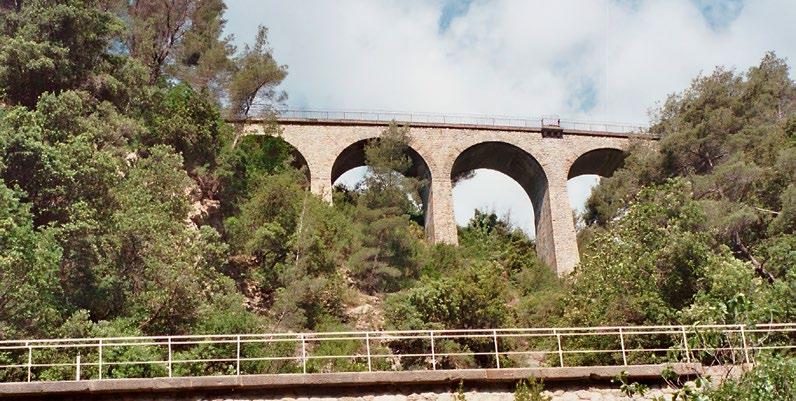
GIUSEPPE BIANCHERI ET L’INVENTION DU CHEMIN DE FER DES MERVEILLES
Les kilomètres, à vol d'oiseau, sont moins 50, et ils grimpent de la mer aux Alpes sur un dénivelé de mille mètres, en suspension entre des gorges fascinantes, des tunnels et des viaducs qui sont le résultat d'une ingénierie de haut niveau. Tout cela, dans une région qui fait des frontières sa richesse. La ligne ferroviaire Coni-Vintimille, le « Chemin de fer des merveilles », est au centre des intérêts de l'association Giuseppe Biancheri, dont l'objectif se résume dans le nom : « Mise en valeur du chemin de fer de la Vallée de la Roya ». L'association a été créée en 2009 d’après une idée de l'historien Erino Viola et, depuis lors, avec le concours de sympathisants, d'amis et de passionnés de chemin de fer, elle se bat pour promouvoir la ligne historique qui relie la Ligurie, le Piémont et la France.
À travers des expositions, des parcours mixtes ferroviaires et cyclistes, une publicité dédiée et, surtout, des actions interlocutrices auprès des institutions locales et nationales, l'association Biancheri est depuis toujours impliquée dans d'intenses activités de sensibilisation concernant le potentiel d'une ligne ferroviaire qui raconte l'histoire et se profile en tant qu'attraction touristique dans une optique durable. Si l'association porte le nom de Giuseppe Biancheri, ce n'est pas un hasard : né en 1821, Biancheri, après ses études à Turin, devient député au Parlement subalpin en 1853. C'est lui qui proposa l'idée de construire un chemin de fer pour relier le
territoire de Vintimille à celui de Coni : le projet initial prévoyait de remonter la Vallée Argentina, mais Biancheri pensa à la Vallée de la Roya, envisageant un passage à Breglio, Breil-sur-Roya.
Les travaux de construction du tracé commencèrent en 1882 et durèrent jusqu'à son inauguration officielle, le 30 octobre 1928. Le Chemin de fer des merveilles est donc né peu après le Risorgimento pour arriver au cœur du XXe siècle, un siècle qui verra à nouveau des changements dans les
frontières territoriales sur lesquelles le train « de Biancheri » suivra son chemin. Ce qui est certain, c'est qu'à sa naissance, la liaison Coni-Vintimille avait une fonction stratégique, tant sur le plan politique qu'économique : relier le Piémont à la ville de Nice, alors savoyarde, pouvait faciliter les échanges commerciaux, certainement plus rapides que de passer par les tortueuses routes du sel.
Des décennies se sont écoulées et la fonction de ce tronçon de chemin de fer a certainement changé, mais pas son potentiel en tant que liaison spectaculaire et respectueuse de l'environnement entre des paysages à couper le souffle, au cœur d'un territoire qui ne demande qu'à être découvert.


www.fondazionebiancheri.it
83 SANREMO IT

84 SANREMO IT
Alessandra CHIAPPORI
scoprendo l’Osservatorio di Imperia Dai tre Nobel al clima che cambia
Ha festeggiato i suoi primi 148 anni di attività con l’ingresso ufficiale nella World Meteorological Organization: l’Osservatorio Meteorologico e Sismico di Imperia, dedicato a Carlo Gentile, farmacista e appassionato di scienza che lo guidò per anni, vanta una storia che intreccia curiosità e rigore scientifico. Fondato nel 1875, oggi tra le istituzioni storiche più antiche d’Italia, l’Osservatorio di Imperia si distinse da subito per qualità e potenziale: ne fu avallato il rigore da padre Francesco Denza, fondatore della Società Meteorologica Italiana, e i dati rilevati arrivavano quotidianamente a Roma per il “Bollettino Meteorico Giornaliero” dell’Ufficio Centrale di Meteorologia. Le prime rilevazioni risalgono al 1° dicembre 1875: da lì, una serie che non si interruppe nemmeno con il terremoto del

1887. Fu allora che l’Osservatorio acquisì le strumentazioni che ne modificarono la denominazione in “Meteorologico e sismico”. Nonostante il periodo critico vissuto dal 1943 alla Liberazione, l’istituto si riprese grazie alla passione di tanti volontari. Nelle sue stanze, collocate intorno alla torretta dell’attuale edificio scolastico di piazza Roma, si incontrano le testimonianze di oltre un secolo di misurazioni, ma anche strumentazioni curiose, dagli anemometri ai telescopi. Spicca una foto del Premio Nobel Renato Dulbecco. Pochi sanno infatti che all’Osservatorio di Imperia mosse i primi passi il liceale Dulbecco, che frequentava il cenacolo culturale creatosi intorno a queste stanze già meta di Giulio Natta e Salvatore Quasimodo, il primo imperiese “padre” della plastica, il secondo siciliano

in trasferta a Imperia per lavoro. Tra gli amici dell’Osservatorio ci sarebbero quindi tre nomi da Nobel.
Come tutti gli Osservatori, anche quello imperiese nasce con uno scopo di ricerca: da qui deriva il riconoscimento dell’Organizzazione Mondiale per la Meteorologia per la collezione storica di dati.
La ricaduta sugli studi climatologici di questo patrimonio scientifico risulta oggi, alla luce di quasi 150 anni di registrazioni, decisiva: è dal set di dati, giornalmente trasmessi dal 2003 all’ARPAL, che derivano le previsioni del tempo, ma è anche grazie a queste preziose fonti, capaci di riportare indietro di decenni, che è possibile studiare l’evoluzione del clima per capire i trend ed evidenziare le anomalie che sempre più caratterizzano il pianeta.

RENATO DULBECCO SALVATORE QUASIMODO 85 SANREMO IT
GIULIO NATTA
FROM THREE NOBEL LAUREATES TO THE CHANGING CLIMATE DISCOVERING THE OBSERVATORY OF IMPERIA
The Meteorological and Seismic Observatory of Imperia recently marked its 148th year of activity with its official induction into the World Meteorological Organisation. Dedicated to Carlo Gentile, a passionate chemist and science enthusiast who served as its leader for many years, the observatory boasts a rich history that weaves together the spirit of inquiry and scientific rigour. Established in 1875 and now one of Italy’s oldest historical institutions, the Observatory of Imperia quickly gained recognition for its excellence and potential, earning praise from Father Francesco Denza, founder of the Italian Meteorological Society. Daily data collected at the observatory was dispatched to Rome for the publication of the “Daily Weather Bulletin” by the Central Meteorological Office.
The observatory’s initial surveys commenced on 1 December 1875 and continued uninterrupted, even in the aftermath of the earthquake of 1887. Following this event, the observatory acquired the instruments that changed its name to “Meteorological and Seismic.” Despite facing challenges during the tumultuous period from 1943 until Liberation, the observatory persevered, largely thanks to the passion and dedication of numerous volunteers. Housed within the turret of the current school building in Piazza Roma, its rooms hold over a century’s worth of measurements and an array of fascinating instruments, including anemometers and telescopes. Notably, a photograph of Nobel laureate Renato Dulbecco adorns its walls.
Few are aware that Dulbecco, while still in high school, was a regular attendee at the Observatory’s cultural gatherings, which had previously hosted notable figures such as Giulio Natta and Salvatore Quasimodo. Natta, known as the “father” of plastic, hailed from Imperia, while Quasimodo, a Sicilian, visited Imperia for business purposes.
As a result of these connections, the Observatory could count three Nobel Prize winners among its friends.
The Observatory of Imperia, like others of its kind, was founded for research purposes and has garnered recognition from the

World Meteorological Organisation for its historical data collection. Today, this scientific heritage has a profound impact on climatological studies, providing nearly 150 years of invaluable recordings. These data not only form the basis of weather forecasts, which have been transmitted
daily to ARPAL since 2003, but also serve as invaluable sources for studying climate evolution.
By tapping into these historical records spanning decades, researchers can identify trends and anomalies that increasingly characterise our planet.
86 SANREMO IT
FOTO ©STEFANO ASCHERI
DES TROIS NOBEL
AU CLIMAT QUI CHANGE À LA DÉCOUVERTE DE L’OBSERVATOIRE D’IMPERIA
Il a célébré ses 148 premières années d'activité en entrant officiellement dans la World Meteorological Organisation, c’est l'Observatoire météorologique et sismique d'Imperia, dédié à Carlo Gentile, le pharmacien et passionné de science qui l'a dirigé pendant des années, peut s'enorgueillir d'une histoire où se mêlent curiosité et rigueur scientifique. Fondé en 1875, et figurant aujourd'hui parmi les plus anciennes institutions historiques d'Italie, l'Observatoire d'Imperia s'est immédiatement distingué par sa qualité et son potentiel : sa rigueur a été cautionnée par le père Francesco Denza, fondateur de la Société météorologique italienne, et les données recueillies parvenaient quotidiennement à Rome pour le « Bollettino Meteorico Giornaliero », autrement dit, le bulletin météorologique quotidien de l'Office central de météorologie. Les premiers relevés remontent au 1er décembre 1875 : une série qui ne s'est pas arrêtée, même avec le tremblement de terre de 1887. C'est alors que l'Observatoire a acquis les instruments qui ont changé son nom en « Météorologique et Sismique ». Bien qu'il ait connu une période critique de 1943 à la Libération, l'institut a su se relever grâce à la passion de nombreux bénévoles. Dans ses salles, situées autour de la tourelle de l'actuel bâtiment de l'école de Piazza Roma, on trouve des témoignages de plus d'un siècle de mesures, ainsi que de curieux instruments, des anémomètres aux télescopes. On peut y voir une photo de Renato Dulbecco, lauréat du prix Nobel. Peu de gens savent, en effet, que le lycéen Dulbecco a fait ses premiers pas à l'Observatoire d'Imperia, qu'il a fréquenté le cercle culturel créé autour de ces salles déjà fréquentées par Giulio Natta et Salvatore Quasimodo, le premier originaire d'Imperia, le « père » du plastique, le second, sicilien en déplacement à Imperia pour son travail. Parmi les amis de l'Observatoire, il y aurait donc trois noms lauréats du prix Nobel. Comme tous les observatoires, celui d'Imperia a été créé dans un but de recherche : d'où la reconnaissance de l'Organisation météorologique mondiale pour sa collecte historique de données. Aujourd'hui, à la lumière de près de 150 ans d'enregistrements, les retombées de

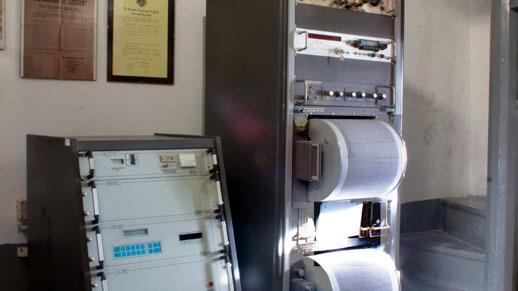
ce patrimoine scientifique sur les études climatologiques sont décisives : c'est à partir de l'ensemble des données, transmises quotidiennement depuis 2003 à l'ARPAL, que sont établies les prévisions météorologiques, mais c'est aussi grâce
à ces précieuses sources, capables de remonter des décennies en arrière, qu'il est possible d'étudier l'évolution du climat afin de comprendre les tendances et de mettre en évidence les anomalies caractérisant toujours plus la planète.
FOTO ©STEFANO ASCHERI
87 SANREMO IT
FOTO ©STEFANO ASCHERI
Luoghi suggestivi della Riviera per i matrimoni civili
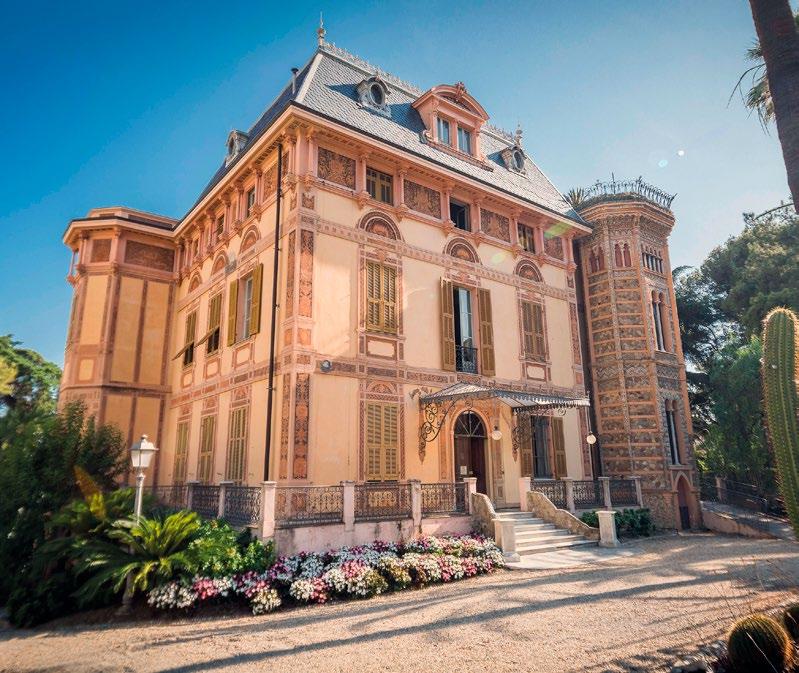 Anna Maria CASTELLANA
Anna Maria CASTELLANA
88 SANREMO IT
SANREMO, VILLA NOBEL
La Riviera dei Fiori ha tutte le caratteristiche per rendere indimenticabile un matrimonio civile. Affinché l'unione sia valida, la celebrazione deve avvenire pubblicamente in Comune o nelle Case Comunali davanti all'ufficiale di Stato
Civile in seguito alle pubblicazioni. Fra i luoghi più suggestivi a Ventimiglia c'è il Forte dell'Annunziata, fatto costruire dai Savoia nel XIX secolo, che vanta una vista mozzafiato sul Santuario Pelagos e sul porto. A Bordighera l'ex Chiesa Anglicana ha un fascino old style: tra Otto e Novecento Clarence Bicknell, il poliedrico studioso britannico, vi giunse appositamente per officiare. Dal 2024 si sono aggiunte l'Arena della Scibretta, all'ombra del monumentale Ficus macrophylla, la splendida terrazza del Marabutto e la rotonda sul mare di Sant'Ampelio. A Sanremo, oltre alla sala matrimoni di Palazzo Bellevue e alla sede degli uffici di Stato Civile all'interno del Palafiori, si annoverano Villa Ormond, il cui vasto parco botanico ospita esemplari provenienti da tutto il mondo e più di 50 specie di palme, Villa Luca a Coldirodi, che custodisce la preziosa Pinacoteca Rambaldi e Villa Nobel, che fu scelta come "nido" dal chimico svedese Alfred Nobel, il quale proprio qui ebbe l'idea di istituire un Premio annuale per chi avesse reso il miglior servizio all'umanità per la Fisica, la Chimica, la Medicina, la Letteratura e la Pace. Al Casinò Municipale, il primo in Italia, si può optare per il privé o la sala Biribissi, ma anche per il Roof Garden. Anche Imperia offre un'ampia rosa di


scelte. C’è per esempio Villa Grock, voluta in collina dal clown di fama internazionale Adrien Wettach, in arte Grock, edificio che, con il giardino e i suoi giochi d'acqua, riflette l’eclettica personalità del proprietario.
Oppure, ancora, l'elegante Villa Faravelli, sede del Museo di arte contemporanea, ma anche la Palazzina Liberty sul molo di ponente di Porto Maurizio e la Torre Saracena, che domina il borgo di Torrazza, in mezzo a ulivi e ginestre. A breve, infine, dopo un importante lavoro di riqualificazione, riaprirà i battenti il Ridotto del Teatro Cavour.
SANREMO, VILLA LUCA
89 SANREMO IT
SANREMO, VILLA ORMOND
ENCHANTING VENUES ON THE RIVIERA FOR CIVIL WEDDINGS
The Riviera dei Fiori (Riviera of Flowers) offers an array of stunning locations perfect for unforgettable civil weddings. To ensure the validity of the marriage, ceremonies must be conducted in a public setting, such as the Municipal Hall or Municipal Houses, officiated by a civil registrar following the proper publication procedures. In Ventimiglia, couples can exchange vows amidst the stunning backdrop of Forte dell'Annunziata, a 19th-century fortress built by the Savoy family that offers panoramic views of the Pelagos Sanctuary and the port. In Bordighera, the former Anglican Church exudes an old-world charm, once frequented by the renowned British scholar, Clarence Bickness in the late 19th and early 20th centuries. Since 2024, additional venues have become available, such as the Scibretta Arena nestled beneath the majestic Ficus macrophylla, along with the splendid terrace and seaside rotunda of Sant'Ampelio. Sanremo offers an array of options, including the wedding hall in Palazzo Bellevue, Civil Registry Offices within the Palafiori, and Villa Ormond, featuring a vast botanical park with specimens from around the globe and over 50 species of palm trees.
Couples can also consider Villa Luca in Coldirodi, which houses the esteemed Pinacoteca Rambaldi, and Villa Nobel, once the “nest” of Swedish chemist Alfred Nobel and where he conceived the idea of establishing an annual prize for individuals who have made outstanding contributions to humanity in physics, chemistry, medicine, literature and peace. The Municipal Casino, the first of its kind in Italy, offers the exclusive privé room, the elegant Biribissi hall, and the picturesque Roof Garden. Imperia also boasts a wide range of locations, including Villa Grock, a hillside estate built by the world-renowned
clown Adrien Wettach, also known as Grock. Reflecting its owner’s eclectic personality, the villa features stunning gardens and water features. Other options include the elegant Villa Faravelli, home to the Museum of Contemporary Art, as well as the Palazzina Liberty situated on
the western pier of Port Maurizio and the Saracen Tower which dominates the village of Torrazza amidst olive trees and broom. Lastly, the Ridotto of the Cavour Theatre, which is set to reopen soon after major renovations, provides yet another exquisite venue for civil weddings.

 VENTIMIGLIA, FORTE DELL'ANNUNZIATA
VENTIMIGLIA, FORTE DELL'ANNUNZIATA
90 SANREMO IT
IMPERIA, VILLA GROCK

LIEUX SUGGESTIFS DE LA RIVIERA POUR LES MARIAGES CIVILS
La Riviera dei Fiori présente toutes les caractéristiques pour rendre un mariage civil inoubliable. Pour que l'union soit valide, la célébration doit avoir lieu publiquement à la Mairie ou dans les Maisons communales devant l'officier de l'état civil après la publication des bans. Parmi les lieux les plus remarquables, à Vintimille, le Forte dell'Annunziata, construit par la Maison de Savoie au XIXe siècle, offre une vue imprenable sur le Sanctuaire Pelagos et le port. À Bordighera, on trouve l'ancienne église anglicane au charme old style : entre le XIXe et le XXe siècle, Clarence Bicknell, l'érudit britannique aux multiples facettes, y est venu spécialement pour officier. Depuis 2024, se sont ajoutés l'Arena della Scibretta, à l'ombre du monumental
Ficus macrophylla, la splendide terrasse du Marabutto et la rotonde balnéaire de Sant'Ampelio. À Sanremo, outre la salle des mariages du Palazzo Bellevue et le siège des bureaux de l'état civil à l'intérieur du Palafiori, on trouve la Villa Ormond, dont le vaste parc botanique comprend des spécimens du monde entier et plus de 50 espèces de palmiers, la Villa Luca à Coldirodi qui accueille la précieuse galerie d'art Rambaldi, et la Villa Nobel, qu’a choisie comme « nid » le chimiste suédois Alfred Nobel, qui eut l'idée d'instituer un prix annuel pour ceux qui avaient rendu les meilleurs services à l'humanité dans les domaines de la physique, de la chimie, de la médecine, de la littérature et de la paix. Au Casino Municipal, le premier en Italie, on peut opter non seulement pour la salle
privée ou la salle Biribissi, mais aussi pour le Roof Garden. Imperia offre également un large éventail de choix. Il y a, par exemple, la Villa Grock, construite dans les collines par le clown internationalement connu Adrien Wettach, alias Grock, un bâtiment qui, avec son jardin et ses jeux d'eau, reflète la personnalité éclectique de son propriétaire.
Ou encore l'élégante Villa Faravelli, qui abrite le musée d'art contemporain, ainsi que le bâtiment de style Art nouveau sur la jetée ouest de Porto Maurizio et la Tour Sarrasine, qui domine le village de Torrazza, au milieu des oliviers et des genêts.
Enfin, le Ridotto du Teatro Cavour rouvrira prochainement ses portes après d'importants travaux de modernisation.
91 SANREMO IT
BORDIGHERA, EX CHIESA ANGLICANA
IL PALAFIORI DI SANREMO

92 SANREMO IT
Luca GIOVANNETTI
Nel cuore di Sanremo, a pochi passi da Piazza Colombo e dal Teatro Ariston, si trova il Palafiori, un vasto e moderno spazio multifunzionale dedicato a conferenze, mostre ed eventi. Frutto di una completa e complessa ristrutturazione dell’edificio un tempo adibito a Mercato dei Fiori di Sanremo, struttura poi trasferita in Valle Armea, il Palafiori ha aperto i suoi battenti nel giugno 2006. In tutti questi anni di attività, con alti e bassi segnati da rallentamenti per via di problemi di gestione, il Palafiori ha ospitato numerosi eventi di rilievo, tra cui importanti conferenze e manifestazioni- Casa Sanremo, per esempio, la “casa” ufficiale del Festival, il più grande e longevo contenitore di accoglienza e spettacolo dedicato alla kermesse canora, realizzato da Gruppo Eventi. Di proprietà del Comune, il Palafiori è stato affidato nel 2020 all’Orchestra Sinfonica di Sanremo che nel 2022 ha lanciato un bando per la sua gestione annuale. A vincerlo è stato, a inizio 2023, Gruppo Eventi, che ne è diventato il gestore fino alla fine del 2024.
Questa versatile struttura di oltre 5.000 metri quadri, suddivisi su 4 piani, di cui 800 mq di terrazze con tende ombreggianti, dà il meglio di sé con eventi che prevedono grandi affluenze di persone. Il Palafiori permette infatti di organizzare vari tipi di eventi contemporaneamente: conferenze, convegni, convention, seminari, mostre, lancio di prodotti, banchetti, cene di gala e spettacoli, il tutto in un'atmosfera armoniosa. L’edificio è dotato di tutte le risorse e i comfort necessari per garantire il successo di qualsiasi evento, tra cui parcheggio interno, e poi montacarichi, scale mobili e accesso agevolato per le persone con disabilità, ma anche cucina professionale attrezzata e linea di lavaggio, accessi veicolari, ascensori di servizio, magazzini, disimpegni vari nonché uffici. A completare il tutto, un parcheggio pubblico interrato di due piani con oltre 500 posti.
Progettato come una struttura flessibile, il Palafiori è oggi il luogo ideale per organizzare grandi eventi grazie agli spazi agili e a tutte le sue risorse a disposizione.
Maggiori informazioni su: www.palafiori.com.


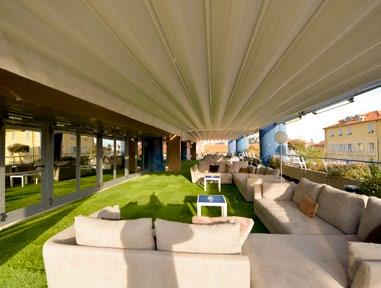
Le aree disponibili del Palafiori: Piano terra
• Ingresso, Hall EXPO
• Area Reception EXPO
• Uffici
• Ascensore panoramico
Primo piano
Ambiente EXPO
• Disimpegno / Mezzanino
Ambiente Pubblico
• Uffici Demografici e Sala Matrimoni
• Uffici ASL
Secondo Piano - EXPO
• Sala Ranuncolo (180 mq)
• Sala Expo Gardenia (800 mq)
• Sala Museale (Area espositiva - 235 mq)
• Le Terrazze - Terrazza Ortensia (500 mq)
• Accessi veicolari e magazzini
Terzo Piano - EXPO
• Sala Plenaria Ninfea (690 mq), con possibilità di ridurre lo spazio (435 mq)
• Sala/Area Catering Papavero (302 mq)
• Sala/Area Catering Narciso (800 mq)
• Le Terrazze - Terrazza Anemone (300 mq)
• Cucina professionale con frighi, linea lavaggio, ascensore per forniture.
93 SANREMO IT
THE PALAFIORI OF SANREMO
Located in the heart of Sanremo, just a stone’s throw away from Piazza Colombo and the Ariston Theatre, the Palafiori is a spacious and modern multifunctional venue designed for conferences, exhibitions and events.
Originally the site of the Sanremo Flower Market, which was later transferred to Valle Armea, the building underwent a major renovation before the Palafiori opened its doors in June 2006.
Throughout its years of operation, with ups and downs marked by slowdowns due to management problems, the Palafiori has played host to numerous important conferences and exhibitions. Notably, it has been home to Casa Sanremo, the official “hub” of the Festival, the largest and longest-running reception and entertainment venue dedicated to the song festival, created by Gruppo Eventi.
Owned by the Municipality, the Palafiori was entrusted to the Sanremo Symphony Orchestra in 2020, and in 2022, a tender was initiated for the annual management of the venue.
By early 2023, Gruppo Eventi secured the contract and took over management responsibilities until the end of 2024.
This versatile structure spans over 5,000 square metres across four
floors, featuring 800 sqm of terraces with shade curtains. Its full potential shines brightest during events that draw large crowds. In fact, the Palafiori excels at hosting a variety of simultaneous events, including conferences, conventions, seminars, exhibitions, product launches, banquets, gala dinners, and shows, all in a harmonious atmosphere.
The building is equipped with all the resources and comforts necessary to ensure the success of any event, such as an internal carpark, lifts, escalators and accessible facilities for people with disabilities, as well as a fully equipped professional kitchen and washing line, vehicle access service lifts, storage rooms, utility rooms and offices.
This is all complemented by a two-level underground carpark with more than 500 spaces.
Designed with flexibility in mind, Palafiori has evolved into the premier venue for organising major events, offering agile spaces and ample resources to meet diverse meets.
For further details, visit www.palafiori.com.



94 SANREMO IT
LE PALAFIORI DE SANREMO
C’est au cœur de Sanremo, à quelques pas de la Piazza Colombo et du théâtre Ariston, que se trouve le Palafiori, un vaste espace multifonctionnel moderne, dédié aux conférences, aux expositions et aux événements.
Résultat d'une rénovation complète et complexe de l'édifice qui autrefois abritait le marché aux fleurs de Sanremo, structure transférée par la suite dans la vallée de l'Armea, le Palafiori a ouvert ses portes en juin 2006. Au cours de toutes ces années d'activité, avec des hauts et des bas marqués par des ralentissements dus à des problèmes de gestion, le Palafiori a accueilli de nombreux événements d'envergure, y compris d'importantes conférences et manifestations - Casa Sanremo, par exemple, la « maison » officielle du Festival, le plus grand et le plus ancien établissement de réception et de divertissement dédié à cette fête de la chanson, réalisé par Gruppo Eventi. Propriété de la municipalité, le Palafiori a été confié en 2020 à l'Orchestre symphonique de Sanremo, qui a lancé en 2022 un appel d'offres pour sa gestion annuelle. Celui-ci a été remporté début 2023 par Gruppo Eventi, qui en est devenu le gestionnaire jusqu'à fin 2024.
Cette structure polyvalente de plus de 5 000 mètres carrés, répartis sur 4 étages, dont 800 mètres carrés de terrasses avec tentes d'ombrage, est idéale pour les événements qui attirent un public nombreux. Le Palafiori permet, en effet, d'organiser simultanément différents types d'événements : conférences, congrès, conventions, séminaires, expositions, lancements de produits, banquets, dîners de gala et spectacles, le tout dans une atmosphère harmonieuse. Ce bâtiment est doté de toutes les ressources et de tout le confort nécessaires pour garantir le succès de tout événement, y compris un parking interne, des monte-charges, des escaliers roulants et un accès facile pour les personnes handicapées, ainsi qu'une cuisine professionnelle entièrement équipée et avec une ligne de lavage, un accès pour les véhicules, des ascenseurs de service, des entrepôts, divers débarras et des bureaux. Enfin, un parking public souterrain de deux étages comptant plus de 500 places complète l'ensemble. Conçu comme une installation flexible, le Palafiori est désormais l'endroit idéal pour organiser de grands événements grâce à ses espaces agiles et à toutes les ressources disponibles. Plus d'informations sur : www.palafiori.com.




www.palafiori.com 95 SANREMO IT

N.G.I. Navigazione Generale Italiana, Genova Italia - New York 1921, Ettore Mazzini 49 x 67 cm
Courtesy Galleria L’IMAGE - Manifesti originali del XX secolo / Original vintage posters
www.posterimage.it
Piazza dei Partigiani, 16 - 17021 Alassio (SV) - Tel. +39-0182-644362
Facebook Galleria L’Image Alassio - Instagram gallerialimage
















ARTICOLI PER L’INFANZIA E LA PUERICULTURA
































 SANREMO - ALASSIO - PORTOFINO - SANTA MARGHERITA LIGURE
SANREMO - ALASSIO - PORTOFINO - SANTA MARGHERITA LIGURE




















 CANTIERE, 1955.
CARLO DAPPORTO E LA SUA COMPAGNIA METTONO IN SCENA GIOVE IN DOPPIOPETTO, DICEMBRE 1963.
1° CAMPIONATO EUROPEO DI BILIARDO, OTTOBRE 1986.
PAVAROTTI CHIACCHIERA CON WALTER VACCHINO DURANTE LE PROVE DEL SUO CONCERTO, FEBBRAIO 1988
LA PLATEA NEI GIORNI SURREALI DEL FESTIVAL 2021.
SINFONICA DI SANREMO DIRETTA DAL MAESTRO CARLO FARINA, 31 MAGGIO 1963.
PUGILE NINO BENVENUTI POCHE ORE PRIMA DI COMBATTERE CONTRO DON FULLMER, DICEMBRE 1968.
VENTIDUENNE GIANNI MORANDI CON CARLA VACCHINO E ALCUNE AMICHE, MARZO 1966.
CANTIERE, 1955.
CARLO DAPPORTO E LA SUA COMPAGNIA METTONO IN SCENA GIOVE IN DOPPIOPETTO, DICEMBRE 1963.
1° CAMPIONATO EUROPEO DI BILIARDO, OTTOBRE 1986.
PAVAROTTI CHIACCHIERA CON WALTER VACCHINO DURANTE LE PROVE DEL SUO CONCERTO, FEBBRAIO 1988
LA PLATEA NEI GIORNI SURREALI DEL FESTIVAL 2021.
SINFONICA DI SANREMO DIRETTA DAL MAESTRO CARLO FARINA, 31 MAGGIO 1963.
PUGILE NINO BENVENUTI POCHE ORE PRIMA DI COMBATTERE CONTRO DON FULLMER, DICEMBRE 1968.
VENTIDUENNE GIANNI MORANDI CON CARLA VACCHINO E ALCUNE AMICHE, MARZO 1966.


 WALTER CHIARI IN UN MOMENTO CHE PRECEDE LA COMMEDIA MUSICALE BUONANOTTE BETTINA, MARZO 1964.
WALTER CHIARI IN UN MOMENTO CHE PRECEDE LA COMMEDIA MUSICALE BUONANOTTE BETTINA, MARZO 1964.





 MAHMOOD
MAHMOOD











 Simona CAPPELLI - Foto: ©Alex FIUMARA
Simona CAPPELLI - Foto: ©Alex FIUMARA


 ROSE VILLAIN
ROSE VILLAIN





















 Redazione
Redazione













 Emanuela DHO Foto: © Lavanda Riviera dei Fiori
LAVANDA MAREBLU
Emanuela DHO Foto: © Lavanda Riviera dei Fiori
LAVANDA MAREBLU













































 © CRT CÔTE D'AZUR FRANCE|GEORGES VERAN
PIERRE-AUGUSTE RENOIR - LES VIGNES À CAGNES www.ville.cagnes.fr
© CRT CÔTE D'AZUR FRANCE|GEORGES VERAN
PIERRE-AUGUSTE RENOIR - LES VIGNES À CAGNES www.ville.cagnes.fr





 Foto Stefano Lupi Firenze
Foto Stefano Lupi Firenze

























 Anna Maria CASTELLANA
Anna Maria CASTELLANA



 VENTIMIGLIA, FORTE DELL'ANNUNZIATA
VENTIMIGLIA, FORTE DELL'ANNUNZIATA































